

The Cost of Travel in Chile: A Detailed Budget Breakdown
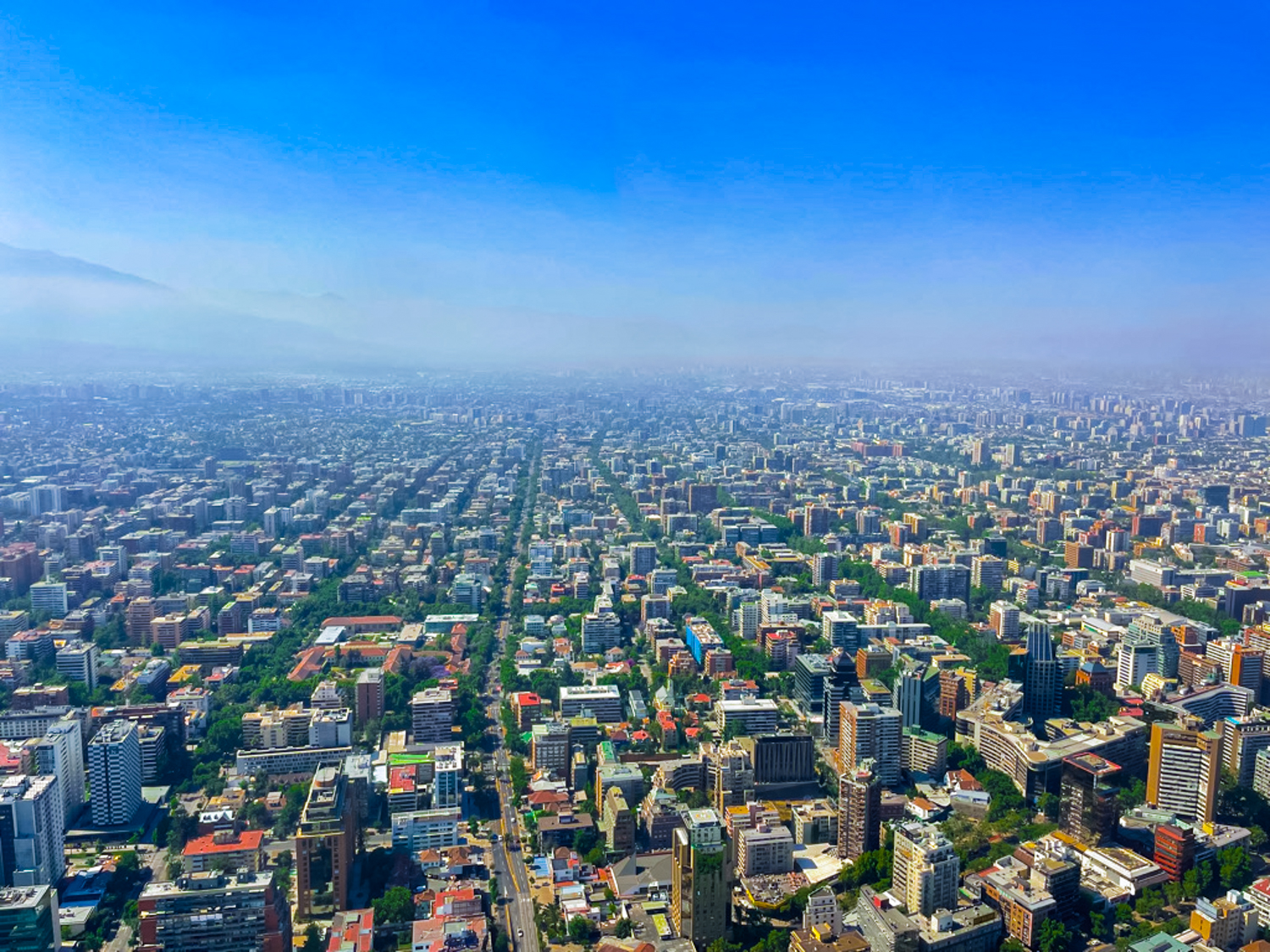
Long and narrow are two words that spring to mind when you think of Chile. Located along South America’s western edge, the Pacific follows the country down more than 6,000 kilometres of coastline.
We entered Chile overland from Bolivia after two fabulous nights touring the Uyuni Salt Flats. A land of varied climates and natural events, we thoroughly enjoyed our two weeks exploring the slender country of expansive desert, bustling cities and wine regions.
Our first stop? The Atacama Desert; a magical spot. From there, we made our way across to the coast, then downwards.
The eclectic scenery was one of the main things we loved about Chile – from biking through the Moon Valley and gazing up at the night sky in Vicuña to taking a local bus to the gloriously green Elqui Valley and the land of pisco.
As with the rest of our travels through South America, we got about by road, mostly using buses – they’re more like what we’d describe as coaches. Comfy, affordable and with reclining seats and air-con, they served us well. We mostly used Turbus and Pullman, with some offering a breakfast bag for overnight journeys.
Right, time to jump into our Chilean escapades.
After a tour-laden time in Bolivia, we were ready for a slightly more chilled time in Chile. We managed that balance well – still seeing tons and doing some excursions, but fewer multi-dayers.
Hot sunny days, sandy beaches, vibrant street art, beautiful landscapes and the opportunity to sample wine and an array of pisco sours describe our two weeks.
It’s also worth mentioning that we travelled to Chile in high season (December), bumping hotel costs up. Consider shoulder season (late September-November and March-May) as an alternative.
Same as my Bolivia budget guide , I’ll reference costs in US dollars (or the native currency), because most readers are from the States. The Chilean Peso (CLP) is the native currency – at the time of writing this, 1 USD is just under 900 CLPs.
And as always, just to confirm, I paid for everything myself, making this a comp- and press-free budget guide.
What’s Included in This Post
What does the budget breakdown you’re about to read cover? Places to stay, transportation, things to do, food, and miscellaneous costs.
Our time in Chile was fun yet relaxing, filled with an array of activities as well as downtime. We left wanting more which can only be a good sign. Continue reading for more details.
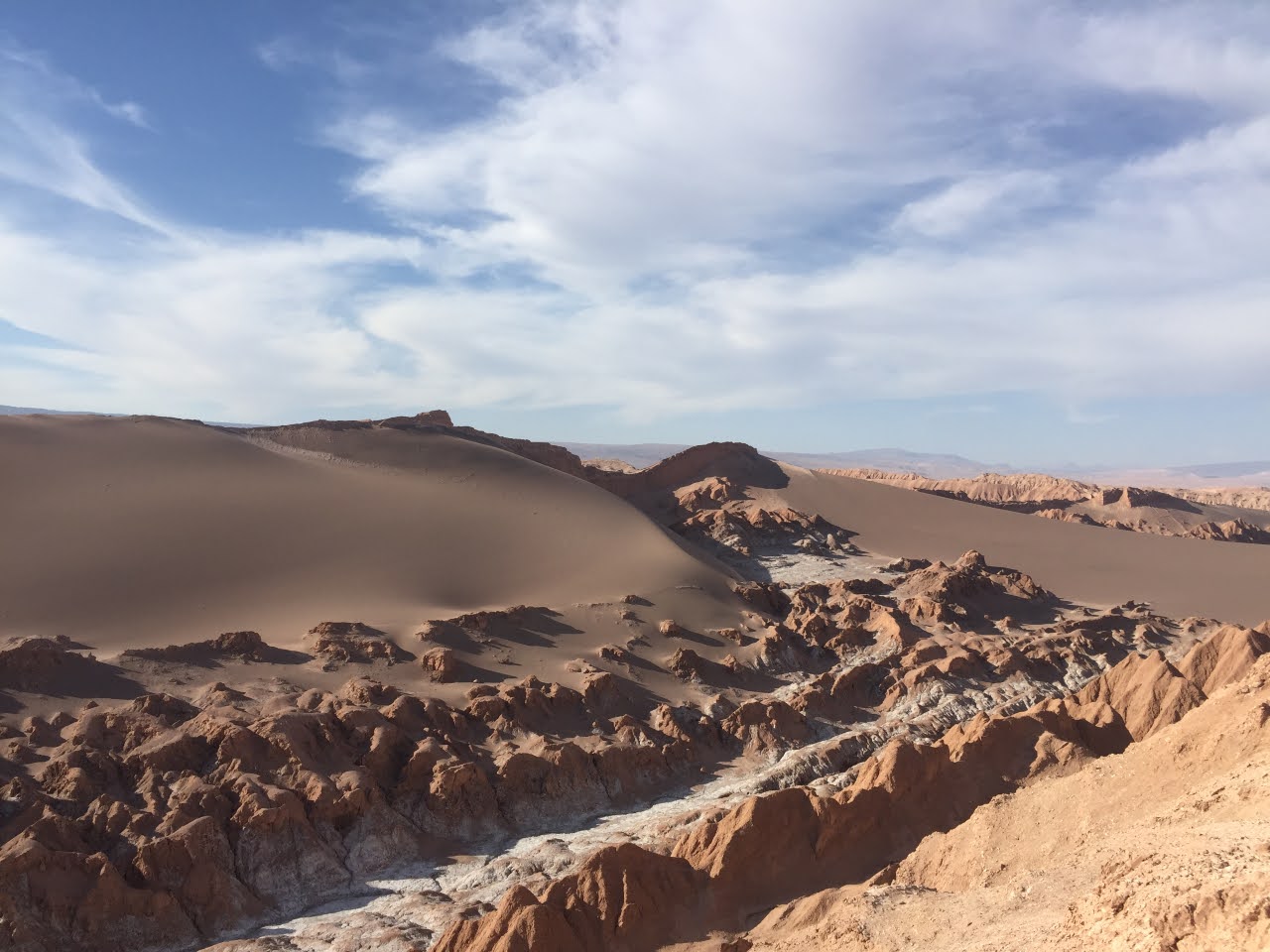
How to Save Money on the Cost of Accommodation in Chile
As always with travel, it’s possible to cut your accommodation costs down to zero if you have the time and patience to seek out an offer.
Housesitting is a great option for free accommodation. This is where you’ll take care of somebody’s house while they’re away, and usually look after their pets, too. It’s best for long-term travellers or retirees as you can’t pick and choose dates and destinations, so you need to have a lot of flexibility as to where you go and at what time of year. If you do have that freedom, it’s a wonderful way to cut down your travel expenses, soak up some home comforts, and live like a local for a while. I have friends who have housesat in castles before! For free! Trusted Housesitters is the best site for getting started with housesitting, as they have the highest number of listings.
I’m suspecting, though, that for most of you, you’re not interested in the free accommodation and just want somewhere clean, safe, and affordable to rest your head each night. If that’s the case, there are several options available for you.
And, of course, there are always hotels, which will usually come in at around $40-$100 a night for a decent, clean, mid-range property in a central location. I always use Booking , as they have the most accommodation options for the cheapest prices.
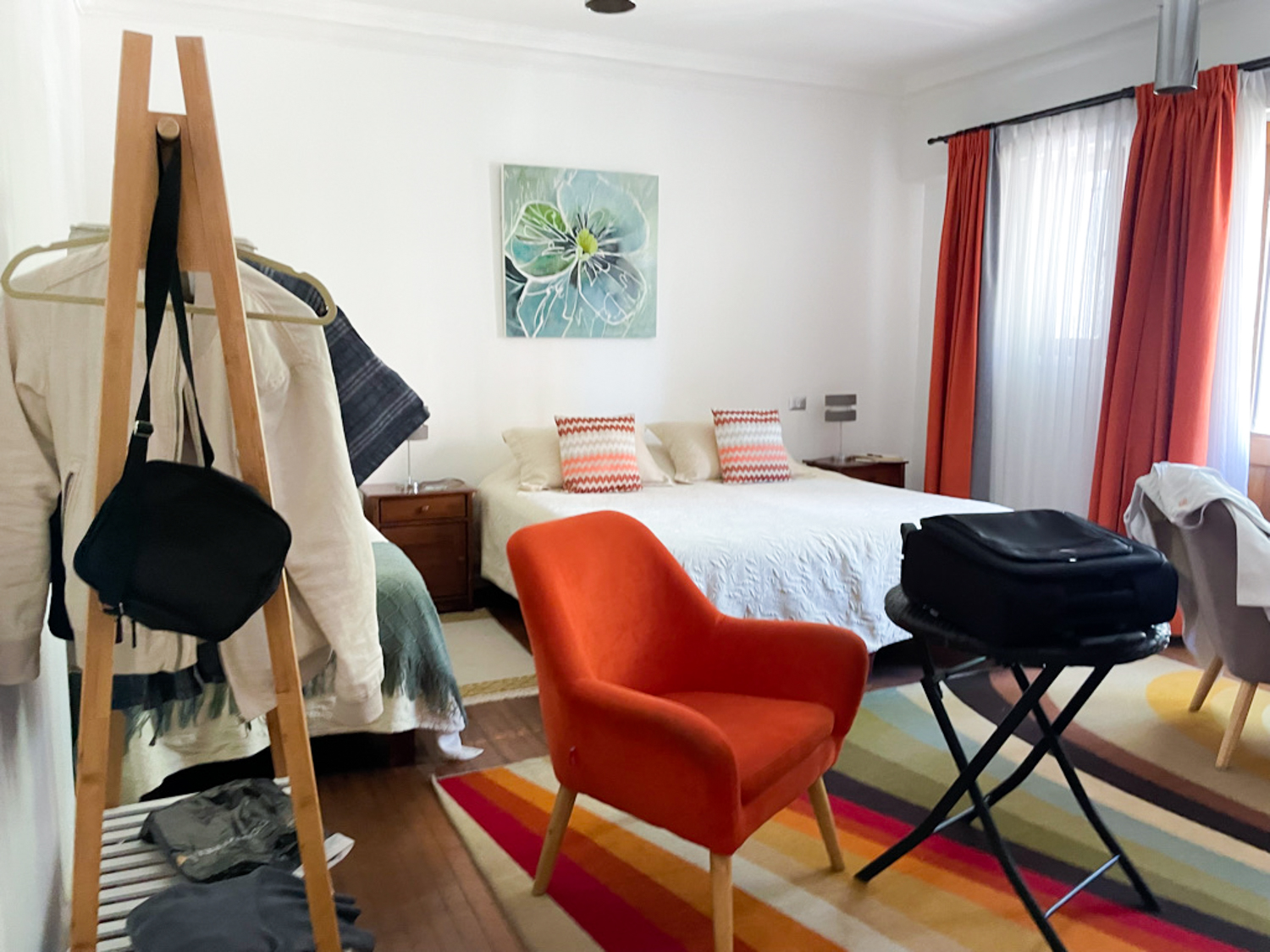
The Cost of Accommodation in Chile
As always, researching accommodation options paid off. Getting online and reading reviews served us well throughout our travels. We found some fab places to stay in Chile, from hotels and boutique hostels to cabanas. A tasty breakfast was included for the most part (always a bonus). Or, there was a kitchen for us to cheaply prepare our own.
So, here’s where we stayed in Chile:
Santiago: Safety in Santiago has, unfortunately, decreased post-protests-and-pandemic, so there aren’t as many neighbourhoods I’d recommend staying in. Providencia, however? It’s an oasis of safety and serenity — and I absolutely adored the guesthouse I chose to stay in. Casa La Barca is a wonderful property, with friendly staff, comfortable rooms, a gorgeous terrace, and one of the best breakfasts I had in the country. Located just a 10-minute walk from Barrio Italia, it was in a great location for exploring the city.
Valparaiso: We stayed at this contemporary Cerro Alegre apartment hotel with mountain views, a striking glass frontage, wood flooring, and a dinky balcony for admiring said vistas. Our super roomy space had a kitchen, sitting areas and high ceilings for a light and airy feel – we felt spoilt. Even more so when a first-rate breakfast was delivered to our room each morning. Centrally located a five-minute amble from Cerro Concepcion and with a host giving excellent restaurant recommendations, this was a real find.
San Pedro de Atacama: Located just a 10-minute walk from the centre of town and main plaza, this comfy and stylish hostel felt more like a guest house. Our spacious, colourful room was $71 per night and had a little sitting area, plus a table and chairs outside in the courtyard where we enjoyed a bottle of wine in the evening sun. An ample buffet breakfast, friendly staff, and free bikes rounded the picture off. The town of San Pedro de Atacama had a real tourist vibe to it, with terracotta buildings and mostly pedestrianised narrow roads. The varied surrounding landscape of desert, geysers, salt flats, volcanoes, and hot springs offered tours aplenty.
La Serena: This rustic colonial spot just a three-minute stroll from Plaza de Armas was coincidentally also $71 a night, and well worth it. A top breakfast buffet was included, our room was spotless, and amicable staff were on hand to answer questions. The stylishly decorated space featured wood floors, an outside area with garden and courtyard views, and a communal kitchen. We were just a half an hour walk from the beach and promenade, too. La Serena itself may not have had loads to offer in terms of things to do, but it was an excellent base for a trip to Mamalluca Observatory and Elqui. After a day trip one day to the latter, we changed our plans slightly and decided to go back and stay for a few nights to chill in the scenic valley.
Elqui Valley: We upped our budget to $91 a night for this peaceful lodge with a pool on the outskirts of Pisco Elqui. Charming, and again with lovely staff (there seems to be a theme), we were surrounded by lush greenery, mountain vistas and nature. This was our time to kick back, forget about wifi (it was patchy) and recharge. Offering a grocery delivery service, we were able to cook meals in our kitchen and didn’t need to leave the remote spot. Our spacious wooden chalet also boasted an alfresco terrace and a wood burner back indoors – not that we needed that.
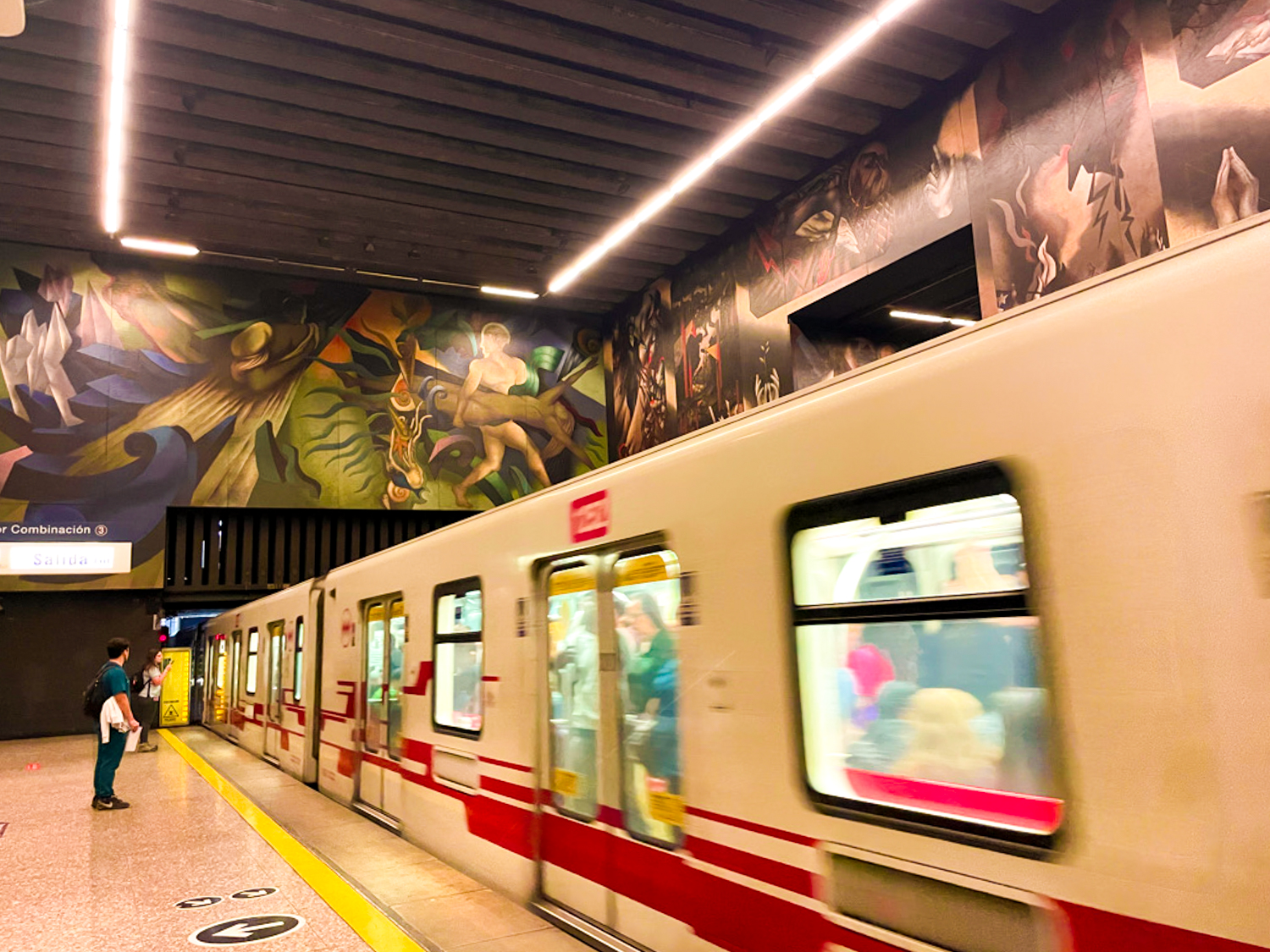
The Cost of Transportation in Chile
Generally, we got a rough idea of prices by searching online, and then went directly to the bus terminal a day or two in advance to purchase tickets. More often than not they were cheaper there.
We found travelling by bus easy, comfortable and super affordable – we’d definitely recommend.
Our journey breakdown goes like this:
- Overnight bus from San Pedro de Atacama to La Serena: 15,750 CLP / $20 per person
- Local (micro) bus from Coquimbo to La Serena: 500 CLP / $0.67 per person
- Return local bus from La Serena to Pisco Elqui x2: 12,000 CLP / $16 per person. The reason we did that return journey twice: once for the day trip and again when we stayed in the valley. We got ourselves back to La Serena as that was easier for onward travel to Valparaiso.
- Bus from La Serena to Valparaiso: 9,000 CLP / $12 per person
- Return local (micro) bus from Valparaiso to Viña del Mar: 1,500 CLP / $2 per person
- Bus from Valparaiso to Santiago: 2,250 CLP / $3 per person
OUR TOTAL COST OF TRANSPORTATION IN CHILE CAME TO $107.34. THAT’S AN AVERAGE OF $8.26 PER DAY, OR $4.15 EACH.
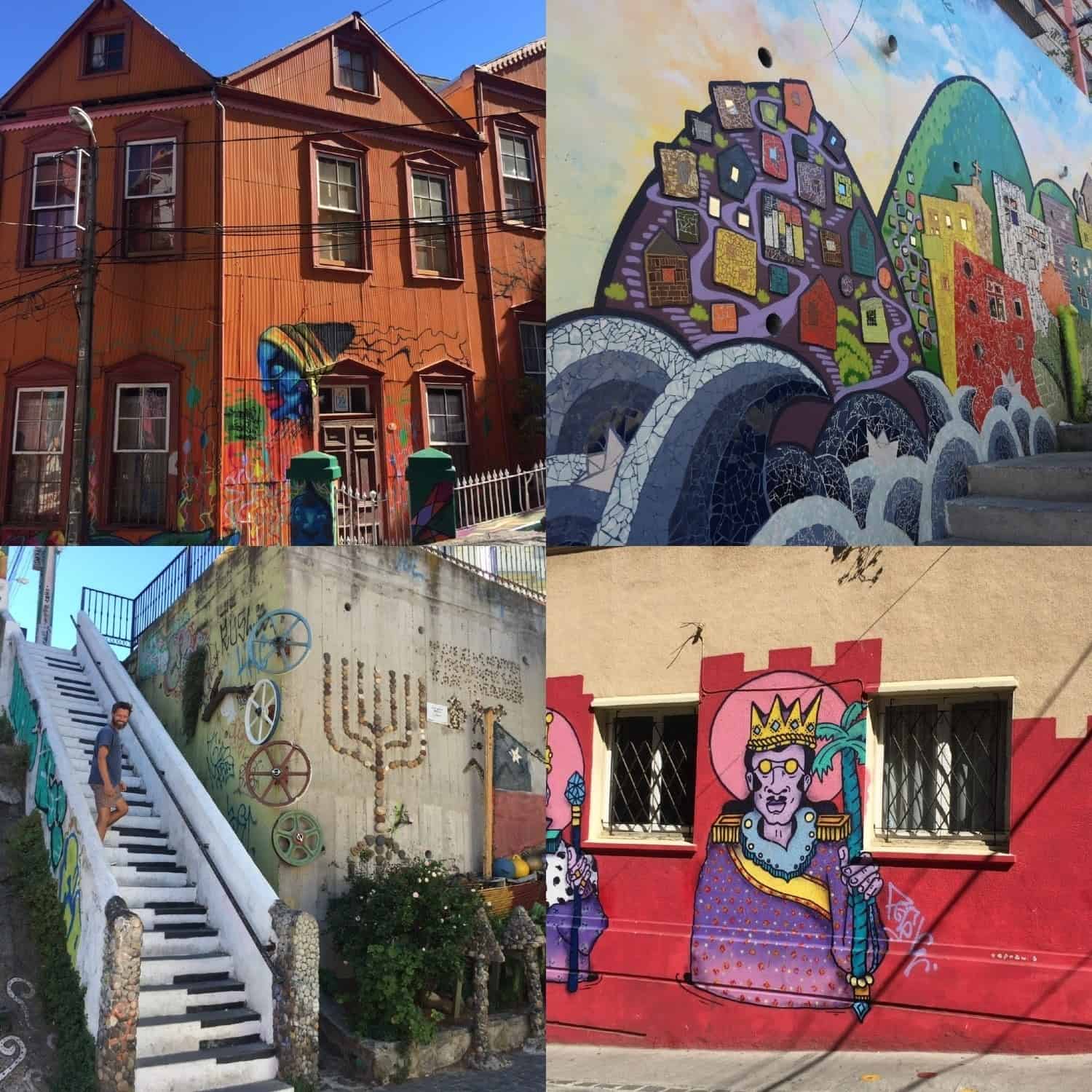
THE COST OF ACTIVITIES AND ENTRANCE FEES IN CHILE
Desert, wine regions, starry skies, verdant valleys and the towering Andes – what an amazing mixture of landscapes. Each place we went, we enjoyed some fantastic activities, from relaxing to energetic.
Carry on reading for a rundown:
Valle de Luna (Moon Valley) entrance fee, San Pedro de Atacama: 3,000 CLP / $4 per person . We used the free cycles from our hostel to bike out and self-guide to this otherworldly landscape of dunes, salt caves, craggy mountains and distinctive rock formations. We took a packed lunch and spent the day there, admiring the spectacular scenery. Tip: if you stay for sunset (which we did), be sure to leave before it gets dark (or make sure you have proper bike lights). We left it a bit late: there was no road lighting, which made for a slightly hairy ride back.
Pisco Mistral Distillery tour , Elqui Valley: 6,500 CLP / $8.50 per person. A picturesque place, super interesting, with tastings. If you fancy pushing the boat out a bit, the garden was a pretty spot for lunch or a drink.
Mamalluca Observatory night tour , La Serena: 25,000 CLP / $33.33 per person. This included transport to and from La Serena and a guided observation. We spend an incredibly interesting few hours looking up at stars and planets. And, we got to take home amazing pics of the moon, taken from my iPhone up against the lens of the telescope. We’d planned a stargazing tour in San Pedro de Atacama, but unusually, the night we were due to go was cloudy, so it didn’t go ahead. We were so pleased we got another chance.
Museum of Memory and Human Rights , Santiago: 2,000 CLP / $2.50 per person for an English audio guide (recommended). Entrance was free. An enlightening and harrowing insight into Pinochet’s 17-year rule.
Teleférico to San Cristóbal , Santiago: 2,850 CLP / $4 per person return (more on weekends). Enjoy fab views of downtown Santiago from this vantage point.
The Little Wine Bus Maipo Valley tour , Santiago: $97 per person. A fun and affordable way to see the wine region, with a guide, breakfast, lunch, plenty of wine and return transport. Perhaps not for serious wine connoisseurs, but nevertheless an excellent day.
And don’t forget these free activities, too:
Walking along the beach at La Serena to the small beach town of Coquimbo. Keep an eye out for the sea lions – we saw a huge one. The walk was quite long (around 2 hours), so we bussed it back.
Beach chill time at Viña del Mar (a short bus ride from Valparaiso).
Wander the hilly streets of Valparaiso taking in the varied street art. We loved exploring the steep walkways and hilltop viewpoints.
OUR TOTAL COST OF ACTIVITIES IN CHILE CAME TO $298.67. THAT’S AN AVERAGE OF $22.98 PER DAY, OR $11.49 EACH.
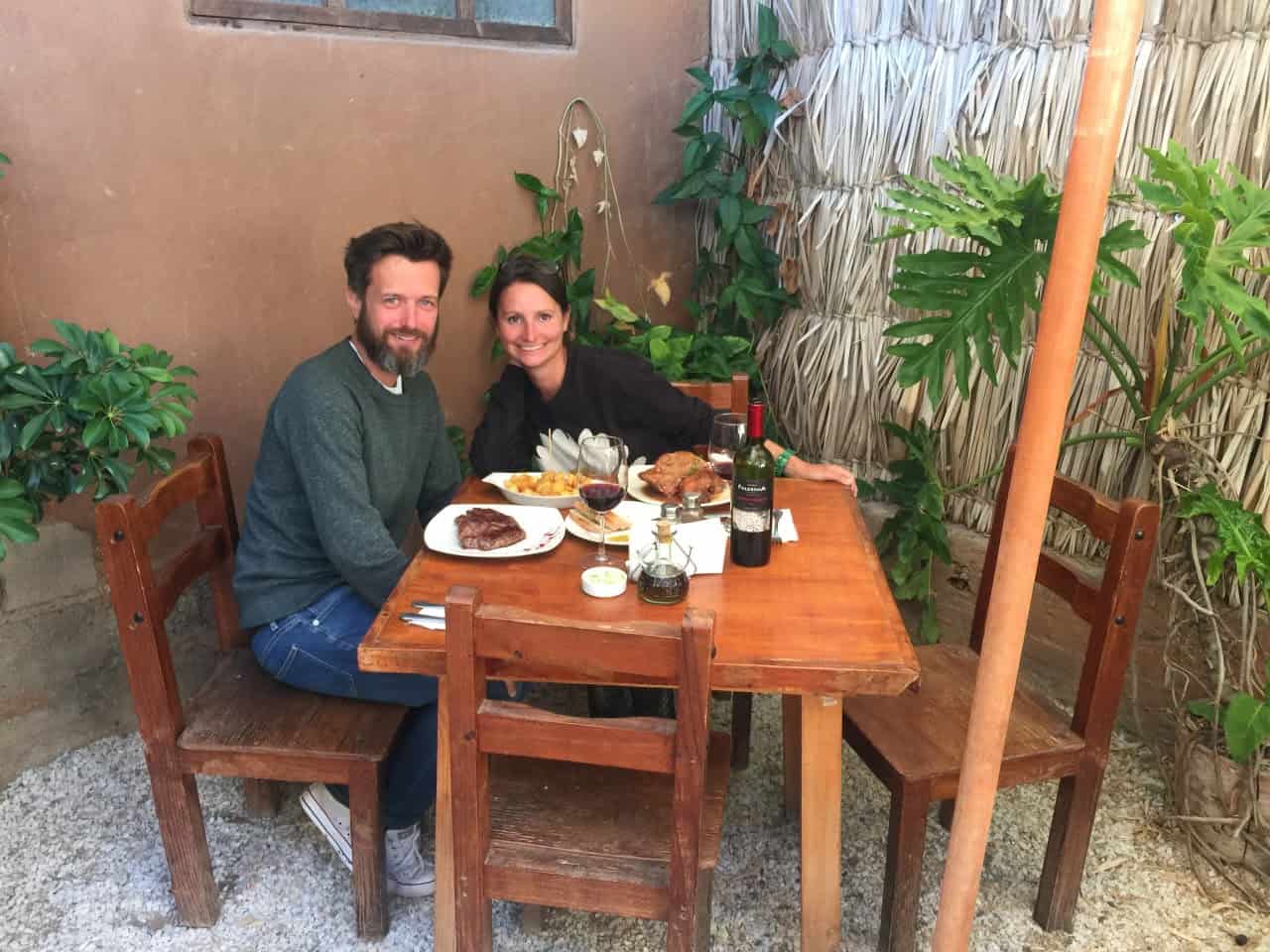
THE COST OF FOOD IN CHILE
With excellent breakfasts included at most places we stayed or else a communal kitchen for whipping something up, we spent virtually nothing on the first meal of the day.
Food lovers that we are, we don’t go anywhere without trying regional dishes. Two we devoured time and again in Chile for lunch were:
Completo hot dog: Spanish for complete or total, these were sold everywhere, from street food vendors to bars. Definitely not the most healthy, but filling and budget-friendly ($2-3), they were loaded with smashed avocado, onion, diced tomato, sauerkraut, and tons of mayo. Almost too much – and I’m a mayonnaise fan. There was also an Italiano version without the sauerkraut and onion. Messy but tasty.
Empanadas: We love a filled pastry snack, so we were in our element. Fillings ranged from ‘pino’ (minced beef, onion, raisins, hard-boiled egg and olives) and cheese to prawn. Prices varied quite a bit, from $0.75 to $2.50. Yummy and satisfying.
We sometimes ate these for dinner, too. Otherwise, something local at a casual eatery. Fish was big in Chile, with dishes such as seafood soup (sopa de mariscos) very popular. We typically spent $5-$10 per person on dinner.
Average daily food cost: $11.69 per day, or $5.85 each
We drank plenty of water and beer, sampled some Chilean wine and had plenty of piscos sours! The Chilean variety differed from the Peruvian version – no egg white was used. My fave was a pineapple version in the Elqui Valley at El Durmiente Elquino.
Litre bottles of aqua were around a dollar, beers were $2-3 a pop (cheaper if we bought them from a supermarket), pisco sours ranged from $4-$6, and wine very much varied depending on where we bought it.
Must-try? Dive bar La Piojera in Santiago, where we’d read about an interesting-sounding drink called Terremoto (earthquake). At 3,000 CLP ($4) each, it consisted of fermented sweet white wine called Pipeño, pineapple ice-cream, and either grenadine or fernet (a herbal, aromatic spirit). An interesting combo to say the least. The bar had a great atmosphere, we chatted to locals, and left a few sheets to the wind.
Average daily drink cost: $18 per day, or $9.00 each
OUR TOTAL COST OF FOOD AND DRINK IN CHILE CAME TO $173. THAT’S AN AVERAGE OF $29.69 PER DAY, OR $14.86 EACH.
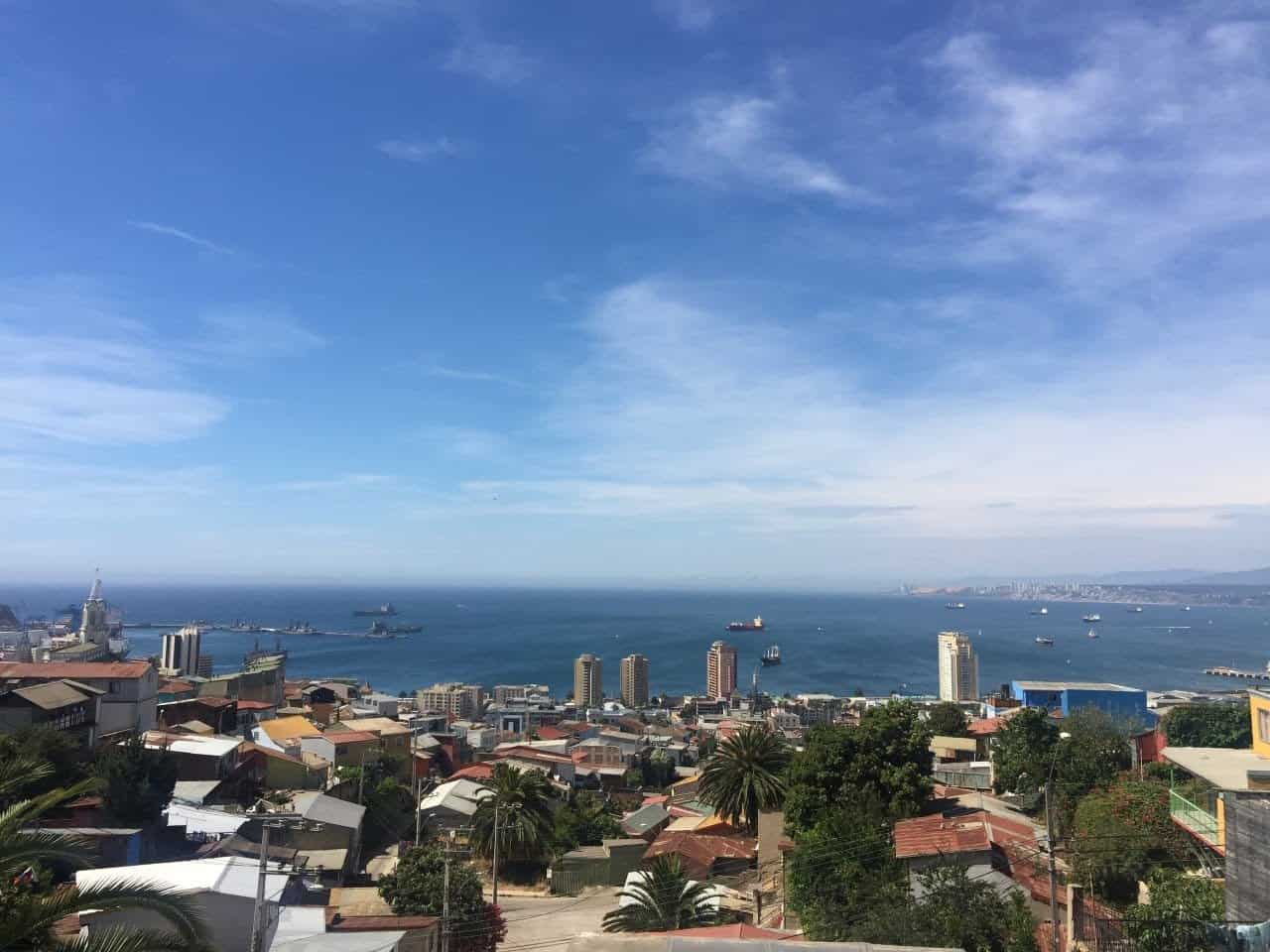
The Importance of Travel Insurance in C hile
And finally, I’m a firm believer that if you can’t afford travel insurance , you can’t afford to travel, and this holds true for every country in the world.
Travel insurance will offer compensation if your flight gets cancelled, pay for you to replace your lost luggage, cover your medical bills if you get break a leg while hiking in Patagonia, and ensure you don’t face any emergency travel costs to get back home for a family emergency. Nobody likes to think about things going wrong on their trips, but travel insurance is a must in order to ensure you’re not out tens of thousands of dollars if the worst case scenario comes true.
I use and recommend SafetyWing travel insurance for visitors to Chile. Firstly, they’re one of the few companies out there who will actually cover you if you contract COVID-19. On top of that, they provide worldwide coverage, don’t require you to have a return ticket, and even allow you to buy coverage after you’ve left home. If you’re on a long-term trip, you can pay monthly instead of up-front, and can cancel at any time. Finally, they’re cheaper than the competition, and have a clear, easy-to-understand pricing structure, which is always appreciated.
For a two weeker in Chile, you’ll spend $1.50 a day on insurance.
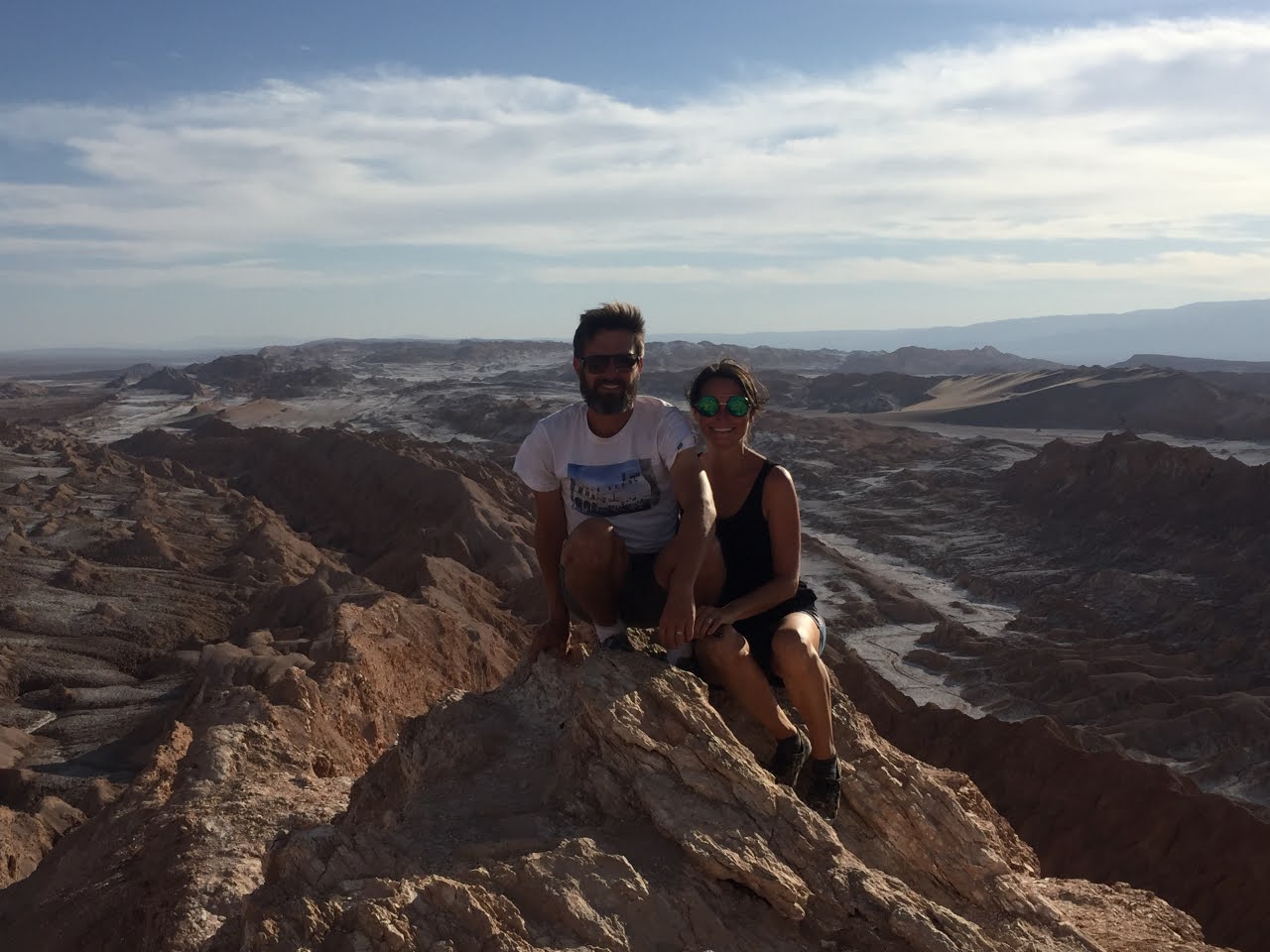
HOW MUCH DOES IT COST TO TRAVEL IN CHILE?
Our daily spends per person:
- Accommodation: $39.60 per day
- Transport: $4.15 per day
- Activities: $11.49 per day
- Food and drink: $14.86 per day
- Miscellaneous: $1.50 per day
Grand total spent in Chile: $71.60 per person per day .
As we left the capital city of Santiago and headed east on a scenic bus journey into Argentina, we added Chile to our list of countries to revisit. The scenery we experienced was spectacular, and we knew there was still more to see…
HOW MUCH DID YOU THINK IT WOULD COST TO TRAVEL AROUND CHILE?
Lauren juliff.
Lauren Juliff is a published author and travel expert who founded Never Ending Footsteps in 2011. She has spent over 12 years travelling the world, sharing in-depth advice from more than 100 countries across six continents. Lauren's travel advice has been featured in publications like the BBC, Wall Street Journal, USA Today, and Cosmopolitan, and her work is read by 200,000 readers each month. Her travel memoir can be found in bookstores across the planet.
Related Posts

The Cost of Travel in Mauritius: My Detailed Budget Breakdown

The Cost of Travel in Thailand: My Detailed Budget Breakdown
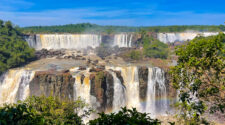
The Ultimate Guide to Iguazu Falls: Argentina and Brazil

2023: My Travels in Review

The Cost of Travel in South Korea: My 2024 Budget Breakdown
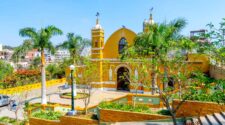
23 Fantastic Things to Do in Lima, Peru
Awesome guide. Hopefully planning on seeing Chile soon.. thought it might cost too much, as it has a reputation for being the most expensive place in Latin America, but it doesn’t seem so bad from your figures.
Thanks for this incredibly useful article! I am planning my next adventure to Argentina, Chile, and Peru and your breakdowns have been so helpful. You need to put one together for Argentina! Anyway, I was wondering how difficult it is to get to the southern reaches of Chile? Obviously we could fly there, but that would be quite expensive, and then the buses would take so long. But is it worth it? I don’t want to miss out on Patagonia! But also, with limited time, I don’t want to spend all of it travelling. What do you think? Save the south of Chile for another trip or make the effort to get down there?
This is such a useful look at your money spent! I’m not surprised that Patagonia is a more expensive place to visit, but I’m sure the views were worth the extra spent!
Another fantastic budget breakdown, Lauren! I’m going to be spending the next three months trekking through Chile and this really helped to give me an accurate picture of how much things are going to cost while I’m there.
Leave a reply Cancel reply
Your email address will not be published. Required fields are marked *
Meet Lauren Juliff
Subscribe & get your free guide to going abroad!!
A Complete Guide to Santiago Chile for Travelers and Nomads
For nomads and travelers wandering South America, it’s part of the goal of travel to explore and experience all of the highlights and significant locations on the continent. As you research where to go and what to do in South America, it’s impossible to miss the potential stop of Chile’s capital of Santiago de Chile.
Compared to its sister city capitals in Latin America, Santiago de Chile is a modern, developed city with great infrastructure, an equally rich restaurant scene which leans towards diverse international cuisine over local cuisine, and seemingly malls and shopping centers, which make it a great place for living every day life. Within a couple hours’ ride, rich outdoor experiences await. Out of the windows of many Santiago homes you can see the ridgeline of the towering Andes, and the tallest mountains outside of Asia. With that kind of beautiful terrain come opportunities to hike, bike, whitewater raft, and explore the outdoors by summer, and ski or snowboard epic lines through snow by winter – from Mountain Aconcagua (the tallest mountain outside of Asia), to the Andean mountain range, to the Casablanca Valley wine country, to epic Patagonia.
However, you won’t find strong “indigenous culture” in Santiago beyond the museums and the whole of the cities architecture, views, and vibe feel more European than Latin American, and it can be hard to find anything that is more “authentic” over “modern” the quality of life in Santiago is very high. The cost of living is admittedly high compared to other Latin America cities (nearly double). Last, though there are countless restaurants, you’ll struggle to find any that you won’t find better (and cheaper) in Peru and Colombia.
So, why go to Santiago? To rest between, enjoy modern comforts, and proceed to one of a kind outdoor experiences.
Ultimately Santiago is a comfortably modern capital that can be pricey and seemingly over commercial for what one typically expects from South America, but exists as an efficient gateway to some of the world’s most beautiful places and a place to rest between experiences.
Nomads will enjoy easy access to tech and major brands, strong internet, and good infrastructure.
Travelers may enjoy the chance to have some posh cocktails in cool cafes and good food (fast food and international food) before stocking up on outdoor gear and proceeding to the lake districts in Patagonia
Over the past four months, I’ve wandered Argentina and Chile as a traveler and nomad hunting out the best places to see, experience, work, and relax. With the excitement of beautiful Argentina, specifically Buenos Aires and Mendoza, in the rear view mirror, I wanted to explore and map out new potential destinations for nomads to live and work between adventures – and the modern and shiny Santiago de Chile is a great potential place to stop, work, and recover.
Over the past month I’ve wandered Santiago’s many streets, neighborhoods, parks, markets, malls, and museums to scout out first hand everything you need to know to quickly settle into the city, and where to plan to go next to maximize your time in Chile.
Read on to learn how to make the most of your time to enjoy, work, and explore in Santiago de Chile.
- Why Santiago: Outdoor adventures and modern infrastructure
Central Santiago
Bellavista, patronato, and recoletta, bellas artes and lastarria.
- Barrio Italia
- Barrio Brasil + Barrio Yungay
Providencia and Las Condes
Other barrios to know in santiago, wine regions near santiago available for tours, essential sights to see in santiago, where to stay.
- Where to Eat and Drink
Santiago Cost of Living: Much higher than most of Latin America
Getting around: metro, uber, and cabify, where next in chile after santiago.
- Cheap flights to South America through Santiago airport
- Other Recommendations Instead of Santiago
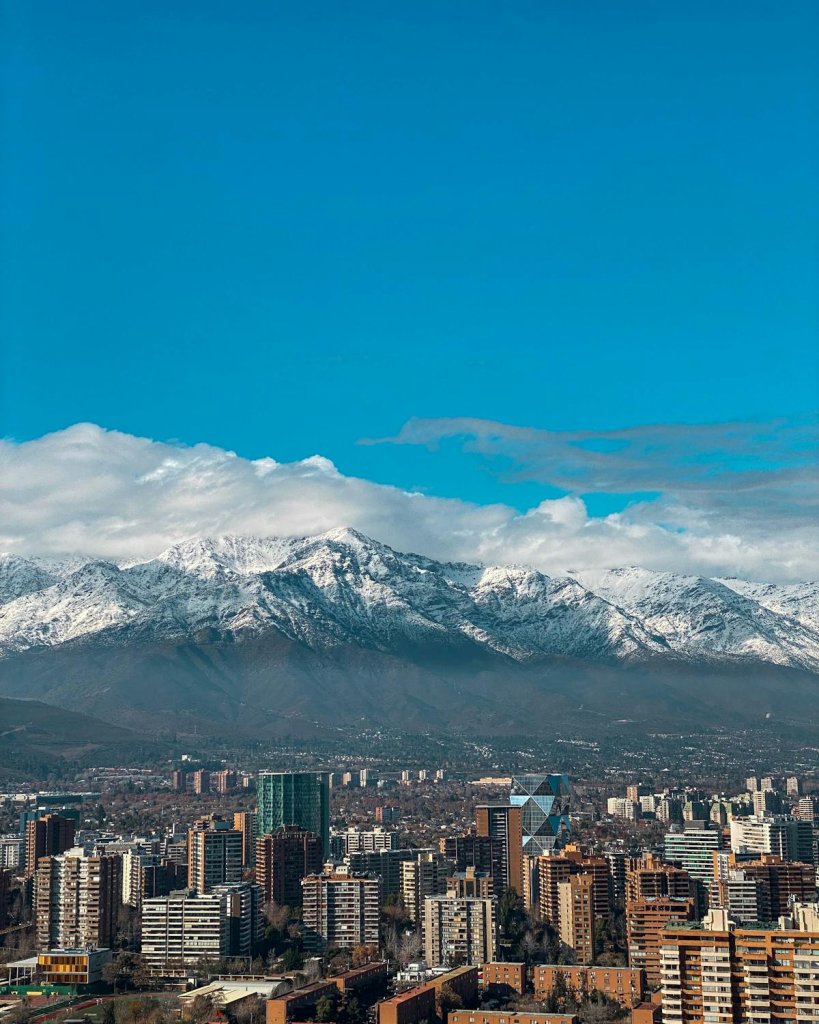
Why Santiago, Chile: Outdoor adventures for travelers, and great, modern infrastructure for Nomads and Remote Workers
As a result of earthquakes, military dictatorships, a campaign for free markets, capitalism, and modernity, and a strategic cleansing of arts and culture**, Santiago feels less “Latin American” than any capital south of the United States. Combined with the high cost of living, Santiago doesn’t deliver the charm and experience to warrant more than 3 days in Santiago as a traveler, in tradeoff for less time anywhere else in South America.
However, Santiago is a gateway to some beautiful cities (like Valpariaso) and outdoor experiences (like Torres del Paine) that aren’t to be missed. Travelers considering Chile for the outdoor adventures may consider traveling south on the Argentine side to Bariloche, to save money on equally beautiful scenery.
Nomads and Remote workers on extended trips in South America may consider Santiago for focused work in a place with strong internet and good, modern infrastructure.
Highlight notes on why Chile (and why not Chile)
- Santiago is a big, modern city. Thanks to earthquakes, older, historical buildings have been destroyed and replaced with modern (earthquake resistant) buildings and architecture, so architecture feels more like downtown Los Angeles than Latin America. This makes Santiago one of the less interesting Latin America capitals from a travel and exploration standpoint. You can visit most of Santiago’s highlights in just two days.
- With the Santiago’s modernity comes very good Infrastructure, such as fast internet, well maintained roads and public streets, and large, flashy shopping centers. This modernity, that many places in South America lack, makes Santiago a solid option for focused remote work.
- Chile’s position, sandwiched between 4000 miles of coast line and the Andean mountain range, and ending in Patagonia make the country a paradise for adventure sports – hiking, trekking, mountain biking, and more. What Santiago lacks in uniqueness, it makes up for in outdoor adventures.
- Though coworking spaces exist, work-in café culture is much rare in Chile than Argentina and Colombia. You will find cafes less amenable to such, so plan backup options for where/how to work.
- Due to Chile’s location, tourists rarely pass through Chile on the way to anywhere else, besides Patagonia and the outdoors. As a result, foreigners are a general rarity (other than economic migrants from neighboring countries) so white, Asian, or black people may get curious (yet benign) looks outside of Santiago’s capital
- Santiago airport is one of the cheapest South America hubs to fly into, even if you are flying into Buenos Aires or Rio, and especially if you are trying to access remote locations ( learn more about flight hacking through Santiago here )
Santiago de Chile Nomad Scene: Not as strong as in other places in Latin America
Despite the amazing infrastructure in Santiago, and the very interesting program of Startup Chile , the foreign digital nomad scene in Santiago is emerging at best at the moment. Compared to hubs such as Buenos Aires and Medellin**, there is barely a sign of a digital nomad scene in Santiago and Chile as a whole at the moment. As such, don’t expect much nomad friendly infrastructure (co-working, co-living, work friendly cafes) beyond what you would find in a normal big city.
The most robust place to connect with other nomads and remote workers is the Chile Digital Nomads & Remote Workers Facebook group . Though it is a helpful group, the community’s small size reflects the size and activeness of the nomad community in Chile.
For co-working near home, be sure to stay in Central Santiago as most of the coworking space options are in Bellas Artes or near Barrio Italia.
Cowork Options
Co-Work Latam Monjitas
Co-Work Latam Bellet
- https://maps.app.goo.gl/bNWuEUsLAdy5hjeM9
- Startup Chile’s Coworking Space
LAUNCH Coworking Holley
- https://maps.app.goo.gl/kZyNbgZuhE6EDbzY6
Hub Providencia
- https://maps.app.goo.gl/Eg1Tn8kfrxytfnpJ9
- Next to super chic Barrio Italia
Neighborhoods: Where to stay, where to eat, where to shop, and where to work
Santiago as a whole is generally very safe and modern, but understanding the different neighborhoods of the city will help you better pick where to stay and explore.
Central Santiago is the busiest district of Santiago and contains a few of our choice neighborhoods. Central Santiago is bordered by the Autopista Central, Rio Mapoche, and Almeda. Generally in this area, you will find lots of fast food restaurants (shawarmas, arepas, and standard food chains), government offices, and the banking district.
This area is home to the Mercado Central (great for seafood), National History Museum, Pre-Colombian Chilean Art Museum, Centro Cultural La Moneda, the active on weekends Plaza de Armas and a fun pedestrian street, and the Chilean National Library.
Bellavista and Patronato hug the hikable San Cristobal, are home to Pablo Naruda’s once home and now museum La Chascona**, and some of the best nightlife in Santiago. If you want to stay up until the early AM, come here. Also, if you craving Korean or Arabian cuisine visit El Patronato neighborhood within Recolleta.
In the eastern portion of Central Santiago, Bellas Artes and Lastarria are sandwiched between the very cool Cerro Santa Lucia park, and Parque Forestal as well as the Museo Nacional de Bellas Artes. Within a few blocks you will also find the Museum of Visual Arts and Gabriela Mistral Cultural Center (theater).
Barrio Italia: The coolest neighborhood in Santiago
Barrio Italia is a cool strip of streets in Santiago’s coolest neighborhood. Restored buildings and warehouses are now home to chic art shops, markets, breweries, and upscale cafes. On Sundays, you’ll find all of Santiago here. Weekdays, when everyone is at work, this neighborhood will your best place to find a coffee shop.
Barrio Italia is very much similar to the Palermo neighborhood of Buenos Aires
Keep in mind you’ll find some of the best cafes and upscale casual eating in Santiago here, but you will also find the priciest meals as well
Barrio Brasil + Barrio Yungay: Historic buildings and an authentic feel
Though you shouldn’t necessarily stay here, you should absolutely visit, to soak up some less modern and more authentic culture. While most of Santiago has undergone a modern facelift, these two barrios will give a very authentic feel. Just don’t hang around after dark.
The Beverly Hills of Santiago. This area, filled with all glass and extremely modern housing and well manicured green spaces is the most upscale part of Santiago. Here you’ll find the best (and most expensive) restaurants in Santiago as well as several shopping malls, such as Parque Arauco and Alto Las Condes.
- Barrio Recoleta **
- Independecia **
- Casablanca Valley **
- Maipo Valley **
- Colchagua Valley **
- Aconcagua Valley **
General: Most sights in Chile are plazas, buildings, museums, and neighborhoods
- Mercado Central: Santiago’s fish market and your best bet for good, cheap ceviche
- Mercado Tirso de Molina: Across the autopista from fish heavy mercado central, this market delivers a veggie market downstairs, and authentic food stalls from all over Latin America upstairs
- La Vega Central de Santiago: Next to Mercado Tirso de Molina, this is Santiago’s main (and massive) vegetable market
- Londres 38: A historical building and current museum formerly used as detention and torture center for opponents of the Augusto Pinochet dictatorship
- Museum of Memory and Human Rights
- Plaza de Armas (on a weekend): Large, beautiful, historic plaza adjacent to the National History Museum and the Metropolitan Cathedral of Santiago
- Barrio Italia: The walkable streets of Avenida Italia, Girardi, and Condell are lined with cool cafes, chic shops, breweries, and restaurant, with some really cool restored architecture vibes
- La Chascona: The preserved home and now museum of poet and activist-writer Pablo Naruda
- Cerro San Cristobal: The seemingly towering hill overlooking Central Santiago, accessible by hiking trail and cable car
- Cerro Sant Lucia and Hidalgo Castle: A pleasant park built on a hill adjacent to Lastarria, with a centerpiece of a castle built as a defense point for the city during the Chilean war for independence
Other Significant Sights and Museums in Santiago
- Biblioteca Nacional de Chile
- Catedral Metropolitana: Towering, decadent, and adjacent to Plaza de Armas
- Centro Cultural Palacio La Moneda: A world class arts exhibition center
- Museo Chileno de Arte Precolombiano
- Museo de Arte Contemporareono
- Museo de Artes Visuales
- Museo de Historico Nacional
- Museo Nacional de Bellas Artes
- Museo Violeta Parra
Lastarria neighborhood will offer the cheapest AirBnB options that are accessible to everywhere in the city, while maintaining a decent budget. The neighborhood has a very “downtown, municipal” vibe with high rises, large apartment complexes, and plenty of AirBnB options
Barrio Italia is a great, walkable option with a more bohemian, residential feel, without the high rises and large apartment complexes. A handful of AirBnBs nearby may work, but a nice hostel is your best (and coziest) bet.
Providencia and Las Condes offer great upscale hotels and nice apartments on AirBnB, with the shopping and amenities that come from being in the Beverly Hills of Santiago.
Where to Eat
Santiago suffers from an interesting problem in that, while Santiago is home to some amazing restaurants, not much of the food is actually Chilean. Go in with that in mind, and you will find some tasty eats.
Additionally, because most of the food in Santiago you’ll find is foreign – Shawarma, Chinese, Indian, Colombian, Venezuelan, etc. – don’t expect the foodie experience that you may get in Lima, Peru or with beef in Argentina. Just understand the food will be objectively good, not necessarily Chilean, and (likely) expensive for Latin America.
Great Restaurants around Santiago
- La Diana **
- Salvador Cocina y Café **
- Peumayen Ancestral Food : Amazing Chilean food
- Chipe Libre : Awesome ceviche and pisco (local liquor) tastings
- Bocanariz : Restaurant and wine Bar
- El Diablito : Beer and chorillana
- Le Tacón Tangobar & Bistró : Bar and Resto
- Café Mosqueto : Good Coffee
Be warned that the cost of living in Chile is much higher than in the rest of South America, and even higher in Chile. However, if you are mindful of your budget and how you spend, you can avoid breaking the bank.
My research on cost of living by city puts the monthly cost of living in Santiago for an ex-pat at $1, 947 per month, and estimates monthly cost of living for nomads and slow travelers passing through at $2,433 to $2,920 per month.
My budget and spending experience in Santiago, Chile
As an anecdote, I nearly paid $11 for a simple plat of French fries in Barrio Italia over the weekend. On the other hand, an Uber across town (25 minutes away) was ~$6.50 and a basic movie ticket was $7. A coffee at Starbucks is $4.50 and a coffee at a normal coffee shop is $3 to $4.
Here are more costs from my trip.
- Cheap, fast food (shawarmas, arepas, burgers) cost between $6.50 and $10.
- Ceviche costs between $11 and $18 (in Barrio Italia).
- A beer or pisco sour at a bar will cost $4 to $7.
- My studio AirBnB in Lastarria is $1090 for the month
- A day long wine tour to the Casablanca Vally will cost $190
- A wine train and tasting to a nearby city will cost $60 round trip
Metro: Quick, cheap, reliable
Santiago’s well developed and maintained metro make the underground rail the best, most convenient, and most economical way to get around the city. Compared to rideshare via Uber and Cabify, including wait times, traveling by metro is almost just as fast, especially during rush hour.
To ride, simply head to the information kiosk (within the metro) and purchase a “BIP” card for 1,500 CLP. Rides will cost ~300 CLP per ride.
Use the directions with public transportation function** in Google Maps to get accurate routes and times around
Rideshare: Uber, Cabify
Rideshare is the best, quick way to get around the capital. For rides in Chile, I waited on average ~5 minutes for a ride to book, and paid between ~2,500 CLP and 7,000 CLP for rides
Where you should travel after Santiago depends largely on where you came from before Santiago, and what your interests are.
- Valparaiso, Chile **
- Patagonia: Puerto Montt 🡪 Bariloche **
- Mendoza, Argentina **
Valparaiso, Chile
The port city and former financial center of Valparaiso 2 hours north of Santiago is the arguably more charming and enjoyable little sister to Santiago. This port city, known for its now artistic and Bohemian vibes, has a character more uniquely Chilean with lots to explore.
If your follow on travels don’t include Patagonia or Argentina, make your next stop Valparaiso**
To get to Valparaiso from Santiago**, there are several private buses available from the main bus terminals for the 2 hour ride. Recorrido.Cl ** is the best place to check those schedules. Additionally, you can check Rome2Rio for other options
Exploring Patagonia from the Chilean side: Puerto Montt 🡪 Bariloche
Patagonia is one of the most beautiful experiences in South America. If you plan to explore Volcanoes, fjords, the Tierra del Fuego (Land of Fire), and Torres del Paine National park, you will need to head south. From Santiago, either make your first stop Puerto Montt (or prettier Puerto Varas 20 minutes away).
For the 12 hour ride from Santiago to Puerto Montt, the best option is to travel by uber comfy “Salon Cama” seats by bus that lie flat. You can check buses and book through Recorrdio.Cl .
Mendoza, Argentina
For travelers that plan to explore Argentina next, consider hopping straight of the border, and the Andes, to the wine country of Mendoza, Argentina . Not only is Mendoza an excellent wine experience , the city is also on the Argentine path into Patagonia, with direct buses to Bariloche, and south to El Chalten, El Calafate, and Ushuaiia.
Read our full article sharing why “ Mendoza is a great underrated stop for your itinerary ”.
Cheap flights to South America through Santiago airport: A hidden perk to traveling Chile
One hidden perk of Santiago being so developed with fairly low import taxes are the cheap flights.
Santiago is an amazingly cheap airport in South America, given its remoteness and what is accessible around. When flying into Argentina, I often find it cheaper to fly into Santiago then to Buenos Aires, and the same for any of the surrounding cities. Much the same as Lima, Bogota, and Rio.
So, if you do need to book a cheap flight into South America, consider flying into Santiago, Chile, and hopping onward from there.
Click here to learn more about how to fly cheaply throughout South America using Santiago airport
Other Recommendations Instead of Chile
Whether the explanations here have deterred you, or you arrived and feel like Santiago de Chile just isn’t what you’re looking for, consider hopping to either of these cities instead.
However, if you haven’t arrived in Santiago yet, consider adding more time into your itinerary for one of these cities instead.
Great alternatives to Santiago de Chile:
- Valparaiso, Chile: Charming, artful, and surrounded by some beautiful beaches, enroute to more beautiful places in Chile **
- Cusco: Arguably one of the most authentic big cities in South America that bleeds culture and has an amazing local food scene as well as many beautiful sites and archeological digs nearby. A perfect place for rest and recovery **
- Buenos Aires: Big, safe city to soak up a unique combination of Latin American and Italian/Spanish vibes against a wonderfully social backdrop**
- Medellin : Just as refined as Santiago, magnitudes more vibrant and uniquely “Paisa,” plus, a short bus ride from Cartagena, Bogota, Santa Marta, Minca, and some other amazing places **
- Quito: Equally quiet and conservative, but with an understated charm, while delivering just as much nature – volcanoes, mountains, hot springs, rain forests, etc. – easily accessible from Quito **
ABOUT THE AUTHOR
Carlos is a nomad, slow traveler, and writer dedicated to helping others live abroad and travel better by using his 7+ years of experience living abroad and background as a management consultant and financial advisor to help other nomad and expats plot better paths for an international lifestyle. Click here to learn more about Carlos's story.

- Australasia
- Central America
- North America
- South America
- Buenos Aires
- Mexico City
- New York City
- Rio de Janeiro
- Overwater bungalows
- Cruise tips
- Sightseeing Passes
- Attractions
- Theme parks
- When to visit where
- Backpacker Indexes
Sign up for our monthly Priceoftravel newsletter
Santiago Prices & Travel Costs
Santiago is a classic South American city with plenty to see and do, and good weather through most of the year. It’s also a popular stop of the way to other Chilean cities where you can see more colonial influence or participate in outdoor activities.

Travel Costs to Santiago
Accommodation costs in santiago.
Hotels in Santiago have a wide range of prices, so those who are comfortable in hostels or basic hotels can find very appealing prices, while those who need more luxury won’t find things to be such a bargain.
Santiago Hotel Seasons
With the area having such a long block of pleasant weather, hotels in Santiago usually have a high season that runs from September through April. January and February are considered the peak season, and when most of the locals are on their own holidays. Good deals are available during the colder months, from May through August.
Santiago Hotel Prices
Santiago hostels prices, santiago attractions prices, santiago food and drink prices.
Also typical for South America is that Santiago can be quite a cheap destination for those on a limited budget who are willing to eat and drink like the locals. If you insist on an English-language menu and familiar foods from home then prices jump way up.
Featured articles
Santiago transport prices, when to visit santiago, temperature and rainfall, santiago weather advice.
From October through April Santiago experiences warm days and very little rainfall, with rather hot summers in the middle from December through February. June through August brings the cooler rainy season, though it’s rare to get significant rainfall in a short time.
Sunrise and sunset
Where to go before and after.
Cost of a Trip to Santiago, CL & the Cheapest Time to Visit Santiago
The average price of a 7-day trip to Santiago is $1,555 for a solo traveler, $2,793 for a couple, and $5,236 for a family of 4 . Santiago hotels range from $42 to $173 per night with an average of $85, while most vacation rentals will cost $130 to $360 per night for the entire home. Average worldwide flight costs to Arturo Merino Benitez International Airport ( SCL ) are between $1,113 and $1,606 per person for economy flights and $3,493 to $5,040 for first class. Depending on activities, we recommend budgeting $30 to $65 per person per day for transportation and enjoying local restaurants.
See below for average , budget , and luxury trip costs. You can also look up flight costs from your airport for more tailored flight pricing.
The Cheapest Times to Visit Santiago, CL
On average, these will be the cheapest dates to fly to SCL and stay in a Santiago hotel:
- January 15th to February 4th
- May 14th to June 17th
- August 6th to December 9th (except the weeks of September 3rd and September 17th)
The absolute cheapest time to take a vacation in Santiago is usually late August to early September .
Average Santiago Trip Costs
Average solo traveler.
The average cost for one person to visit Santiago for a week is $1,085-$2,290 ($155-$327 per day)
Food, Travel, and Sightseeing : $30 to $65 per day for one person’s daily expenses
Flights : $581 to $1,349 for economy
Lodging : $49 to $81 per night for one 2 or 3-star hotel room
or $50 to $62 per night for a 1-bed vacation rental
Average Couple’s Trip
The average cost for a couple to visit Santiago for a week is $2,940-$4,608 ($420-$658 per day)
Food, Travel, and Sightseeing : $60 to $130 per day for two people’s daily expenses
Flights : $1,162 to $2,698 for economy
Average Family Vacation
The average cost for 4 people to visit Santiago for a week is $3,644-$8,188 ($521-$1,170 per day)
Food, Travel, and Sightseeing : $120 to $260 per day for four people’s daily expenses
Flights : $2,324 to $5,396 for economy
Lodging : $98 to $162 per night for two 2 or 3-star hotel rooms
or $80 to $87 per night for a 2-bed vacation rental
Traveling Cheap to Santiago
How cheap can you make a vacation to Santiago? The cheapest trip to Santiago is about $117 per person per day for travelers willing to take standby flights, deal with inconvenience, and otherwise limit travel expenses. About 1% of rentals are available in the $0 to $100 range for an entire place, and vacation rentals can be booked for as low as $21 per night. These inexpensive rentals must be booked as early as possible and may not be in the most desirable areas. 1-star hotels are more likely to be available, with rooms starting at around $35.
Even cheaper trips are possible depending on where you live and whether you can drive. Check the cheapest times to fly for more saving ideas.
Budget Solo Traveler
The lowest cost for one person to visit Santiago for a week is $819-$1,939 ($117-$277 per day)
Food, Travel, and Sightseeing : $16 to $32 per day for one person’s daily expenses
Lodging : $35 to $42 per night for one 1-star hotel room
or $21 to $61 per night for a 1-bed vacation rental
Budget Couple’s Trip
The lowest cost for a couple to visit Santiago for a week is $1,512-$3,512 ($216-$502 per day)
Food, Travel, and Sightseeing : $32 to $64 per day for two people’s daily expenses
Budget Family Vacation
The lowest cost for 4 people to visit Santiago for a week is $2,946-$6,802 ($421-$972 per day)
Food, Travel, and Sightseeing : $64 to $128 per day for four people’s daily expenses
Lodging : $70 to $84 per night for two 1-star hotel rooms
or $29 to $85 per night for a 2-bed vacation rental
Overall it is very possible to travel to Santiago cheaply.
The Cost of a Luxury Santiago Trip
There is no true ceiling on the cost of a luxury trip, so our estimates are based on what most people do in Santiago.
Luxury Solo Traveler
The high-end price for one person to visit Santiago for a week is $2,316-$9,436 ($331-$1,348 per day)
Food, Travel, and Sightseeing : $57 to $143 per day for one person’s daily expenses
Flights : $1,185 to $3,683 for first class
Lodging : $122 to $173 per night for one 4 or 5-star hotel room
or $360 to $792 per night for a preferred vacation rental
Luxury Couple’s Trip
The high-end price for a couple to visit Santiago for a week is $3,900-$14,120 ($557-$2,017 per day)
Food, Travel, and Sightseeing : $114 to $286 per day for two people’s daily expenses
Flights : $2,370 to $7,366 for first class
Luxury Family Vacation
The high-end price for 4 people to visit Santiago for a week is $7,800-$26,338 ($1,114-$3,763 per day)
Food, Travel, and Sightseeing : $228 to $572 per day for four people’s daily expenses
Flights : $4,740 to $14,732 for first class
Lodging : $244 to $346 per night for two 4 or 5-star hotel rooms
or $576 to $1,267 per night for a preferred vacation rental
Santiago Hotel Prices
The cost of staying in Santiago is slightly lower than the average city. On average hotels are less expensive than vacation rentals. Luxury vacation rentals are more expensive in Santiago due to very high property costs. The graphs below show how much cost can vary depending on the type of experience you’re looking for.
Santiago Lodging Cost by Star Status
The average price for the class of hotel is on the (y) axis. The hotel class (out of 5 stars) is on the (x) axis.
Prices are based on Santiago hotel averages and may not reflect current prices. In some cases, we extrapolate prices to estimate costs, and hotels with your desired star rating may not be available.
Vacation Rental Prices
The percent of vacation rentals in the price range is on the left (y) axis. Price range is on the bottom (x) axis.
There are a healthy amount of vacation rentals serving all budgets in Santiago.
Flight Costs to Santiago
Averaging flights around the world, prices go from a high of $1,606 average in late December to a low of $1,113 in late August to early September. Median flight price is $1,335. These prices are based on millions of flights. For Santiago our data includes 234 originating airports, and 84 airlines. The area has average variance in price compared with other locations. Flying to Santiago from an airport like Savoonga ( SVA ) in Savoonga, AK (the United States) for an average $16,163 trip fare will obviously cost a lot more than from an airport like La Florida ( LSC ) in La Serena (Chile) at an average of just $49.
Average Flight Cost by Season
Average flight cost by day of week.
The cheapest day to fly in is typically Tuesday, and the cheapest day to fly back is usually Monday. Click here to see data for the cost of flights from your airport. In Santiago, the difference between the cheapest and the most expensive week is about $492, so you can easily save about 44% simply by using our free flight guides and booking in advance.
Daily Expenses Budget
Daily vacation expenses vary more based on what you’re interested in doing. A fine dining restaurant with drinks around Santiago can easily cost $240 per person or more, while a standard nice meal might be about $16 per person. Private tours can cost $486 per day, but self-guided tours to see the outdoor sights can be free. Costs vary wildly, so recommendations are made based on the cost of living and averages we see for this type of vacation.
Other Santiago Guides
Travel costs nearby.
- Bellavista, Chile
- Santiago Center, Chile
- Huimin, China
- San Bernardo, Chile
- Valle Nevado, Chile
- San Alfonso, Chile
- Rinconada, Chile
- Olmue, Chile
- Santa Maria, Chile
- Bonadikombo, Cameroon
Travel Costs in Popular Places
- Melbourne, VC, AU
- Tampa, FL, US
- Corfu, Greece
Chasing Chanelle
Is Santiago Chile Worth Visiting? 13 Reasons To Visit

Are you wondering if Santiago Chile is worth visiting? The answer is yes, and here is why!
There are plenty of reasons which make Santiago Chile worth visiting. From the city’s fascinating history and culture, beautiful architecture and delicious food, to the stunning Andes mountain backdrop and surrounding vineyards, you won’t run out of things to see and do in Santiago.
Having recently spent a week exploring the city, I’ve had an opportunity to discover all of this for myself. When I first landed in Santiago, I didn’t know what to expect, but I was really pleasantly surprised, and it ended up being one of my favourite destinations in South America!
And to tell you why, I’ve put together everything you need to know to decide if Santiago should be on your travel list. So read on for ideas of things to do, where to stay, and my top reasons why Santiago in Chile is worth visiting.
Is Santiago Chile Worth Visiting?
Santiago is the vibrant and cosmopolitan capital of Chile. It’s also the country’s largest city, with more than a third of the Chilean population living in the Greater Santiago area. And there are plenty of reasons why Santiago in Chile is worth visiting.
This beautiful city has a rich history and culture, with grand architecture, museums, bustling markets, galleries, theatres and excellent dining and nightlife. It’s also surrounded by stunning landscapes, nestled in the valley below the dramatic Andes mountain range. And it’s not that far from other beautiful attractions. The city is actually surrounded by picturesque vineyards, and in under an hour you can be at the ocean!

When I first planned my trip to Santiago, it was more out of convenience than anything, as it was a practical stop on my South American travels. It wasn’t at the top of my list of travel destinations, and I didn’t really know what to expect from the city. but I was really surprised by how beautiful, interesting and varied it was.
As it turns out, Santiago is a city which truly has it all. With lively neighbourhoods, an interesting history and culture, excellent food, drinks and entertainment, and an incredibly diverse range of stunning landscapes, all within easy reach. In my opinion, Santiago in Chile is a city which is definitely worth visiting.
13 Reasons To Visit Santiago
Here are my top 13 reasons why Santiago is worth visiting on your next trip to Chile.
1. It’s Easy To Get To
The first reason why Santiago Chile is worth visiting is one of practicality. Chile only has one major international airport – Santiago de Chile (SLC) Airport , also known as Arturo Merino Benítez International Airport. Therefore, when traveling to Chile, this is most likely where you will fly into.

Unless you’re coming from elsewhere in South America, the chances are, you will be getting off quite a long flight. Therefore, Santiago is a great place for a stopover, with plenty to see and do before you head on to your next destination. If this is your first time in Chile, it’s also a great first stop to learn more about Chile’s history and culture.
And regardless of where you’re heading to next, Santiago is well-connected to the whole of Chile, and to the rest of South America. So there will likely be plenty of flights to choose from to your next destination. Plus, South American flights to and from Santiago are generally really well priced.
➡️ Book Cheap Flights To Santiago Chile
2. Learn About Chile’s History And Culture
There is no better place to discover Chile’s long history and interesting culture than its capital city. With indigenous routes dating as far back as 15,000 years, the rise and fall of the Inca Empire, the Spanish Conquest, and Chile’s declaration of independence in 1818 and fight for sovereignty, there is a lot to learn about Chile.
If it’s your first time to Chile, a visit to the Museo de la Memoria y Los Derechos Humanos is a must. This museum focuses on Chile’s controversial past, recent history, politics and human rights, including its transition from a dictatorship to a democracy in the past 30 years. Visiting this museum is the best way to learn about Chile.
To learn about indigenous cultures, visit the Cultural Center Mapocho Station Cultural Center, which hosts multiple cultural events showcasing Chile’s rich history throughout the year.

And if you’re interested in art, the Chilean National Museum of Fine Arts is worth visiting. The museum is a major centre of Chilean and South American art, and is the oldest museum in South America! It’s home to a collection of more than 5,000 Chilean and international paintings, sculptures and engravings, which are housed in a beautiful neoclassical and baroque revival style building.
Another great way to see and learn as much as possible, is to do a historical and cultural small group walking tour of Santiago . This will take you to all the key sites and allow you to learn about the city and it’s history from a local guide.
3. Discover Historical Architecture
Santiago is home to an array of stunning architecture, historical buildings and important monuments. This is best seen at the Plaza de Armas (the city’s central historic square).
One building which should be at the top of your list to see is the Palacio de La Moneda . This is one of Santiago’s most architecturally significant and historic buildings. La Moneda was originally a colonial mint house, before becoming an important government building. It is now the seat of the president of Chile and the headquarters of several government ministries.

Another must-see building is the Metropolitan Cathedral . Built over 220 years ago, the impressive cathedral is of a baroque style, which has been added to over the years, depicting Chile’s history in its layers of architecture.
➡️ To see all the key sites, book this Small Group City Tour of Santiago Chile
4. It’s Chile’s Best Destination For Wine Lovers
Another great reason to visit Santiago is the fantastic wine! Chile is known for its wine and Santiago is the country’s best destination to enjoy it.
The city is surrounded by some of Chile’s most notable wine-producing valleys. So a trip to Santiago will give you the opportunity to taste a variety of the country’s best wine .
The closest to Santiago is the Maipo Valley, which is technically an extension of the city. The Maipo Valley is home to over 7,000 acres of vineyards which mostly produce Cabernet Sauvignon, as well as Carménère and Sauvignon Blanc. The Maipo Valley is an excellent day trip from the city. You can even take a full day tour to visit multiple wineries, with wine tastings, and see the beautiful countryside .
READ MORE: 11 Best Santiago Chile Wine Tours & Everything You Need To Know

Another wine-producing valley to visit from Santiago is the Casablanca Valley. About 40 miles west of Santiago, the Casablanca Valley is Chile’s top white wine region, due to its cooler climate. Sauvignon Blanc and Chardonnay are the region’s most famous wines, but the valley also produces excellent reds, including Merlot, Pinot Noir and Syrah.
There are also excellent day tours to the Casablanca Valley from Santiago , which include tours and tastings at three different wineries.
➡️ Check Availability & Book Your Santiago Wine Tour
5. See Incredible Street Art
Santiago has become quite the hub for street artists, with a long tradition of graffiti, and many incredible and colourful murals. Plus, street art in Santiago has an important and interesting historical significance.
During the 1970s, graffiti was used a means of protesting the dictatorship and instigating social change. And still now, It’s often used as a means of sharing political, social and feminist messages.

The best places to see street art in Santiago are the San Miguel and Bellavista Neighbourhoods. San Miguel is home to 40 vibrant murals as part of the Open Sky Street Art Museum. Whereas Bellavista is an artsy neighbourhood full of colourful murals by both professional and aspiring artists, as well as cool shops and a lively music scene.
6. Hike in The Andes
Santiago is a city surrounded by the Andes mountains and beautiful natural landscapes. As such, you don’t have to go all the way south to Patagonia’s Torres del Paine for some of the best hikes in Chile . Instead, you can access plenty of great hiking trails nearby, either as part of a tour or by renting a car .

From the city, you can hike to a beautiful waterfall along the Salto de Apoquindo in Parque Aguas de Ramon. Or challenge yourself by walking to the top of the city’s third highest hill – Cerro San Cristobal . At the top, you will arrive at the ‘Santuario de la Inmaculada Concepción’, where you will find Santiago’s famous statue of the Virgin Mary. The panoramic views from the top are also the best in the city!
Or if you’re up for venturing further away, just two hours outside the city you can hike to the Mirador de Los Cóndores (condor lookout). True to it’s name, this is the best place near Santiago to see Andean condors. These majestic birds have a wingspan of up to 3 metres (10 ft) and are a particularly spectacular sight to see.

There are so many varied hikes and dramatic landscapes to explore in the Andes mountains. To experience some of the best trails, you can even book a guided Private Andes Hiking Tour from Santiago .
➡️ Check Availability & Book a Guided Andes Hiking Tour
7. Have a Day at The Beach
Although Santiago isn’t on the coast, it’s easy to escape the city for a day at the beach ! The Pacific Ocean is less than a 2 hour drive away from Santiago, where there are a number of beautiful coastal towns. The best way to get to the beach from Santiago is by renting a car , but there are also some full-day tours available .
In particular, Chile’s largest beach resort, Viña del Mar, is the most popular summer destination for Chilean vacationers. It’s quite a modern city, with lots of energy, restaurants and bars, high rises, and even a casino. But what makes it special are the long stretches of sandy beaches and the vibrant waterfront promenade. Here you will find open-air markets, street vendors and entertainers.

Although, If you’re looking for a beachside destination with more character, the neighbouring city of Valparaiso might suit you better. Valparaiso is a historic port city full of charming streets, colourful buildings, hills with funicular railways, and boutique galleries, restaurants and hotels.
➡️ Book a Day Trip to Valparaiso and Viña del Mar from Santiago
8. Skiing and Snowboarding in The Winter Months
Santiago is not just a great summer destination! Some of Chile’s best ski resorts are actually within very easy reach of the city. El Colorado/Farellones is the closest, shortly followed by La Parva, and Valle Nevado.
These resorts are frequented by Santiago locals in the winter months, and with good reason. They’re only around a 60 to 90 minute drive away, depending on traffic, and have plenty of snow.

La Parva is the best for long runs and challenging terrain. For an authentic Chilean ski experience with easy to intermediate runs, try El Colorado. And for Chile’s highest and biggest ski resort, you should visit Valle Nevado.
If you want to save yourself the hassle of driving to and from the slopes yourself, you can also book transfers to the slopes , or a tour to visit some of the ski resorts .
➡️ Book Ski Resort Transfers or Tours From Santiago
9. Go Up South America’s Tallest Building
As it turns out, the tallest building in South America is actually in Santiago. The Gran Torre Santiago (meaning Great Santiago Tower) stands at 300 metres (980 ft) high, towering above all other buildings in sight. Located in the heart of Santiago, this towering skyscraper stands out as a symbol of the city’s modernity and progress.
The Gran Torre is one of Santiago’s must-visit sites, as it offers true 360° views. From the observation decks on the 61st and 62nd floors, you can see the whole of Santiago and the surrounding landscapes. And when you come back down, you can explore the adjoining Costanera Center, which is Chile’s largest shopping mall.
11. Stunning Natural Wonders
The impressive mountain peaks which surround the city aren’t the only natural wonders to enjoy while in Santiago. If you won’t have a chance to visit Chilean Patagonia, luckily you can still see some similarly breathtaking landscapes within a short drive of Santiago.
If you’re willing to venture an hour or two away, you can see everything from dramatic glaciers to turquoise lakes and active volcanoes. And you can even relax in some natural hot springs!
A must-visit destination from Santiago is the stunning Cajón del Maipo . Here you can take in views of gushing waterfalls, towering cliffs, ancient glaciers and bright blue water.

Plus, Cajón del Maipo is the ideal location for outdoor enthusiasts and Adrenaline junkies, with a wide range of thrilling activities to do. From climbing mountains, white water rafting and bungee jumping, to fly fishing, horseback riding and exploring paleontological sites, there is something for every type of adventurer.
To make sure you get to make the most of your visit to Cajón del Maipo, book a small group tour from Santiago .
➡️ Compare Prices & Browse Tours to Cajón del Maipo from Santiago
10. Try Typical Chilean Food And Drinks
If you’re looking to indulge in some typical Chilean cuisine, there is no better place than Santiago! From excellent fine-dining, to delicious street food, hearty stews, fresh fish, you will not run out of delicious things to eat and drink here.
Some must-try street foods include the iconic ‘completo’, a Chilean-style hot dog topped with mashed avocado, chopped tomatoes, sauerkraut, and lots of mayonnaise. Or for a sweet treat, try Mote con Huesillos. This is technically a drink, made with a cold, sweet nectar with pieces of dried peach and husked wheat floating in it. This might sound odd, but it is actually very refreshing and tasty.

And you can’t come to South America without eating an empanada! Chilean empanadas are usually baked and typically come filled with meat olives and raisins. This gives it a unique flavour compared to other empanadas.
For a heartier meal, Santiago is also known for its flavourful cazuela, a traditional stew made with beef or chicken, potatoes, corn, and a medley of vegetables. And for seafood lovers you won’t struggle to find fresh ceviche, Machas a la Parmesana (clams topped with cheese, white wine and butter) and a range of Chilean seafood soups and stews.
Finally, if you drink alcohol, make sure to try a Pisco Sour while in Santiago. This is Chile’s national cocktail, made from pisco, lime, egg white and sugar, and it’s absolutely delicious!
➡️ Learn more about Chilean food by taking a tour of Santiago’s food markets
12. Experience Chile’s Best Nightlife
As Chile’s biggest and most populated city, it’s no surprise that Santiago has excellent nightlife! Plus, the nightlife options in the city are really diverse and cater to everyone.
When visiting Santiago, you won’t struggle to find excellent bars, restaurants, live music venues and clubs. The most popular neighbourhood to visit for nightlife is Bellavista, which is also one of Santiago’s hippest districts, full of unique shops, art galleries, bars and clubs. Salsoteca Maestra Vida is a really fun bar for latin dancing. Or if you prefer to dance to world renowned DJs, Bar Constitución and La Feria are both great options.

Although my favourite place to go out in Santiago was actually Barrio Italia (the Italian neighbourhood). I really loved the vibe in this neighbourhood, with a whole street dedicated to quaint bars, pubs and restaurants.
There is no shortage of indoor venues or sidewalk patios to choose from here, as well as food, drinks and music to suit every taste. We loved Galpon Italia – a bar with a laid back atmosphere, a live band and excellent cocktails. And for live Jazz music accompanied by excellent food, you should try The Jazz Corner .
13. It’s An Affordable City to Visit
On top of all the other great reasons to visit Santiago, it’s also quite an affordable city. Although it’s not the cheapest destination in South America, for a city, I found we really didn’t have to spend much money.
If you’re visiting from a country with a stronger currency, your money will go further here. And the prices are generally cheaper than what you would expect to pay for a city break in many other places around the world. Plus, there are so many cheap or free things to see and do in Santiago that it’s easy to tailor your itinerary to suit your budget.

Where To Stay In Santiago
Santiago is a big city, so it can be a bit overwhelming trying to decide where to stay. Luckily, the key neighbourhoods that will interest you are all within close proximity to each other and are easy to reach.
Some of the best areas to stay are:
- Barrio Lastarria or Bellas Artes – For the cultural heart of the city, a high-end European feel, boutique shops and art.
- Providencia – For a more relaxing and residential area, which is a great place to stay for families.
- Barrio Italia – For an artsy and bohemian atmosphere, full of art galleries, antique shops, charming cafés, cool restaurants, and jazz clubs.
These also tend to be the safest areas to stay in Santiago. So I would recommend basing yourself in one of these neighbourhoods.

However, a lot of people also choose to stay in Plaza de Armas, especially as first-time visitors to Santiago. This area is great for its proximity to key points of interests, sightseeing and excellent restaurants and entertainment.
My Top Picks for Where to Stay
✅ Hotel Magnolia Santiago – For a world-class stay in a luxury boutique hotel
✅ Hotel Pasko – For a comfortable stay on a quiet street in a central location
✅ Hotel Sommelier LOFT – For a budget friendly modern and artsy hotel
Santiago FAQs
When is the best time to visit santiago.
The weather in Santiago is hot and dry in the summer, from September to February. This is the best time to visit for wine country, hiking and trips to the beach. Although if you’re looking to go skiing, then you will want to visit in the winter months from June to August.
How many days do you need in Santiago?
If you’re just looking to spend time in the central district and see Santiago’s key sites then 2 to 3 days would be enough time to get a feel for the city. However, if you want to explore the surrounding natural landscapes, visit wine country, and take day trips from the city then I would recommend allowing yourself at least 5 to 7 days in Santiago.

Is Santiago an expensive city?
Santiago is one of the most expensive city’s in South America. However, compared to many cities around the world, it’s actually very affordable. Especially if you’re visiting from a country with a stronger currency, you can expect your money to go further here.
Plus, there are plenty of things to see and do in the city which are free or don’t cost very much, so it’s easy to keep your budget down when visiting Santiago.
Is Santiago Chile safe to visit?
Generally Santiago is considered a safe city for travellers. The Providencia, Lastarria, Bellas Artes and Barrio Italia neighbourhoods are considered some of the safest areas to stay in the city. But, like in any big city you should always apply common sense and be cautious.
And, as of 2023, petty crime like theft, pick-pocketing, scams and muggings are unfortunately on the rise in Santiago. You should always exercise caution and be aware of your surroundings, book experiences, transport and accommodation through trusted providers, and avoid carrying expensive items with you.

Is Santiago a walkable city?
All the key points of interest and central neighbourhoods are relatively close to each other, making Santiago a walkable city. When I visited Santiago I got around entirely on foot, with the exception of renting a car for a day trip out of the city . The footpaths are generally wide, there are some pedestrian only areas, and I generally felt safe.
Is Santiago or Buenos Aires better?
This really comes down to personal preference. Both Santiago and Buenos Aires are beautiful cities, full or charm, life and culture. If you’re outdoorsy and want easy access to nature, then you will likely prefer Santiago. With the proximity of the Andes mountains, the beach and wine country, it really is hard to beat!
However, if you’re looking for a typical city break with lots of great entertainment and dining options, and more of a European feel, then Buenos Aires might suit you better. (Although I’m not saying Santiago doesn’t have those things as well, because it does! But Buenos Aires is a larger city with a big European influence and food culture).
Having spent time in both cities, there were things I loved about both. But if I had to choose one city to return to, it would be Santiago! There is just such a variety of things to do in Santiago which appeal to me.

Final Thoughts: Is Santiago Chile Worth Visiting?
So, is Santiago Chile worth visiting? Santiago is a beautiful city which literally has everything. From history, culture and art, to outdoor activities, dramatic landscapes and wine country, it truly has something for everyone.
The city is the best place to base yourself if you want to experience as much as possible of the surrounding regions and get to know Chile’s history and culture. Therefore, in my opinion, Santiago is absolutely a city worth visiting!
13 Best Santiago Chile Day Tours: The Complete Guide
Hikes in Chile – 13 Amazing Hikes & Treks For Your Bucket List
11 Best Santiago Chile Wine Tours & Everything You Need To Know
O Circuit & W Trek Reservations – How To Book Torres Del Paine
Booking Patagonia Review & How To Use The New Platform
Chanelle Rosenbaum is the founder and author of Chasing Chanelle, a blog that aims to help travellers and expats navigate new destinations and take on more outdoor adventures. She has lived in Canada, Europe, the UK, Australia, and South America, which has given her a local’s perspective of the places she writes about. She is also an avid hiker, camper, runner, paddler, skier, and snowboarder, and is passionate about sharing her hobbies with others through her blog.

Is Santiago Worth Visiting? 12 Reasons Why You Must
If you’re planning an itinerary through South America, chances are you’re wondering “is Santiago worth visiting?”. Chile’s capital often gets overshadowed as a destination by the Atacama desert and the Andes as a whole, which I think is quite unfair.

Santiago was the last stop on a month-long Peru-Bolivia -Chile trip I took a few years back, and despite being exhausted I really adored the city.
That’s why I’ll give you as many as 12 reasons why you should swing by Santiago on your way to or from other stunning sights in South America.
Table of Contents
Why some travelers avoid Santiago
It faces fierce competition in the region..

As exciting and gorgeous as Santiago certainly is, it is normally eclipsed by more popular destinations in South America.
Countless travelers will rather admire the archaeological wonder that is Machu Picchu or experience the decadent glamor of Buenos Aires before they chose to fly over to the Chilean capital. Even other sights within Chile like the Atacama desert seem to have the upper hand over Santiago.
Though it’s hard to argue against personal travel preferences, you could maybe consider visiting the city after checking off your top priorities on the continent — or, if planning a trip through the Ande, going the extra mile to squeeze Santiago into your itinerary.
It’s frequently plagued by smog.

Santiago’s smog problem has worsened since the 1990s, as the city grew exponentially. Polluted air gets trapped above the capital, which was built in a valley surrounded by mountains.
The phenomenon peaks during winter and can both impact your health and block the marvelous views of the Andes mountains that Santiago is famous for.
The local government has been adopting a series of measures to address the issue, such as the expansion of the subway system (now the second-largest in Latin America after Mexico City’s) and driving restriction policies.
If smog is particularly bad when you visit, don’t forget to wear a face mask whenever possible and to stay hydrated.
Earthquakes are commonplace as well.

Chile makes up the southeast end of the Pacific Ring of Fire and has the biggest seismic activity on the planet. While that may sound scary, Chile is a high-income nation and has managed to commit enough resources to reinforce the structures of its buildings.
Proof of that is the fact that, out of 14 major earthquakes over the past 10 years, only 25 people have died countrywide.
Still better, Santiago hasn’t been the epicenter of a quake in many years and is hands down the safest place in Chile every time the earth shakes.
Why is Santiago worth visiting?
1. the views of the andes will leave you speechless..

At an altitude of 1,700 feet, Santiago sits at the foothills of the majestic Andes mountains, which tower over the east of the city.
This section of the range along the border with Argentina is one of the tallest and features the astonishing Mount Aconcagua (22,840 feet) and Mount El Plomo (17,800 feet), which is visible from the capital.
The best spots in the city to gaze at the Andes in all their glory are the overlook on top of Cerro San Cristóbal, which you can reach by funicular or cable car, and Sky Costanera, the observation deck of Gran Torre Santiago (i.e. the tallest skyscraper in Latin America).
2. Santiago is steeped in history.

Despite lacking a homogeneous historic center, Santiago is peppered with lots of centuries-old gems that attest to its rich history. After all, the city was founded in the distant year 1541.
Landmarks worth visiting include two churches from the late 16th century (San Francisco and Santo Domingo), neoclassical palaces like La Moneda, the seat of the Presidency of Chile, and the monumental Plaza de Armas, the oldest square in the capital.
You should stroll through quaint districts like París-Londres (pictured above) and Lastarria, as well as along the Alameda Bernardo O’Higgins, which, as Santiago’s main thoroughfare, is lined with buildings from the city’s five centuries of existence.
3. It’s a first-rate gateway to Chile and its culture.

80% of the Chilean population lives in the central region of the country, where Santiago and the city of Valparaíso are located. No wonder: the north is too hot, and the south is too cold, while the center boasts a perfect Mediterranean climate.
Chile is of course a vastly diverse nation in terms of culture, yet greater Santiago encapsulates much of that wealth. Apart from the cultural institutions headquartered there, the city is home to large indigenous and foreign communities.
Santiago is also a tremendous gateway to the country in a more literal sense. From the capital, you can fly to Easter Island, San Pedro de Atacama, or Punta Arenas in the southernmost tip of Chile to see the awe-inspiring Torres del Paine peaks.
4. The wine is the finest in Latin America.

Unlike Europe, winemaking in the Americas is not an ancient tradition. That said, the Chilean vineyards are one of the oldest in the region and date back to the mid-16th century.
The craft became a full-fledged industry three centuries later, but it would only start gaining an international reputation in the 1990s.
Now, Chile is one of the top wine exporters on a global level. The best thing you’ll find is tons of renowned wineries in greater Santiago, which has an ideal climate.
Aside from wine, Santiago is known for its stellar pisco, an unaged brandy that is the national liquor of both Chile and Peru.
5. It’s extremely safe by South American standards.

By most measures, Santiago is the safest city in all of Latin America. The capital’s murder rate, for example, is on the same level as that of Zurich, Brussels, and Amsterdam.
These numbers are partly due to how security policy works in Chile: the Carabineros, a federal force, are responsible for it,
In addition to that, Chile has good living standards when compared to its neighbors, which also favors a safe environment in big cities.
You’ll notice how strolling the streets of Santiago, even late at night (at least in the richer boroughs), is a nice, carefree experience.
6. There’s a lot to see and do around the capital.

Chile is dazzling through and through, yet Santiago’s metropolitan area is packed with mesmerizing sights that you can discover on a day or weekend-long trip.
Winter sports lovers will find their own piece of paradise in the ski resorts to the east of the capital. Travelers looking for a wine-soaked adventure can hit the hundreds of wineries surrounding the city instead.
Toward the coast, you can stop by the fascinating port city of Valparaíso as well as Viña del Mar, its fancy neighbor which features the imposing Concon dunes.
7. It’s great value for money.

Chile has an export-oriented economy, so it needs a cheap national currency in order to guarantee competitiveness. Right now, the U.S. dollar is worth almost 800 Chilean pesos, which gives you a fabulous head start.
Though Santiago is among the most expensive destinations in Latin America, it’s still far more affordable than anything in Europe and North America. You can easily book a grade-A double room for 90 bucks and spend 40 dollars a day on everything else.
8. Locals will welcome you with open arms.

Chileans aren’t as cheerful as, say, Mexicans and Brazilians. They tend to be similar to Argentinians, who are more introverted.
However, they are eager to interact with foreigners, show them around, or tell them which sights they shouldn’t miss out on.
In Santiago, locals will go out of their way to help you out, which is striking considering the capital’s huge dimensions and fast pace. This is just another element that can transform a cool trip into an unforgettable one.
9. Santiago is a walkable city.

Because Santiago is located on a plateau, the city is remarkably flat. Not only that; pedestrian infrastructure is good, and several streets near the Plaza de Armas are car-free, making walking around the city center a pleasant experience.
Chile doesn’t have a deep-rooted bike culture, which at least in the capital is a shame given its superb topography.
The majority of cyclists still ride their bikes on roads, but Santiago’s cycling path network is consistently expanding. You can already pedal from downtown to the upscale district of Las Condes safely.
10. It’s efficient and 100% ready for visitors.

As a Latin American, I’m well aware the region’s patchy infrastructure can bum out visitors coming from richer nations.
In Chile overall and Santiago specifically, that’s not much of a problem. Just to mention two crucial elements, the metro reaches all areas of the city, and customer service is usually excellent.
The national and local governments invest heavily in inbound tourism services to ensure a stress-free time for all travelers who land in the capital.
Plus, the city boasts a fantastic hotel infrastructure that includes both household names like The Ritz-Carlton and local brands like the W Santiago .
11. You’ll love the vibrant art scene.

Here, I’m not talking about the Museum of Fine Arts, which you should by all means drop by. Instead, I want to shed light on Santiago’s contagious arts scene, which splashes entire neighborhoods with vibrant colors.
Street art is all over the place, but a large number of galleries are concentrated in a few areas. You have, for instance, the bohemian Bellavista (where La Chascona, one of Pablo Neruda’s unique houses, is located), and the charming Lastarria.
A sea of antique shops and craft markets is another calling card of Santiago and contributes to the city’s delightful artsy vibes.
12. It’s dotted with lovely parks.

You have immense parks like Metropolitan Park, with its miles of hillside trails, the family favorites like Quinta Normal and O’Higgins, and dozens of smaller green areas spread across Santiago.
Even the tinier spaces like Parque Forestal are flawlessly manicured and will tempt you to spend a whole afternoon picnicking or just lounging on the grass.
My favorite spot in the city, by the way, is a park. From Parque Araucano’s sprawling lawn (which you can see above), you can view the Andes snow-covered peaks on one side and Gran Torre Santiago on the other.
Sunset there is a spectacle in its own right, as sunbeams reflect beautifully on the curtain-wall buildings that line the park.
Final thoughts

Friends who are debating whether to travel to Argentina or Chile often ask me “is Santiago worth visiting or what?”. I never think twice before replying they should absolutely see the Chilean capital for themselves.
The history-laden city is safe, affordable, and equipped with top-notch infrastructure, all of which make a trip there an amazing experience.
Besides being the no. 1 spot to load up on souvenirs from Chile , Santiago is also a fast-paced but welcoming city where you’ll experience the country’s culture in a nutshell.
Leave a Comment Cancel reply
Save my name, email, and website in this browser for the next time I comment.
© 2024 Hey Explorer
Stock images by Depositphotos
- Homeroom Travel
Two Days in Santiago: The Ultimate Guide to Chile’s Vibrant Capital
- June 25, 2023
- No Comments

Santiago is the bustling capital of the glorious country of Chile. While it is not the most popular place to visit in Chile, it is a great gateway into Chile and offers many fun areas to explore. Two days in Santiago is the perfect amount of time to spend exploring the capital. Plan to spend a couple more days if you want to take any day trips from Santiago .

Disclaimer: This post contains affiliate links. I may earn a commission at no cost to you!
Table of Contents
History of Santiago
The Mapuche people lived in the region around Santiago long before the Spanish conquistadors arrived. They had a distinct culture and social structure and resisted the Inca who lived further north.
In the 1500s, the Spanish arrived and established the city of Santiago. Throughout the years, Santiago began to grow and served as a hub for trade and agriculture. Silver mining became prevalent in the area as well.
Chile became independent in the 1800s after many countries in South America fought for independence from the Spanish. After that time, Santiago experiences a lot of growth and became the political, cultural, and economic center of Chile.
Throughout the 1900s, Chile went through a lot of political turmoil and political instability. Eventually, the people overthrew the socialist president and a new regime took over. Present-day, Santiago is an enlightening city to visit and has become a hub for business and innovation as well as a fun wine destination.

When to Spend Two Days in Santiago
Almost every month is a great time to spend two days in Santiago. However, there are a few things you will want to keep in mind when planning your visit. Harvest season for wine is in March, so the area may be busier then.
Summer lasts from September to February so the weather can get hot during peak summer time. We visited in January and a couple of the days got pretty warm. May to July is the rainy season so come prepared if you decide to visit during that time.

How to Get to Santiago
Santiago has one major airport: Arturo Merino Benitez International Airport (SCL). You can get many direct flights from across South America, the United States, and a few other countries. LATAM and Jet Smart are two of the main airlines that service SCL. We flew Sky Airlines from Buenos Aires .
Taxi from the Airport
To get from the airport to the main part of Santiago, I recommend taking a private transfer or taking an official taxi from the airport. If you opt to take a taxi, you will confirm the price and pay ahead of time.
Currency in Chile
The official currency in Chile is the Chilean Peso. As of right now, $794 pesos equals $1 USD. I found prices to be a bit more expensive than in other places across South America, similar to what you would find in Panama .

Language in Chile
The majority of the Chilean population speaks primarily Spanish. Most of the signage and communication is done in Spanish, so make sure to brush up on your Spanish prior to visiting. While many tourist places may speak English, it is good practice to be familiar with Spanish just in case.
For those fluent in Spanish you will notice a difference in accents! The Chilean Spanish accent was very strong for my Mexican Spanish familiarity so I did have trouble sometimes if people spoke too fast.
Transportation in Santiago
It is very easy to get around Santiago by walking, public transportation, or grabbing an Uber. If you stay downtown, you can walk to some of the main parks. For public transportation, make sure to get a Bip! Card . You can get these at any subway station and each metro ride costs about $0.40.
Be warned that the metros in Chile are VERY entertaining. There are a lot of street performers who come inside the metro cars and entertain you during your ride. We saw everything from musicians to singers and even people who used the metro hand bars as a gymnastics arena. If you are entertained, you can opt to tip them.

Where to Stay in Santiago
The best area to stay is the downtown area of Santiago. This area has several sites within walking distance and everything else is easily accessible by metro. You can always try searching Priceline Express Deals for a better price or try to price match a hotel .
We opted to stay at the Almacruz Hotel and Convention Center and I would stay here again next time. The location was awesome and the hotel was very nice. They even had a wine tasting at the hotel!

What to do During Two Days in Santiago
Two days in Santiago is the perfect amount of time to visit all the main sites in the city. If you have more time, I recommend taking some day trips from Santiago to places such as Vina del Mar, Valpacio, and the wine regions like Casablanca and Maipo Valley.
San Cristobal Hill

Cost: $7.50
Hours: Mon: 1pm-6:45pm, Tues-Sun: 10am-6:45pm
Start your first of two days in Santiago with a visit to San Cristobal Hill. San Cristobal Hill offers the best and most panoramic views of Santiago. Buy your ticket ahead of time to save time as the line can get very long. We waited 20-30 minutes just to buy our tickets.
To get here, you will need to Uber or plan for a long walk from the closest metro station. You could also book the hop on hop off bus which includes your ticket.
There are three different activities included with your ticket: The funicular, cable car, and panoramic bus. On San Cristobal Hill too are also several activities such as the zoo and adventure park, but I recommend just the transportation ticket.

First, visitors will take the funicular up the mountain. This is the coolest experience but make sure to hold on! Once at the top, you will be able to take in your first views of Santiago from above. Then, you can visit the Virgen de la Immaculada Conception, a monument and sanctuary.

After you have finished there, head towards the first cable car station! This first cable car offers the best of the two cable cars in my opinion. With many of the tickets, you can also ride it as many times as you’d like.
At the next station, you can opt to get off or take it all the way to the end. The last station is at the bottom of the mountain further down from the funicular station. Next to the station is the adventure park where you can go ziplining!
At the central station, there are some cool picture spots, access to the public pool, and a few other attractions. I recommend taking it all the way to the end first and then stopping at the central station on the way back.
Panoramic Bus

The Panoramic Bus you catch at the bottom of the hill next to the entrance to the funicular. This bus will drive you up the mountain, offering some views of the opposite side of Santiago. If you do not have enough time for all three of these, I would skip this one.
Central Market (Mercado Central)

Hours: Mon-Sat: 6am-4pm, Sun: 6am-2pm
The Central Market is THE place to go if you want to buy anything in Santiago. It originally opened in 1872 after a fire destroyed the old one in 1864. Inside and a ton of vendors with everything from fresh seafood to artisanal crafts and souvenirs. Visitors can find everything they need here.

Hours: 9am-11pm
Tonight, grab a light lunch at Cafe Derby, a small hole in the wall. They offer some inexpensive chicken and rice dishes that give you a good sampling of Chilean cuisine. It seemed like a very locals spot with regulars who hang out there.
Plaza de Armas

The Plaza de Armas, the main square of Santiago. Surrounding the area is various important government buildings, historical buildings, and the national museum. It is worth taking a stroll through to see the architecture and historical sites.
Museo Histórico Nacional
Hours: Tues-Sun: 10am-6pm
What was once the royal palace is not the Museo Historico Nacional, located near the Plaza de Armas. The National History Museum of Santiago contains all sorts of historical and cultural exhibits about Chile. It is the perfect place for people who want to learn the history of Chile through art.
La Moneda Palace

Hours: 9am-5pm
Next on your first of two days in Santiago, stop at the Presidential Palace. Designed by an Italian architect, La Moneda Palace is the residence of the Chilean president and houses the offices of cabinet ministers. Visitors can enjoy a free tour of the interior from Monday to Friday.
Soho Thai Restaurant

Hours: 12:30-10pm
Tonight, grab dinner at a delicious Thai restaurant. While it is a bit pricer than other restaurants in Santiago, it was worth the price! The entrees are big, so it is worth going with a group and sharing family style.
Cerro Santa Lucia

Start your second of two days with a visit to Santa Lucia Hill. This area also offers views of Santiago much like San Cristobal Hill. However, the difference is that you have to hike up this hill as there is no funicular to take you up! The hill is actually the remnants of an old volcano.
It is a very slow and small incline that loops around the hill. About halfway up you will have to start to climb some stairs. Once at the top, there is a very lovely lookout that makes for a good photo stop.
Sky Costanera

Hours: 10am-9pm
Definitely, the most expensive attraction you will visit during your two days in Santiago, the Sky Costanera is another option to take in the views of Santiago. This 62-story skyscraper is the tallest building in South America and the second tallest in Latin America. It is very modern looking and you can pick it out from almost anywhere in the city.
To visit, you’ll have to find the entrance inside the Costerna mall. It can be a bit confusing but ask any of the security guards and they will point you in the right direction. You can buy your tickets ahead of time here (better to beat the line) or buy them on arrival.
Once at the Sky Costenera, you are allowed access to the 61 and 62 floors of the building which both offer 360-degree views of Santiago. The 62nd floor is also open at the top! I thought it was worth going up for the views and being at the top of the tallest building in South America!
Lunch at La Bonaerense

Hours: Mon-Sat: 12pm-10pm
After you have taken in various views of Santiago, head to La Bonaerense for lunch! This restaurant offers a variety of Italian dishes which is the perfect thing to eat after hiking up the hill in the morning. Nearby is also Brussels, Heart of Chocolate, if you are craving something sweet.
Museum of Memory and Human Rights

The Museum of Memory and Human Rights is a museum dedicated to the human rights violation during the dictatorship reign in Chile. It goes over the entire political history of the era and its effects on the Chilean people. It was a very interesting museum and worth a visit. While all the exhibits are in Spanish, they do have English audio you can listen to.
Parque Quinta Normal

The Parque Quinta Normal should be your next stop on your two days in Santiago. This park has a lot of fun things to do and is definitely a spot locals like to go and hang out. There are multiple attractions in the park and several spots to grab a snack.
In the park is the National Museum of Natural History that you can visit for free. You can also opt to rent paddle boats. There are also several other museums scattered around the park such as the Museum of Science and Technology, the Railway Museum, and the Artequin Museum.
Make sure to grab a traditional Chilean drink called Mote from the vendors. It is made of peaches/peach juice and husked wheat berries (known as mote). Mote was so good and it was the perfect snack/drink in the heat!
Wine Tasting at Almacruz Hotel

Next during your two days in Santiago, opt to do a wine tasting at the Almacruz Hotel! This was such a good value and was the perfect way to wrap up time in Santiago. You will need to book it at the front desk of the hotel and it is offered most nights. The wine comes from the hotel’s winery in the Colchagua Valley.
First, you will get a tour of the historical Chilean artifacts the hotel has along with a brief history of the area. Then, you will be taken to the tasting room at the hotel where you will get to sample three types of wine paired with food! It was such a good value for $12.
Rincon Venezolano

Tonight, grab dinner at Rincon Venezolano, a delicious empanada place. These empanadas were seriously some of the best I have had and they had at least 15 different kinds! They also have other things to them, but empanadas were perfect to grab and go!
More Than Two Days in Santiago
If you have more than two days in Santiago, plan to take some day trips to other nearby areas. We actually spent a total of 4 days in Santiago and took two days trips.
Go Wine Tasting in the Maipo Valley

If you are a wine lover you will not want to miss wine tasting in the Maipo Valley! This is one of the best wine regions and Chile and you will not be sorry if you spend a day basking in the vineyards.
The easiest way to visit wine country is by taking a tour. You could also hire a driver, but I found it more difficult to do so in Santiago than in many other Latin American cities like Bogota or Quito .
We opted to do this Maipo Valley tour as it went to two wineries. Overall, I would highly recommend this as it takes care of all the logistics for you and takes you to two of the most popular wineries: Concho y Toro and Santa Rita.
Visit Valparaiso and Vina del Mar

Another fun day trip to take from Santiago is Valparaiso and Vina del Mar. While you could opt to take a taxi or Uber out there, I decided for ease of travel to do a tour, even if they are not always my first choice.
We opted for this Valparaiso and Vina del Mar tour as it was one of the cheapest and included a guide. This Valparaiso and Vina del Mar tour includes a stop at a winery. Both tours will take you around the main sites in the two cities with a (not included) lunch stop. It is also about a two hour drive out to the coast, so keep that in mind when deciding to visit.

Final Tips for Two Days in Santiago
Two days in Santiago is the perfect amount of time to see all of the main sites and get a feel for the city. If you want to explore more of Chile, opt to head to Patagonia or the Atacama Desert . We opted to visit Santiago after our cruise to Antarctica and spent time in Buenos Aires .

Share this lesson!
Related Posts

5+ Amazing Day Trips from Santiago, Chile
Taking day trips from Santiago is the perfect addition to a Santiago itinerary. Central Chile is home to wine regions, hiking, and gorgeous coastal towns.

One Day in Colonia: An Amazing Day Trip to Uruguay from Buenos Aires
Spending one day in Colonia makes for an exciting day trip to Uruguay from Buenos Aires. This UNESCO coastal town offers charming streets to wander through and a variety of fun things to do.

7+ Fun and Exciting Day Trips from Cartagena, Colombia
Cartagena is an amazing beach destination in Colombia. While the main part of town can be a bit touristy, one of the day trips from Cartagena will get you off the beaten path to some amazing places!

Best Wine Regions in South America: 7+ Unique Regions to Explore
Many other South American countries are expanding the wine region to create some of the best wine regions in South America.
Hi! I’m Francesca, a native Californian and history teacher who loves to travel. I’ve been to 66 countries across 7 continents and all 50 United States.
QUICK LINKS
©copyright 2023 homeroom travel. all rights reserved.
Nomadic Matt's Travel Site
Travel Better, Cheaper, Longer
Chile Travel Guide
Last Updated: August 30, 2023
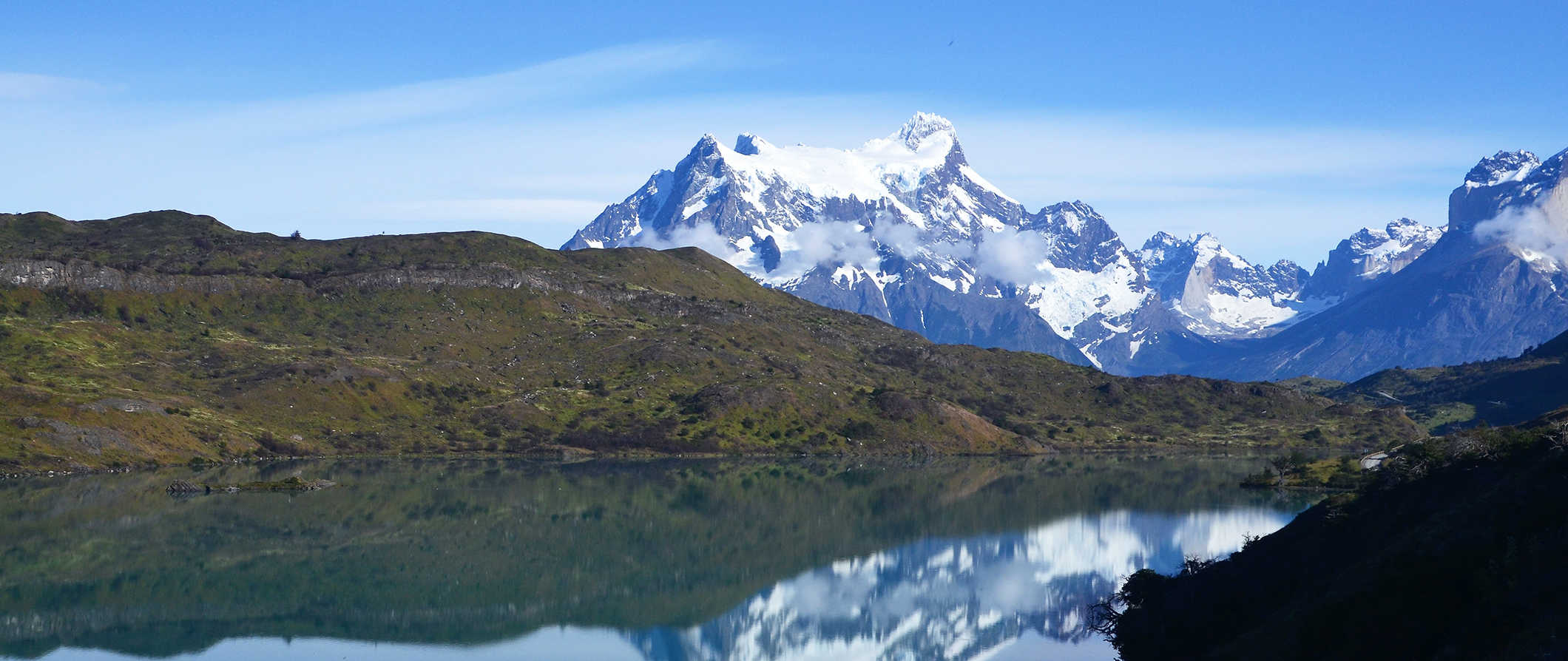
Chile is one of the most slender and longest countries in the world — it’s just 150 miles across at its widest point! From the snow-capped volcanoes of Patagonia and blistering heights of the Andes to world-class wineries and Maoi sculptures of Easter Island , there are a lot of wonderful things to see in Chile.
Traveling to Chile was one of the best experiences I’ve had in South America. It just constantly blew me away. It’s one of the most developed South American countries (the capital, Santiago, is a tech hub for the region), the people were awesome, the food was incredible, and the scenery made me feel in awe of nature.
Not only is there lots to do but the country is budget-friendly, which really rounds it out as a must-see destination.
Use this travel guide to Chile to plan your visit, save money, and make the most out of your trip!
Table of Contents
- Things to See and Do
- Typical Costs
- Suggested Budget
- Money-Saving Tips
- Where to Stay
- How to Get Around
- How to Stay Safe
- Best Places to Book Your Trip
- Related Blogs on Chile
Top 5 Things to See and Do in Chile
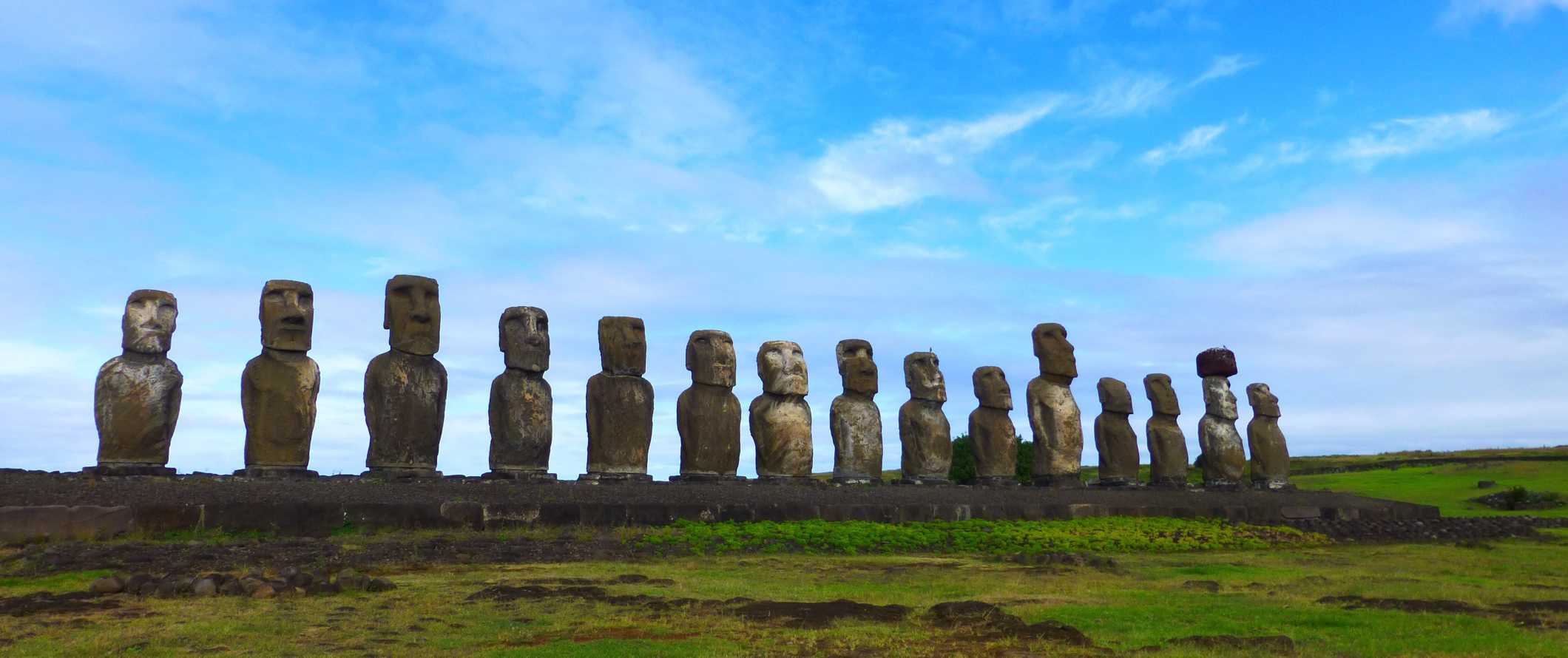
1. See Easter Island
Easter Island, located 3,540 kilometers (2,200 miles) off the coast of Chile, is the most isolated inhabited island on earth and home to the Rapa Nui Polynesian indigenous people that have lived there since 300 CE. Named after explorer Jacob Roggeveen’s ‘discovery’ of the island on Easter Sunday in 1722, this protected UNESCO World Heritage Site is famous for its Moai sculptures (the iconic big faces dotted all over the island). However, there is so much more to the island, including thousands of archaeological sites, volcanic craters and tunnels, pristine beaches, and excellent diving. To explore this magical place, hike around the dramatic cliffs and extinct volcanoes around the Moai archeological sites or around the spectacular Rano Kau crater and the Ana O Keke Cave. Or go sun yourself on Anakena’s beautiful white coral sand beach or Ovahe, a secluded pink sand beach hidden in a little cove with sparkling turquoise waters.
2. Discover Torres del Paine National Park
Torres del Paine lies between the Andes and Patagonian steppe and is made up of snow-clad mountains, glacier lakes, and some of the best hiking in Chile. It also happens to be one of the most beautiful and desolate regions on the planet. There is no end to the scenic views here, including the three rugged, towering peaks of Central, Monzino, and Dagostini as well as the Southern Ice Fields. Be sure to wander around the enchanting Sarmiento Lake and see the Amarga Lagoon and the giant Salto Grande Waterfall. Admission is 29,250 CLP for up to three days for foreigners.
3. Explore Santiago
Chile’s capital is a thriving city and home to a third of the country’s entire population. Founded in 1541, this vibrant capital offers gorgeous panoramas, great restaurants, tasty locally-produced wine, and of course, Barrio Bellavista’s nightlife. There are quite a few must-see attractions in the city: Parque Metropolitano (a large urban park) as well as Cerro San Cristóbal, where you can hike around taking in beautiful views of the city, shouldn’t be missed. The Museum of Human Rights is also a must-visit site, as it chronicles the dark years of Pinochet when thousands of people ‘disappeared’ at the hands of his violent regime.
4. Marvel at San Pedro de Atacama
Located in Chile’s Norte Chico northern region, San Pedro de Atacama is one of Chile’s hottest tourist towns. Literally. Sitting at 2,400 meters (7,874 feet), the ancient town is in the driest desert in the world (it reportedly hasn’t seen rain since 1870). But the rock formations here are stunning, and it’s the perfect place to stargaze. This little town with adobe houses and dirt streets only has 5,000 inhabitants but plenty of tourists visit up to explore the stunning valley landscapes, the Atacama Salt Flats, and the Chaxa and Miniques Lagoons. Don’t miss the famous beautiful jagged geological formations of Valle de la Luna and Valle de la Muerte valleys that can be reached by bicycle from town.
5. Visit colorful Valparaiso
Nicknamed the “Jewel of South America,” this colorful city near Santiago is a mesh of bohemian bars and Victorian architecture along a coastline of sheer cliffs. The laid-back atmosphere and beauty of the area have inspired generations of writers and poets, including poet Pablo Neruda. Be sure to bring your camera because the whole city is painted in vibrant Insta-worthy colors. Take the Ascensor Reina Victoria funicular up to the Concepcion neighborhood and have a cocktail on the hilltop overlooking the city as you try some of the delicious local seafood dishes. Also, be sure to check out two of Chile’s top beaches nearby, the upscale Viña del Mar and the super cool Reñaca.
Other Things to See and Do in Chile
1. see the san marcos cathedral.
The same architect who was responsible for the Eiffel Tower, Alexandre Gustav Eiffel, designed San Marcos Cathedral. The cathedral is in Arica, Chile’s northernmost city, and was built to replace the original cathedral destroyed by an earthquake in 1868. The new cathedral was commissioned in 1876 and is a rare example of Gothic architecture in South America.
2. Get tipsy on a wine tour
Chile’s vineyards have been producing world-class wine for over 400 years. There are plenty of tours available around the country as vineyards stretch the entire length of Chile. I think the best wineries are located near Santiago. Expect to pay around 15,000-20,000 CLP for a basic tour, though fancier tours at more prestigious vineyards can easily be over 55,000-100,000 CLP per person. Most tours last 4-8 hours.
3. Hike a volcano
Chile is home to the world’s tallest active volcano, Ojos del Salado, which lies in the Andes near the Argentine border. Villarica and Osorno are also popular volcanoes (and both lie close to lakes). Most volcanoes in the country have thermal spas at their base too. Experienced hikers can do the trip on their own, though there are plenty of guided tours available for travelers looking for a group tour. Most multi-day tours span 10-14 days and cost millions of pesos. For day trips like the Cajon de Maipo, Osorno Volcano, Termas Colina, and Petrohue Falls, expect to pay 32,000-56,000 CLP per person.
4. Valle de la Muerte
Also known as “Death Valley,” this is an astounding place to hike, go horseback riding, or even go sandboarding. Located in the northeast of the country near San Pedro de Atacama, there are also guided moonlight walks that take you out over the rocky martian landscape. You can rent a sandboard for around 8,300 CLP or go on a sandboard tour for 23,000 CLP per person which includes transportation. There are even tours that sandboard at midnight, using spotlights to light the way (they have a DJ too!). If you’re looking to hike, check out the Corniza Trail. It’s a 7-hour loop that’s relatively easy (many families do it).
5. Santuario de la Naturaleza Valle de la Luna
Also located near San Pedro de Atacama, the “Valley of the Moon” is an otherworldly landscape that is home to stones and sand formations that have developed an extraordinary texture due to thousands of years of winds and flooding. The rock formations look like the surface of the moon, hence the park’s name. It’s a great place to go hiking — just don’t forget to bring water as it can get quite warm. Tours are available for around 26,000 CLP per person.
6. See the El Tatio geysers
A popular tourist attraction, these geysers are incredibly beautiful and well worth a visit as they make up the largest geyser field in the Southern Hemisphere (and they are the third largest in the world). You have to get up around 4am as all the tour companies aim to get you there by sunrise and it’s a 90-minute drive from San Pedro de Atacama. But it’s worth the effort! Bring a swimsuit as there are thermal pools nearby. Tours cost around 33,000-38,000 CLP. You can visit without a tour (admission is 15,000 CLP) but you’ll need to rent your own vehicle to get there.
7. Museo de Bellas Artes
This museum is one of the best in the country. Located in Santiago, it’s home to a wide display of fine art, sculptures, photography, paintings, and digital media. Built in 1910, the building is somewhat small but the architecture is equally as impressive as the collection within (it was built in the Beaux-arts style and has a very Parisian feel to it). Admission is free.
8. Mingle among the wealthy in Viña del Mar
Considered a Chilean Miami, this city next to Valparaiso serves as a hotspot for casinos, upscale cafes, and seaside restaurants. Even if you don’t have money to burn, it’s an interesting place to spend an afternoon people-watching as you wander the beach promenade. You’ll find lots of world-class restaurants here. If you’ve got some money to burn, stay a night!
9. Tour Pablo Neruda’s homes
One of the world’s most famous poets used to call Chile home. With homes in Valparaiso, Santiago, and Isla Negra, this Chilean icon stuffed a lifetime of knick-knacks, literature, and interesting maritime architectural pieces into his three abodes. All of them are open to the public. Even if you’re not a huge fan of his work, his homes alone are an interesting glimpse into Chilean culture as Neruda is a cultural icon and one of the most famous poets of the 20th century. Admission to each home costs around 7,000 CLP and includes an audio-guide system in multiple languages.
10. Get off the beaten path
Some lesser-known treasures worth visiting in Chile are Frutillar (a beautiful lakeside community in southern Chile’s Los Lagos Region), Lonquimay (another gorgeous lakeside town in the Malleco Province of southern Chile’s Araucanía Region), Caleta Tortel (a rugged seaside town with wooden walkways instead of streets in the heart of Patagonia) and Coyhaique (a less pricey Northern Patagonia city that’s a hub for great nature adventures). If you’re looking to beat the crowds, be sure to visit some of these lesser-known destinations.
11. Swim in the world’s largest pool
If you’re looking for some luxury, head to the Crystal Lagoon, home to the world’s largest swimming pool. It’s located at the San Alfonso del Mar resort in Algarrobo, just west of Santiago. The pool is the size of twenty Olympic swimming pools and is the biggest recreational swimming pool in the world, requiring 66 million gallons of water just to fill it! A 1-2 bedroom apartment rental here costs 70,000-120,000 CLP per night.
Chile Travel Costs
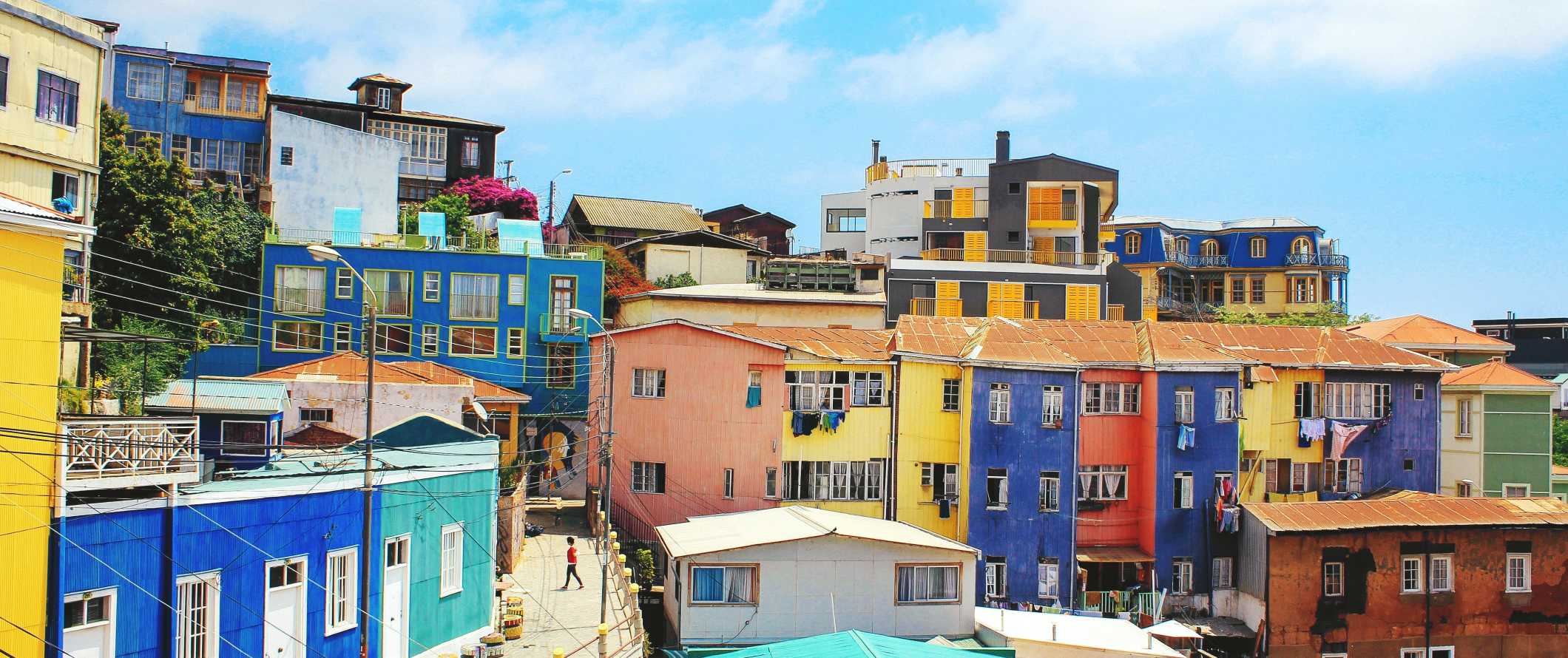
Accommodation – Hostel dorms start around 9,800 CLP per night and private rooms come in at around 22,000-30,000 CLP. Free breakfast and free Wi-Fi are common, and many hostels have self-catering facilities if you want to cook your own food.
Budget hotels are inexpensive in Chile with prices starting at 25,000-35,000 CLP per night for a basic double or twin bed (though expect to pay closer to 55,000 CLP for a nicer budget hotel). Many budget hotels include free breakfast and free Wi-Fi (though not all, so be sure to double-check).
Airbnb is available in the larger cities, with prices as low as 16,000 CLP per night for shared accommodation. If you want a private home or apartment, expect to pay at least 45- 60,000 CLP.
For those traveling with a tent, camping is possible. There are a handful of campgrounds scattered around the country where you can pitch a tent for as little as 5,300-6,000 CLP per night but some with lots of amenities and proximity to the beach are as much as 35,000 CLP.
Food – With an extensive coastline, Chilean cuisine relies heavily on seafood. Cod, salmon, shrimp, lobster, prawn — there are tons of options available. BBQ meat (including alpaca) is particularly popular in the north. Other popular Chilean dishes include churrasco (steak sandwich), machas a la parmesana (clams baked with white wine, parmesan cheese, and butter), and chupe (a hearty seafood stew), and empanadas.
Overall, food in the country isn’t too expensive, though prices get a lot higher the further south you go due to higher transportation costs. Most places in the country offer a set menu for lunch with a starter, main, and drink for about 7,000 CLP. A steak dinner with wine and an appetizer costs around 35,000 CLP while a fast food combo meal (think McDonald’s) costs around 6,000 CLP.
A latte or cappuccino costs 2,300 CLP while a domestic beer can be as cheap as 3,000 CLP. Bottled water is 850 CLP.
Grocery shopping can save you a lot of money if you have access to a kitchen. Expect a week’s worth of groceries to cost around 25,000 CLP depending on your diet. This gets you basic staples like pasta, rice, quinoa, vegetables, and some meat.
As everything must be shipped south, food prices in Patagonia are about 30% higher than elsewhere in the country.
Backpacking Chile Suggested Budgets
How much does it cost to visit Chile? That depends on a few different factors, specifically, what you plan on doing while you’re here as well as your travel style.
On a backpacking budget of 36,000 CLP per day, you can stay in a hostel dorm, cook your own meals, use public transportation to get around, and visit a few museums. If you plan on drinking, you’ll need to add 5,000-8,000 CLP per day.
On a mid-range budget of 105,000 CLP per day, you can stay in a private Airbnb, take buses between destinations, eat out at street stalls and cheap restaurants serving local cuisine, take the occasional taxi, drink at the bar, and do some paid excursions like guided hikes and wine tours.
On a “luxury” budget of 205,000 CLP per day, you can stay in a hotel, hire a rental car to get around, do some guided tours, drink as much as you want, and eat out at nice restaurants for every meal. This is just the ground floor for luxury though. The sky is the limit!
You can use the chart below to get some idea of how much you need to budget daily. Keep in mind these are daily averages – some days you’ll spend more, some days you’ll spend less (you might spend less every day). We just want to give you a general idea of how to make your budget. Prices are in CLP.
Chile Travel Guide: Money-Saving Tips
Chile can be an expensive place to visit, especially if you’re doing a lot of tours and activities. The size of the country also means you can end up spending a lot on transportation. Here are some tips to help you save during your visit:
- Buy wine at the supermarkets – Surprisingly, buying wine from vineyards can be more expensive than in the supermarkets. Buy from the supermarkets if you’re on a tight budget.
- Take the bus – Bus service is inexpensive and efficient here. Night buses are comfortable and a good way to save on a night’s accommodation (they often have lie flat beds).
- Buy food from La Vega Market – La Vega Market in Santiago sells everything you could possibly need and all sorts of local ingredients from Chile and Peru. Shop here for your veggies, fruits, and to get an authentic experience.
- Eat at the local fish markets – In the coastal cities, the local fish markets are usually the best place for a seafood meal. Though the restaurants look cheap and thrown together, they’re delicious!
- Shop around – Haggling is not common and vendors stick to their guns even when called out for price discrimination. So, if you’re quoted an inflated price for being a tourist it’s best to just move around and find alternatives where the prices are already set and visible. Otherwise, you’ll just be wasting your time and energy.
- Ride in a micro or colectivo – Regular buses are for intercity transportation. “Micros” are intracity, and “colectivos” are taxis that drive a specific route once they get four people in the car, and charge a very low rate. If you want to go somewhere, chances are there’s a micro or colectivo that can get you close — just ask a local and they’ll know where to point you.
- Stay with a local – Chile doesn’t have a huge Couchsurfing community, but you can still give it a shot and try to find a host (and get a local friend and a free place to stay). Just be sure to send your requests early!
- Take a free walking tour – There are some great options available when it comes to free walking tours in Santiago, such as Tours 4 Tips or Free Tour Santiago . If you want to explore the city while learning about its history, architecture, and people then be sure to take a free tour. Just remember to tip at the end!
- Stay at a Hola Hostel – Hola Hostels is a network of hostels predominantly in South and Central America. They offer 10% off to their members, as well as other local discounts for food and activities. Joining is free, and their hostels are also committed to environmentally sustainable practices.
- Travel in the shoulder season – Prices in the country are cheaper outside of the high season (which is November-March). This includes admission to parks like Torres del Paine, which charge double during the busy summer months. Beat the crowds and save some money by skipping the high season.
- Bring a water bottle – LifeStraw is a reusable water bottle with a built-in filter that you can use instead of buying single-use plastic bottles. It removes bacteria, parasites, micro plastics, and other contaminants so it’s perfect for cities as well as if you’re out hiking in nature.
Where to Stay in Chile
Hostels can be found in all the major destinations across Chile. Here are my recommended places to stay if you’re on a budget:
- Hostal Forestal (Santiago)
- Poker Hostel (Santiago)
- Hostal Po (Valparaiso)
- Hostal Rural (San Pedro de Atacama)
- Kona Tau (Easter Island)
- Chili Kiwi Lakefront (Pucon)
How to Get Around Chile
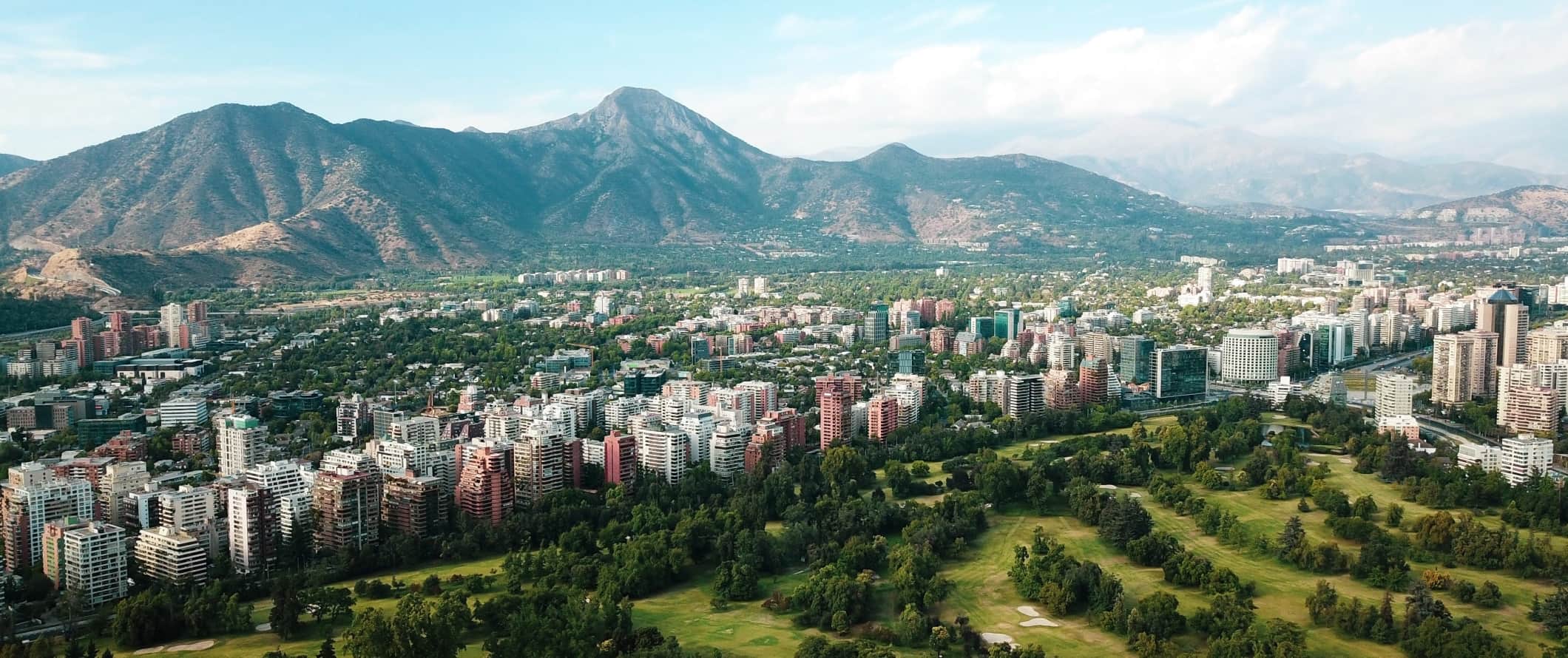
Public transportation – Public transportation, especially in Santiago, is reliable and affordable. In Santiago, you need to purchase a refillable bus pass (BIP Card) for your journeys as individual tickets are no longer available. The card costs around 1,550 CLP with the average ride costing around 700 CLP (prices vary depending on the time of day). BIP cards need a minimum initial credit of 1,000 CLP. You have to pay for your card and top-ups in cash; non-Chilean credit cards are not accepted.
Bus – For intercity travel, buses are the cheapest way to get around — and they are nice too! Reclining seats are common and many even recline almost all the way down. Additionally, some night buses even have a curtain between the seats so you can have a little privacy from your neighbor. The best companies to use are Turbus and Pullman.
Expect to pay at least 38,000 CLP per person from Santiago to Antofagasta. From Santiago to Valparaiso, bus tickets cost around 6,000–10,000 CLP each way. For something like the cross-country journey from Santiago to Punta Arenas, expect to pay at least 60,000 CLP for the 40-hour bus ride (this is an incredibly long distance so you have to change at Osorno or choose flying).
Train – Traveling by train in Chile is virtually non-existent. Much of the tracks have been left to decay beyond repair outside the central region of the country. Trains link Santiago with Curico, Talca, Linares, and Chillan with air-conditioned cars but that’s the extent of Chile’s train infrastructure. You can visit trencentral.cl for the available routes and prices.
Flying – Flying around the country is surprisingly affordable. Expect to pay around 28,000-35,000 CLP for the two-hour flight from Santiago to Antofagasta. Prices are similar for trips from Santiago to:
- La Serena (one hour)
- Calama (two hours)
- Arica (two hours forty-five minutes)
- Concepcion (one hour)
- Puerto Montt (one hour forty minutes)
For a flight between Santiago and Puerto Natales, expect to pay around 40,000-55,000 CLP. Round-trip flights from Santiago to the remote Easter Island cost around 240,000-300,000 CLP.
Car rental – Driving in Chile is much easier (and safer) than driving in other South American countries. Many of the highways are well-maintained thanks to their liberal use of toll roads. While driving in Santiago can be a little chaotic, once you get out of the city things generally become much easier. Expect to pay around 178,000 CLP for a one-week rental. Drivers need to be at least 21 years old.
For the best car rental prices, use Discover Cars .
When to Go to Chile
Since Chile is in the southern hemisphere, the summer months are December, January, and February. With landscapes ranging from desert to tundra, the weather and temperatures can vary tremendously here. Expect daily highs around 28-30°C (82-86°F) in Santiago, while the highs in Torres del Paine are closer to 13°C (55°F).
Winter is not a particularly great time to visit as the temperatures can drop below freezing, with snowfall common in certain regions. Daily lows reach -15 °C (5 F), making it rather unpleasant to be out and about during the day. Unsurprisingly, you can see why most travelers visit during the summer.
Fortunately, the shoulder season is also a fantastic time to visit Chile as you’ll be able to beat the crowds and save yourself some money. It’s an especially good time to visit if you plan on visiting Torres del Paine as there will be fewer hikers here and the park admission will be much cheaper. November and March are usually included in the high season, so aim for late October or early April. The weather won’t be perfect, but it’s a good compromise for travelers looking to dodge the crowds.
How to Stay Safe in Chile
Chile is considered a safe destination and generally ranks as one of the safest on the continent. That said, crimes still do occur so you’ll want to take some precautions during your trip. The most common crimes in Chile are petty theft and bag snatching. Since these are crimes of opportunity, you’ll always want to make sure your possessions are secure. Be extra vigilant when riding the bus and when you’re in areas popular with tourists.
When taking the bus (especially the night bus) make sure you don’t have any valuables in your checked bag. Additionally, keep any valuables secure and out of reach from any would-be pickpockets.
If you’re enjoying the nightlife of Santiago, keep an eye on your drink as drink-spiking can occur.
Be sure to read about the common travel scams to avoid here .
Earthquakes are also common enough in Chile that you’ll want to make sure you are prepared should one occur. Know where your emergency exits are in your accommodation as well as any local evacuation locations for major emergencies. If you have a map downloaded on your phone, save the location of the nearest hospital and airport as well, just in case.
If you need emergency services, dial 113 for assistance.
The most important piece of advice I can offer is to purchase good travel insurance. Travel insurance will protect you against illness, injury, theft, and cancellations. It’s comprehensive protection in case anything goes wrong. I never go on a trip without it as I’ve had to use it many times in the past. You can use the widget below to find the policy right for you:
Chile Travel Guide: The Best Booking Resources
These are my favorite companies to use when I travel. They consistently have the best deals, offer world-class customer service and great value, and overall, are better than their competitors. They are the companies I use the most and are always the starting point in my search for travel deals.
- Skyscanner – Skyscanner is my favorite flight search engine. They search small websites and budget airlines that larger search sites tend to miss. They are hands down the number one place to start.
- Hostelworld – This is the best hostel accommodation site out there with the largest inventory, best search interface, and widest availability.
- Booking.com – The best all around booking site that constantly provides the cheapest and lowest rates. They have the widest selection of budget accommodation. In all my tests, they’ve always had the cheapest rates out of all the booking websites.
- Get Your Guide – Get Your Guide is a huge online marketplace for tours and excursions. They have tons of tour options available in cities all around the world, including everything from cooking classes, walking tours, street art lessons, and more!
- SafetyWing – Safety Wing offers convenient and affordable plans tailored to digital nomads and long-term travelers. They have cheap monthly plans, great customer service, and an easy-to-use claims process that makes it perfect for those on the road.
- LifeStraw – My go-to company for reusable water bottles with built-in filters so you can ensure your drinking water is always clean and safe.
- Unbound Merino – They make lightweight, durable, easy-to-clean travel clothing.
- Top Travel Credit Cards – Points are the best way to cut down travel expenses. Here’s my favorite point earning credit cards so you can get free travel!
Chile Gear and Packing Guide
If you’re heading on the road and need some gear suggestions, here are my tips for the best travel backpack and for what to pack!
The Best Backpack for Travelers
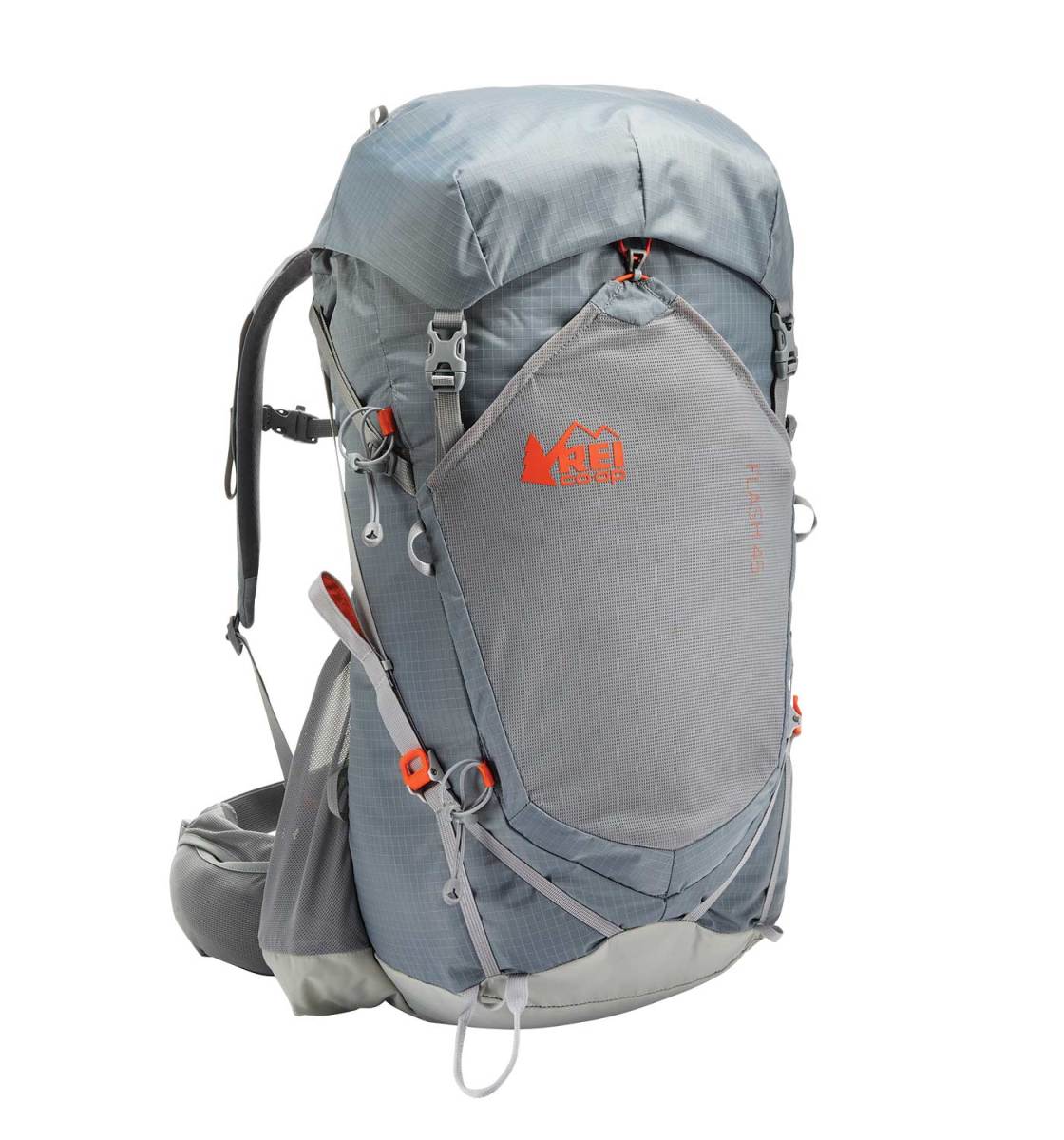
If you want something different, refer to my article on how to choose the best travel backpack for tips on picking a pack and other backpack suggestions.
What to Pack for Your Trip
- 1 pair of jeans (heavy and not easily dried, but I like them; a good alternative is khaki pants)
- 1 pair of shorts
- 1 bathing suit
- 5 T-shirts ( Unbound Merino is my preferred company. If you’re a member of TNN+, you can get 15% off your purchase )
- 1 long-sleeved T-shirt
- 1 pair of flip-flops
- 1 pair of sneakers
- 6 pairs of socks (I always end up losing half)
- 5 pairs of boxer shorts (I’m not a briefs guy!)
- 1 toothbrush
- 1 tube of toothpaste
- 1 package of dental floss
- 1 small bottle of shampoo
- 1 small bottle of shower gel
Small Medical Kit (safety is important!!!)
- Hydrocortisone cream
- Antibacterial cream
- Hand sanitizer (germs = sick = bad holiday)
Miscellaneous
- A key or combination lock (safety first)
- Zip-lock bags (keeps things from leaking or exploding)
- Plastic bags (great for laundry)
- Universal charger/adaptor (this applies to everyone)
- LifeStraw (A water bottle with a purifier)
Female Travel Packing List I’m not a woman, so I don’t know what a woman wears, but Kristin Addis, our solo female travel guru, wrote this list as an addition to the basics above:
- 1 pair of stretchy jeans (they wash and dry easily)
- 1 pair of leggings (if it’s cold, they can go under your jeans, otherwise with a dress or shirt)
- 2-3 long-sleeve tops
- 2-3 T-shirts
- 3-4 spaghetti tops
- 1 light cardigan
- 1 dry shampoo spray & talc powder (keeps long hair grease-free in between washes)
- 1 hairbrush
- Makeup you use
- Hair bands & hair clips
- Feminine hygiene products (you can opt to buy there too, but I prefer not to count on it, and most people have their preferred products)
For more on packing, check out these posts:
- What I Pack For My Travels
- The Ultimate List For Female Travelers
- How to Choose and Buy the Right Backpack
Chile Travel Guide: Related Articles
Want more info? Check out all the articles I’ve written on Chile travel and continue planning your trip:
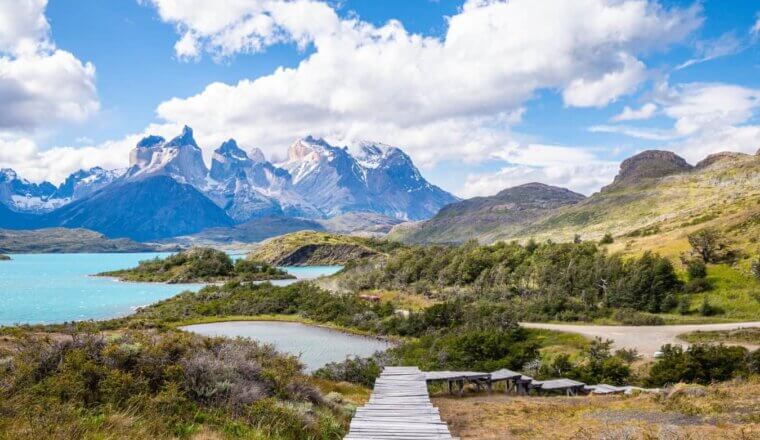
Is Chile Safe to Visit?
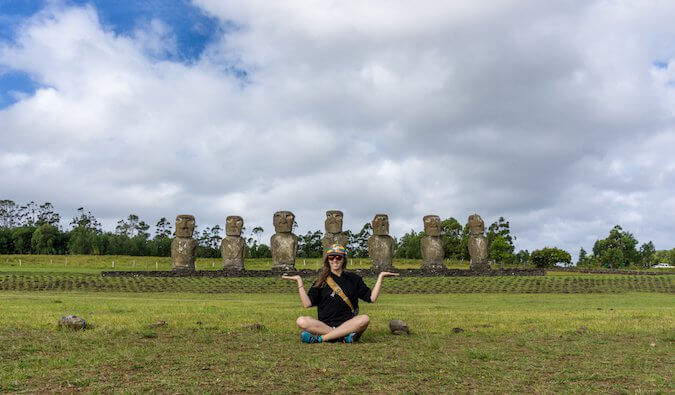
How to Travel Easter Island on a Tight Budget
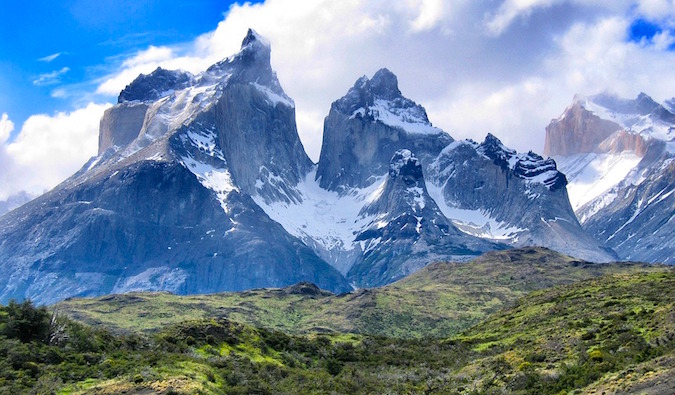
18 of the Best Spots in Patagonia
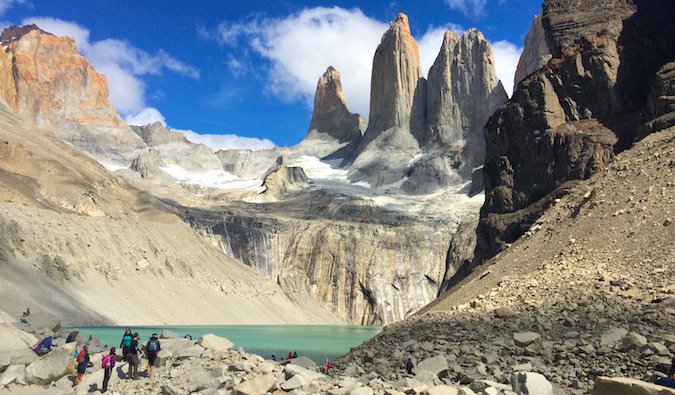
Patagonia: Thoughts on Getting Offline and Trying to Camp
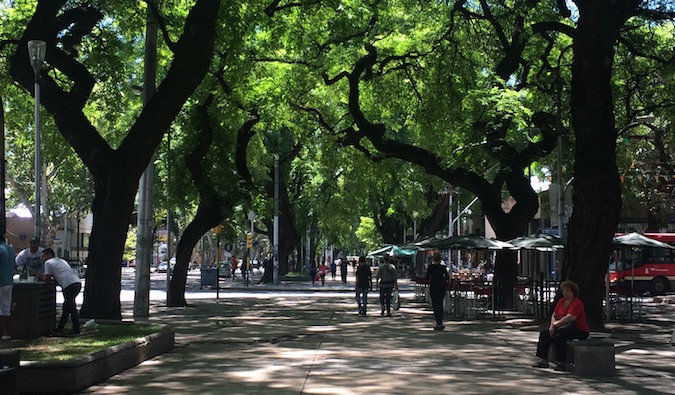
12 Ways to Save Money in Argentina
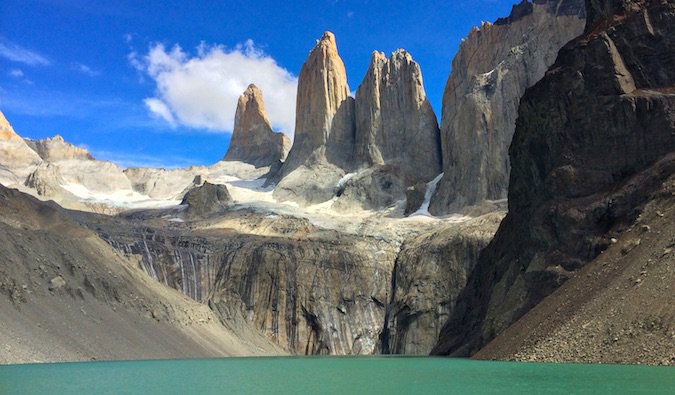
16 Amazing Photos from My Visit to Torres Del Paine
Get my best stuff sent straight to you, pin it on pinterest.
- Where To Stay
- Transportation
- Booking Resources
- Related Blogs

Is Santiago Worth Visiting?
Santiago, Chile is worth visiting for many more reasons than one.
The Chilean capital is a melting hotpot of culture , and is usually the first point of entry for many travelers heading to this South American nation.
Here we can explore the cultural highlights, visit many unique museums as well as get some awesome Andean mountain vistas.
In this article we’ll list the seven best reasons to visit Santiago, as well as cover any other important information you’ll need to know.

What's in this guide?
Is Santiago worth visiting?
Quick Answer: We think that any visitor to the Southern Cone who will be traveling through Chile should make a stop within the capital, given there is tons to see and do.
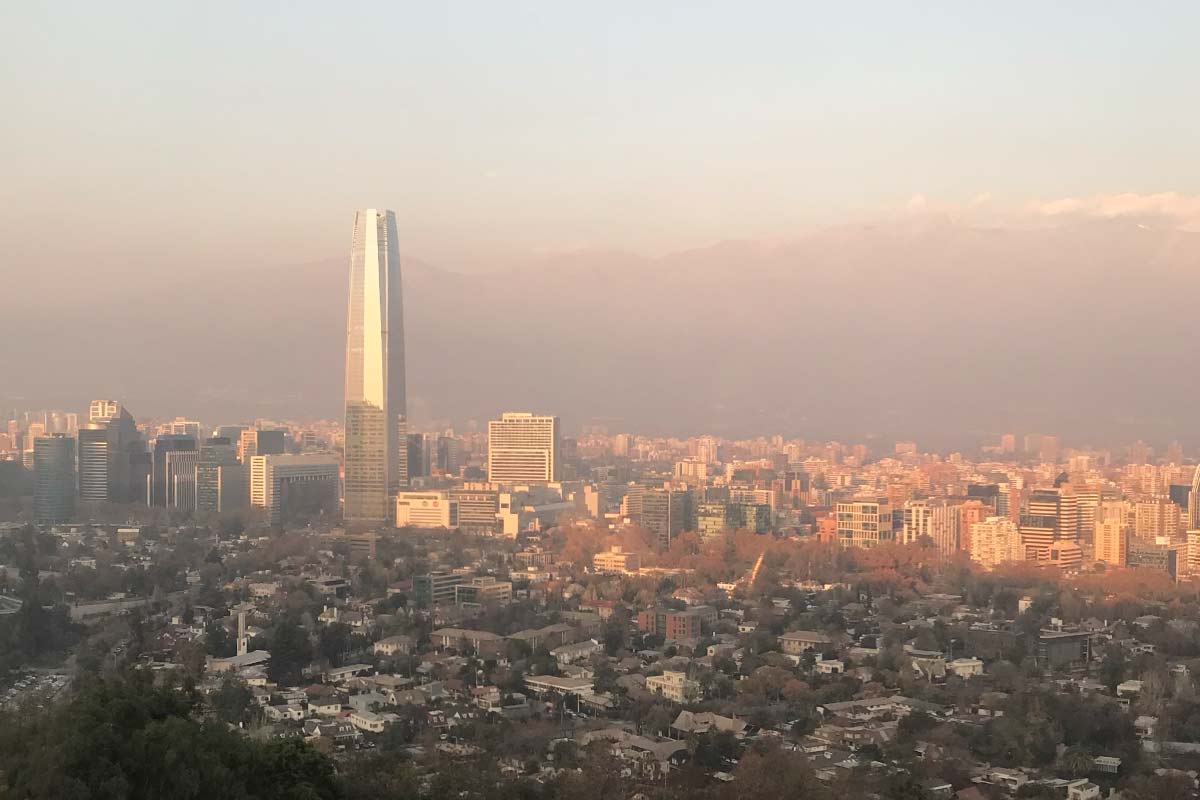
Firstly we’ll find many scenic lookout points to enjoy, where we can see the towering Andes provide the perfect contrast against the cityscape. Cerro San Cristóbal is one of the most notorious miradores in the city, and you can easily take the gondola up.
Within the city we’ll find lots of edgy neighborhoods such as Lastarria and Bellavista which are great for a stay, which both have many restaurants and bars.
Throughout Santiago we’ll also find many worthwhile sites including the Plaza de Armas , Saint Lucia Hill as well as the Museo Chileno de Arte Precolombino – the most comprehensive museum of its kind in the Western Hemisphere.
Finally, Santiago is also the perfect place to base yourself whilst you head out on several day trips around the nearby region.
Valparaíso is a really popular city just an hour north, which is known for its colorful streets and coastal location. Those who love skiing will also be in luck, where we can find many awesome slopes nearby such as the resort of El Colorado.
Where is Santiago?
Santiago is located roughly halfway down this extremely long nation , which makes it a great point to rest when traveling from Bolivia (further north) or Patagonia (further south).
The climate here is quite cool year-round, given the coast is just an hour away to the west, whilst the impressive Andes Mountains are found just to the east.
How to get to Santiago from Mendoza
There are two main ways to travel this route, which are by bus and plane. Given how close these destinations are (well, close compared with anywhere else in Chile to be honest), taking the bus is a really popular option.
From the bus terminal in Mendoza you can take the 8 hour bus , which also includes time to stop at the border control where you leave Argentina and enter Chile.
There’s various companies that serve the route, and they all leave early in the morning. For this reason it’s best to head there the evening before to make sure you can get your ticket. The bus from Mendoza to Santiago will cost roughly $35-40.
The other option is to take the one hour flight, which is served by various airlines daily such as Sky and LATAM. The one-way flight isn’t actually that much ( around $80 without baggage ), so it’s worth considering this option if you have the budget and prefer a more comfortable ride into Santiago.
Got Travel Insurance for Chile?


7 Reasons to Visit Santiago
Are you still wondering if Santiago is really worth the visit? Here’s 7 awesome reasons why you should head to this diverse Chilean city.
1. Learn about Ancient Cultures
All over South America we can find many worthwhile museums that delve into the past, however the Museo Chileno de Arte Precolombino has to be one of the very best.
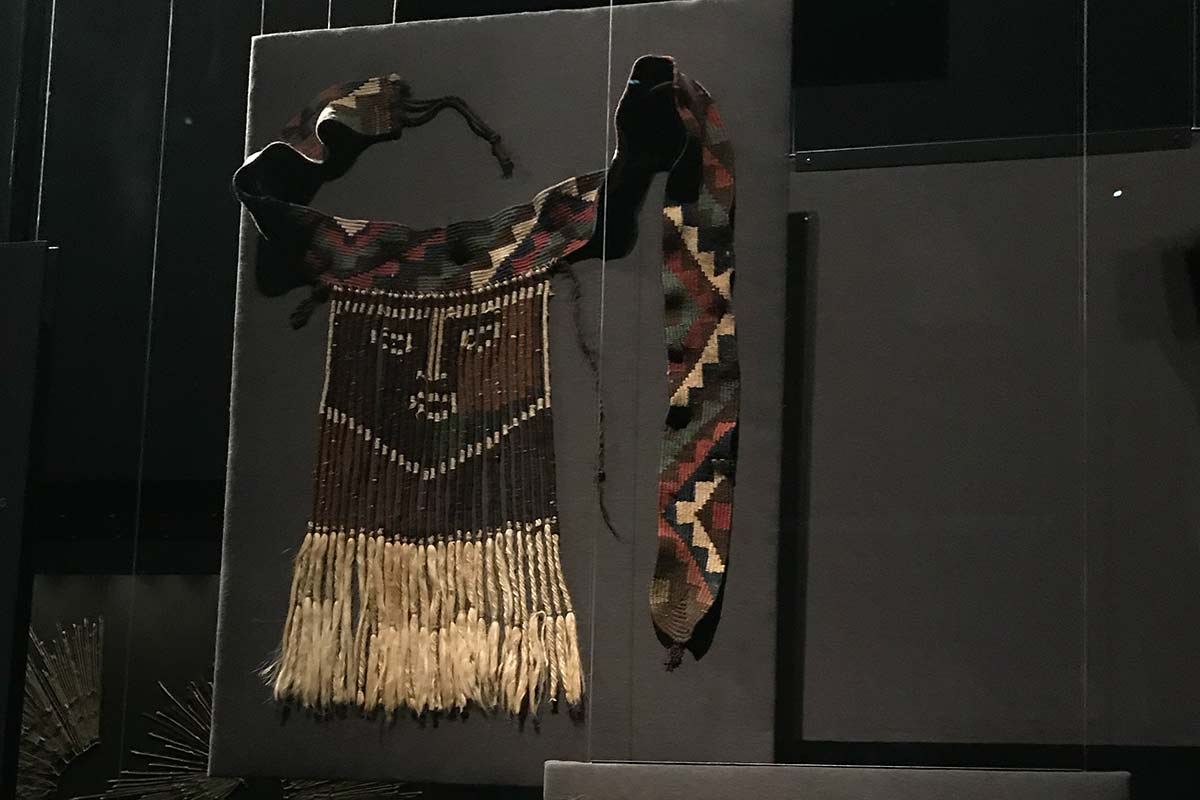
Here we can find a comprehensive collection with over 3000 artifacts, which date back as many as 10,000 years .
Throughout the different exhibition rooms we’ll get to learn about several different civilisations that once roamed these lands, including those of the Moche, Chavín and Capulí cultures.
Some of the best things you can see here include well-preserved mummified remains, ceramic pottery, ancient textiles and garments as well as human statues. The museum is located close to the Plaza de Armas so is an easy visit, however we recommend heading here early given the queues tend to get quite long later in the day.
2. Go Skiing in the Andes Mountains
Santiago is quite a unique city in many ways, and the surrounding mountains make it a great place to come for those who love winter sports.
Of course Patagonia has its special sites too, however if you don’t plan on heading as far south then you can really enjoy these snow-laden pistes. There’s several to choose from, however the Valle Nevado remains one of the most popular with all kinds of slopes (ranging from beginner to expert).
It’s important to remember that the major skiing season in Santiago runs from June until September.
If you’re up for some adventure, then we recommend booking this day tour from Santiago where you’ll visit both Valle Nevado and Farellones. You’ll have all transport to and from your hotel included, as well as plenty of time to enjoy everything else that these sites have to offer.
3. Try all kinds of Chilean Cuisine
In this era, foods from countries like Mexico and Argentina get a good rep internationally, with others in the continent often left behind. However this doesn’t mean the rest are necessarily bad, and actually you’ll find that various foods may catch you by surprise.
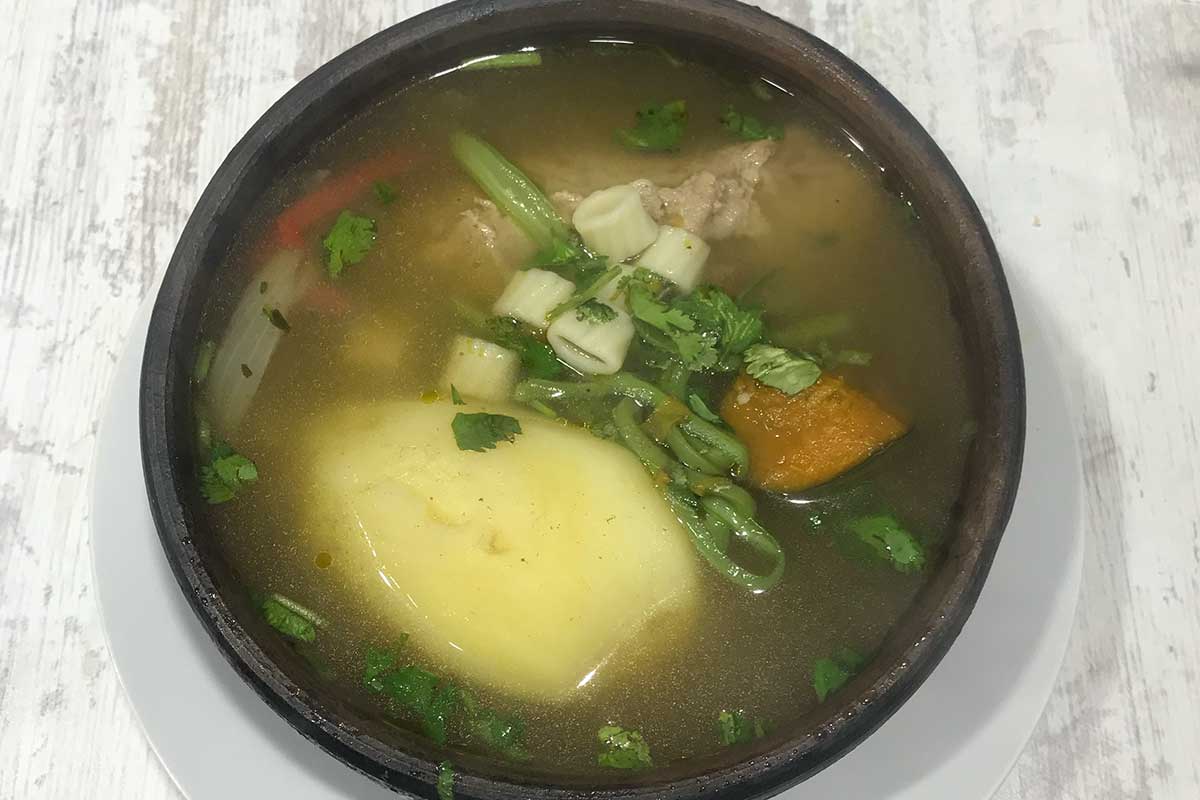
Such is the case with Chile, where we can try all kinds of plates that hail from the coast, Andes and desert regions . Those who like soups will want to try a Cazuela Nogada , whilst seafood-lovers will want to eat a Reineta or Corvina.
In the neighborhood of Lastarria you’ll find all kinds of restaurants which are great for different budgets, as well as some good joints near the Plaza de Armas too. Also don’t forget to try the infamous Completos (stuffed hotdogs) whilst here too!
4. Impressive Architecture and City Highlights
As with any South American capital city, we’ll find the historic center which is full of beautiful colonial architecture. Santiago is no exception, and here we’ll want our camera fully-charged before heading out to explore.
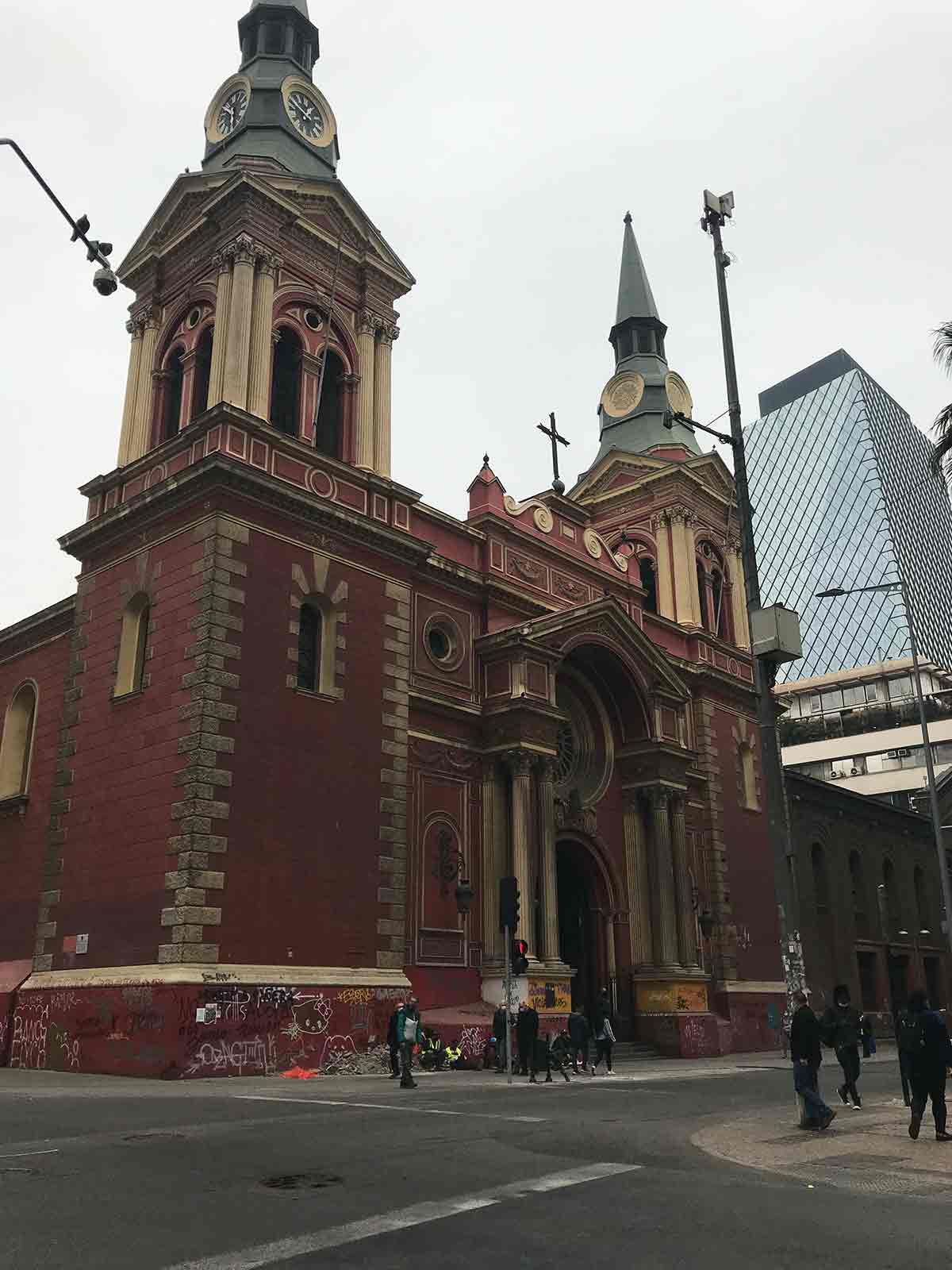
The Plaza de Armas is the best place to start, where we can first see the imposing Catedral Metropolitana de Santiago (which is over 200 years old and features a neoclassical facade). The Museo Histórico Nacional is just a few steps away too within the Plaza, which is known for its bright-yellow exterior.
Once done here, you can then walk the nearby streets to explore more architectural delights, including those of La Moneda Palace, the Former National Congress Building as well as the Castillo Hidalgo. We suggest heading out in the early morning when visiting these highlights, and also to avoid walking around the Plaza de Armas at night (it gets quite sketchy later on).
Even better is booking a customized walking tour around Santiago , where your English-speaking guide will take you around the very best spots. You’ll also be free to add in more gems, and choose how much time you want to spend at each.
5. Get some Awesome City Panoramas over Santiago
One of the very best things you can do is to head up to Cerro San Cristóbal during your time in Santiago. This mountain is actually quite close to the center, and you can easily take a couple of quick metro rides to get to the gondola.
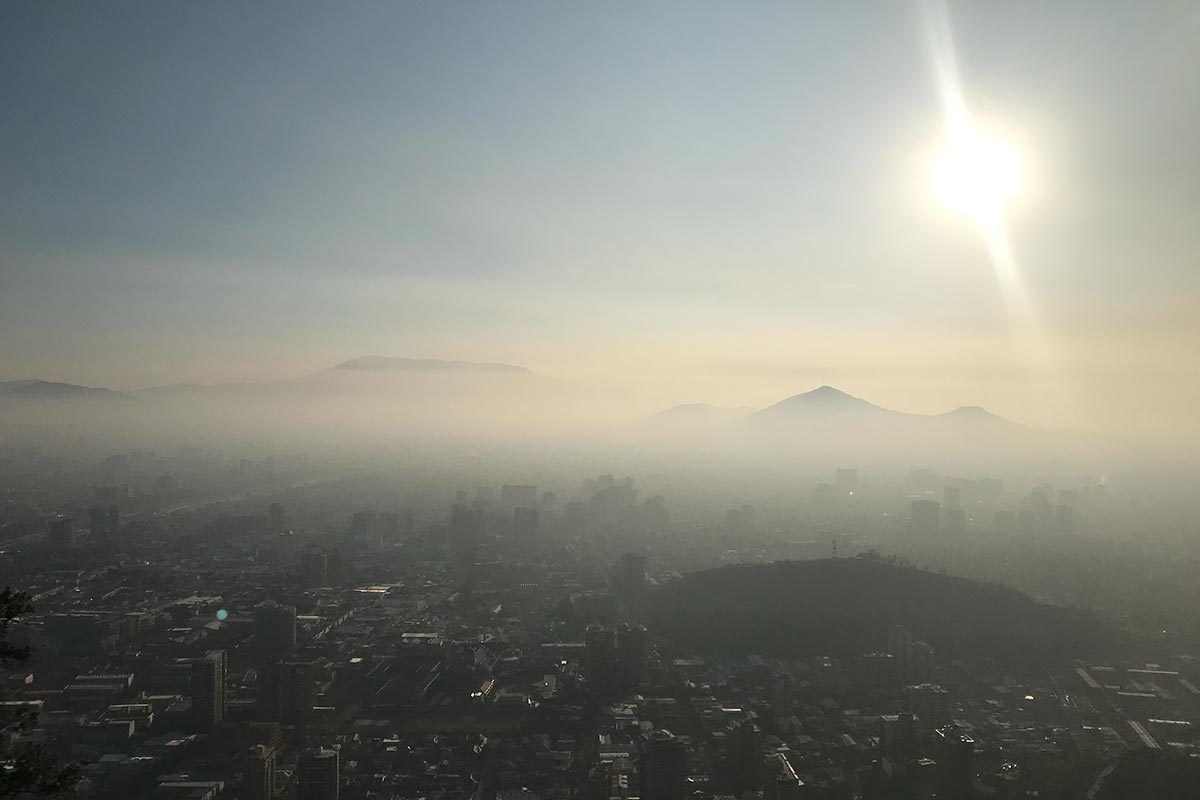
Once at the top you’ll be able to see Santiago in all its glory, along with the massive Andean peaks lurking in the background . At the top you’ll find plenty of food stands for a quick bite, as well as a monastery and the giant statue of the Immaculate Conception.
Keep an eye out for the Gran Torre whilst here, which is a sleek silver building and is one of the tallest in all of Latin America! You can actually head to the top floor here too for some alternative sweeping city views. Regardless of which you choose, we highly recommend doing it a day after it rains here (if it does during your time in Santiago), given it will help clear up the smog and give even better views.
6. Head on a Day Trip to Valparaíso
One of the highlights of a trip through Chile, you simply cannot miss Valparaíso when in Santiago. Famed for its colorful streets and panoramic coastal views , it’s a great place to head from the capital for a day (or a few if you have the time).
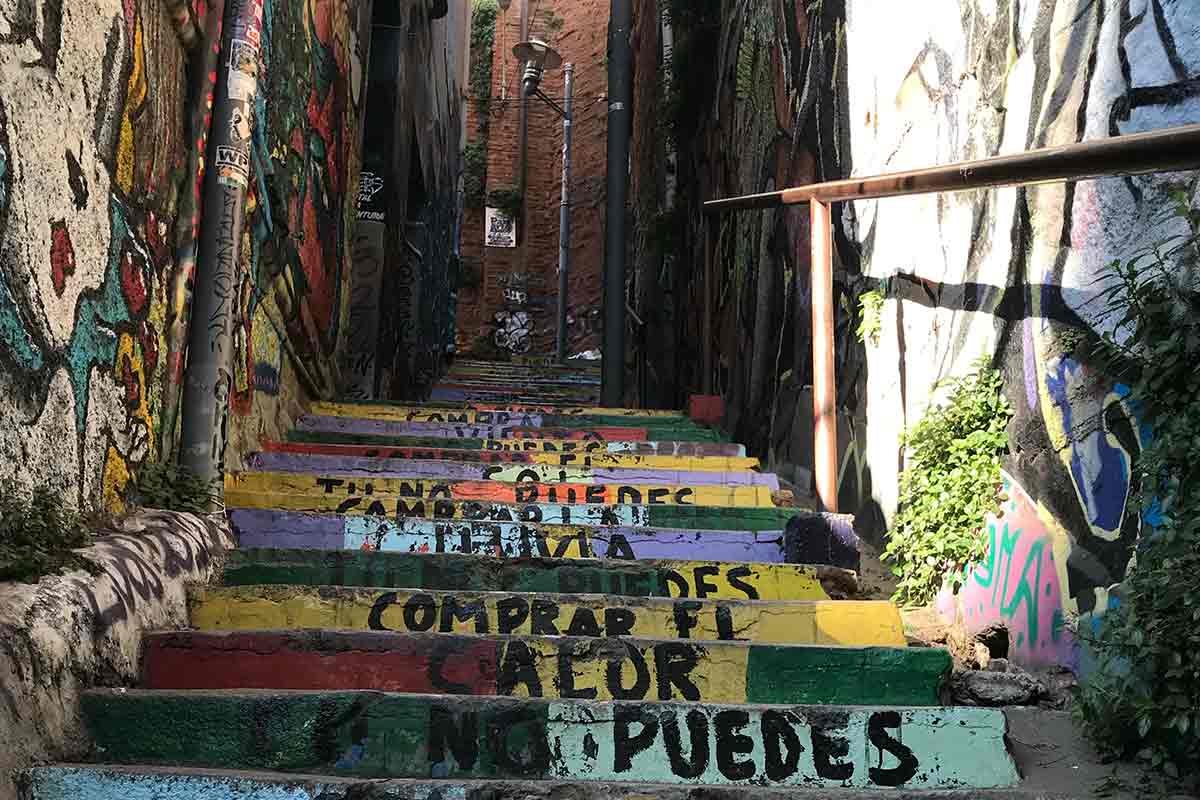
Getting here is pretty simple, where you can take the 1 hour bus which leaves throughout the day from the main bus station (next to the Pajaritos Metro Stop). The best things to do here include joining a walking tour where you’ll visit the different hills such as Cerro Alegre and Cerro Concepción, whilst also seeing some really striking graffiti art.
We suggest going with this full day tour from Santiago , where you’ll also visit the gems of Viña del Mar and the Casablanca Valley. As well as having convenient hotel pick-up and drop-off, you’ll also have a wine tour and tastings included too.
You can also do it independently too, and if so we recommend either in the early morning (around 7:00am) or in the late afternoon to watch the sunset over the Pacific Ocean. There’s also some interesting museums to visit here too including those of La Sebastiana as well as the Museo a Cielo Abierto.
7. Go Wine Tasting in One of the World’s Best Wine Destinations
Argentinian wine tends to steal all of the thunder, however Chile also has some really tasty blends too. Given the Andes runs all the way between both nations, this means we’ll find perfect wine-growing conditions all over the country .
Santiago in particular is great as it’s close to the mountains, and also as it’s where all of the regional wines are imported to from the rest of Chile.
If you want a more hands-on experience then you can head on a bike tour around these wineries, where you can try different blends whilst enjoying the seriously impressive landscapes (snow-capped peaks as far as the eye can see).
If you’re after a more relaxed time, then you’ll find many of these wines on offer in nice bars and joints throughout the city. Once again Lastarria is the place to go, with venues like Le Bistrot Viet and Bocanaríz some great options.
And that’s all for our guide on why you should visit Santiago.
Nestled between the Pacific Ocean and Andes Mountains, Santiago is a great stop to make when heading through this more southern region of South America.
Here you can enjoy typical Chilean cuisine, visit ancient museums, head to nearby Valparaíso and even go skiing if you fancy it!
You’ll also find that getting to Santiago is really easy , given its international airport is so well-connected, and those in nearby Argentina can be here in just a few hours too.
Be sure to read our Backpacking Chile Itinerary for more ideas on where to go in this long and diverse country.
👉🏽 P.S. If you’ve found this guide helpful, buy us a coffee here to say thanks! Or, support us by downloading our South America Travel Bible to get our best content.
“ Dear traveler! Some links in this post contain affiliate links. Meaning, if you click through and make a purchase, book a hostel or sign up for a tour, we may earn a small commission at no additional cost to you . Your support means a lot and helps us to carry on traveling and maintaining the quality of this site for you.”
Similar Posts
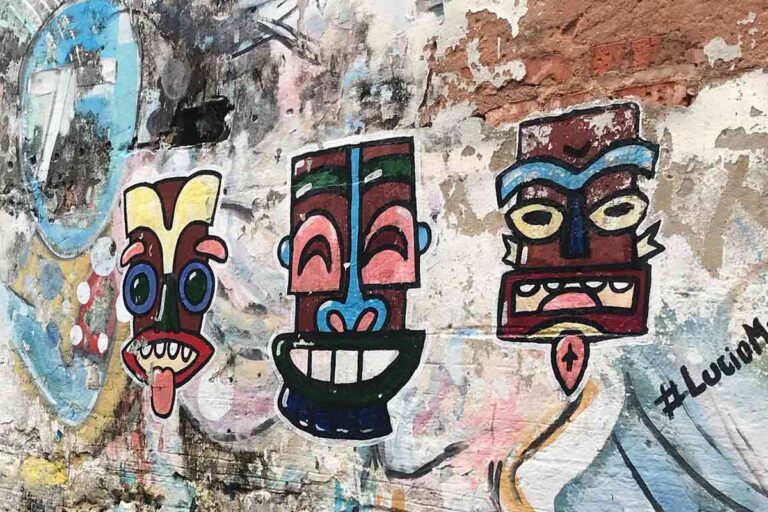
South America Packing List
This expansive continent is by far one of the best in the world for a backpacking trip. Here you can explore some of the most remote jungles in the world (The Amazon), as well as lap up the turquoise waters of the Caribbean, Pacific, or, even the Atlantic. Once you’ve decided that you’ll be going…
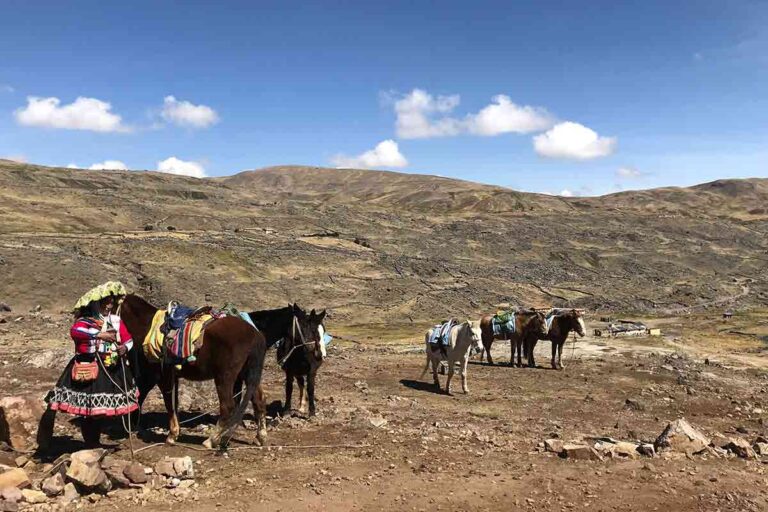
Can you hike the Inca Trail without a guide?
When in Peru, can you hike the Inca Trail without a guide? The Inca Trail is a breathtaking passage once used by ancient civilisations, and is one of the best hikes you can head on when in Peru. In this guide we’ll explore everything you need to know about this epic route, such as whether…
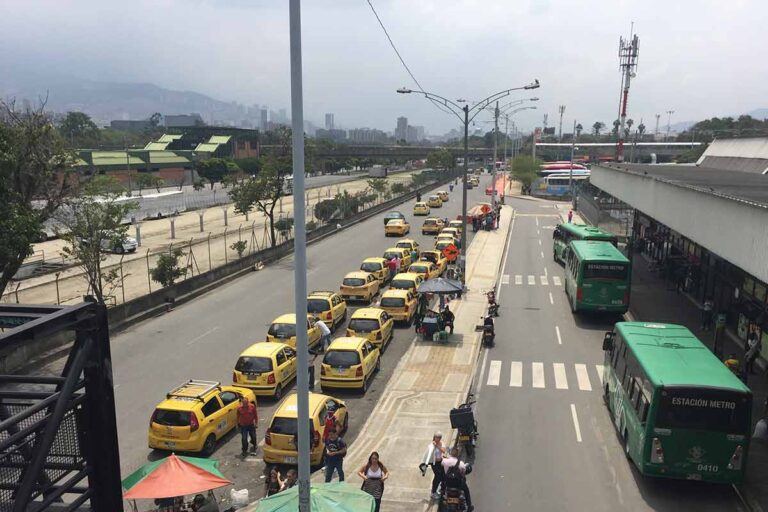
Is Medellín Safe?
Welcome to our Medellín safety guide. As one of the most popular cities to visit in Colombia, it is here we can have all kinds of awesome experiences. This includes visiting the infamous barrio of Comuna 13, which is an interesting way to learn about a different side of reality in the city of Medellín….
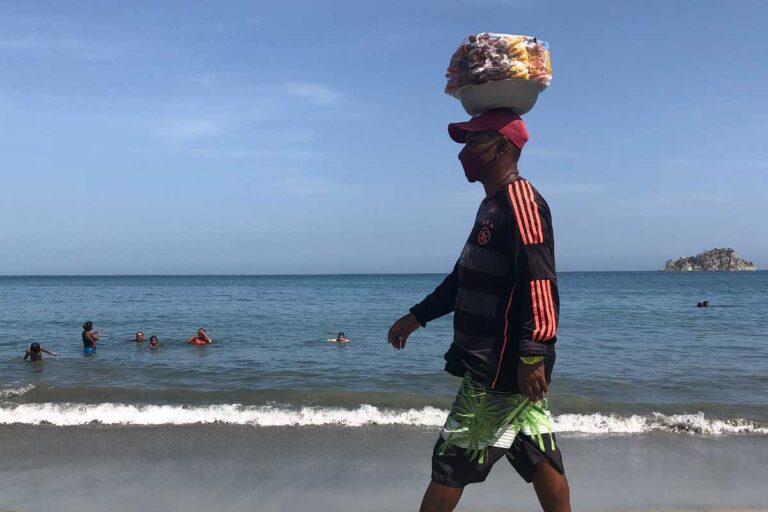
Is Colombia Expensive?
Is Colombia expensive and how much cash do you need while traveling here? Not only is it inexpensive to travel to from the United States, Colombia is one of the most popular countries to explore in South America and has endless adventures to offer. As well as enjoying the lively atmospheres, the climate is also…
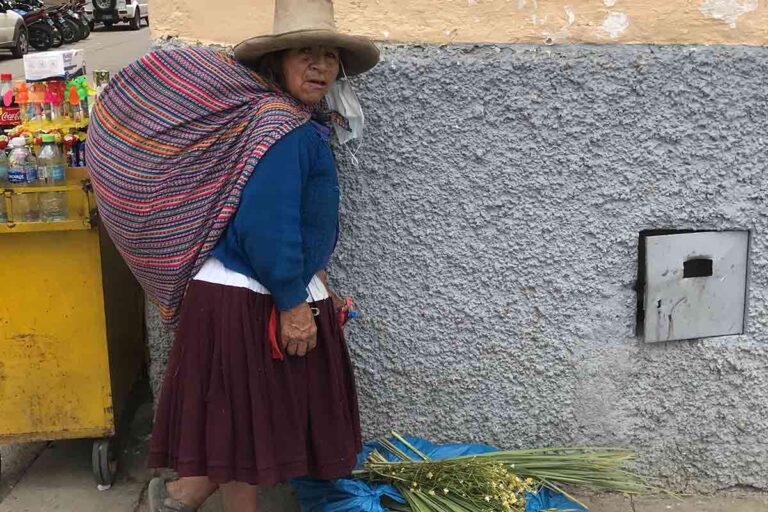
How many days in Peru?
How many days in Peru do you need to have a worth while experience? Let’s not beat around the bush, Peru has pretty much everything going for it. Everything from the electrifying sounds of the Amazon Jungle to hiking through the wild peaks of the Andes, even the most unimpressed of travelers will find it…
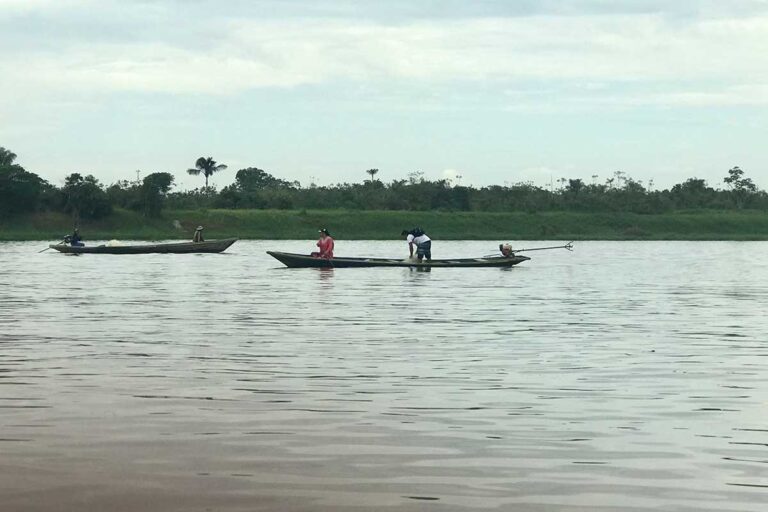
Is Peru worth visiting?
Is Peru worth visiting over other neighboring nations? Let’s be honest, Peru is without a doubt a memorable country to visit in South America. Whilst mostly known for its ancient ruins of Machu Picchu, here you can also find incredible landscapes and some really tasty food. This country is also home to one of the…
Santiago Travel Guide

15 Best Things to Do in Santiago, Chile
In Santiago, there are dramatic vistas at every turn – from the sprawling cityscape visible at the top of San Cristóbal hill to the ever-present Andes Mountains and their snow-covered slopes, which snake along the eastern horizon. Down below,
- All Things To Do

San Cristóbal Hill (Cerro San Cristóbal) San Cristóbal Hill (Cerro San Cristóbal) free
San Cristóbal Hill (Cerro San Cristóbal) stands nearly 3,000 feet above the rest of Metropolitan Park, a large swath of green spread between the neighborhoods of Providencia and Vitacura. The hill's height affords spectacular views to those who visit the summit. To reach the top of the hill, you'll need to hop on the funicular located on the north end of Pío Nono Street, which flanks the western side of Metropolitan Park. Or, if you're up for the challenge, you can strap on some hiking shoes and make the roughly one-hour climb up the hill from the base at Plaza Caupolicán, which is a quick walk from the Baquedano stop on metro Lines 1 and 5.
Regardless of whether you decide to make the journey to the top of the hill on foot or by funicular, you'll be rewarded with iconic photo-ops of the city below, as well as unrivaled views of the statue of the Virgin Mary at the summit. Recent visitors mentioned checking the smog levels before setting off and trying to plan the trip on clear days for the best panoramas.

Santa Lucía Hill (Cerro Santa Lucía) Santa Lucía Hill (Cerro Santa Lucía) free
A hilltop park on the eastern edge of downtown Santiago, Santa Lucía Hill (Cerro Santa Lucía) draws visitors with its panoramic views. To reach the top of Santa Lucía Hill on foot, head to the park's main entrance near the Santa Lucía metro stop. You'll know you're there when you find the mustard-yellow Neptuno Fountain. From here, follow the stairs to a narrow zig-zagging path punctuated by high stone steps.
Though the walk can be arduous (especially on a hot summer day), recent travelers remark that it's well worth the climb not only for incredible photo-ops, but also for the pleasant ambiance – complete with leafy promenades and castle-like fortifications. For the best views, walk all the way up to the Terraza Caupolicán, a hilltop terrace with buskers, benches and public art.

Sky Costanera Sky Costanera
The 62-story Gran Torre Santiago is the tallest building in South America, looming large over the city from the high-rise "Sanhattan" district. At the very top is Sky Costanera, a panoramic observation deck towering approximately 1,000 feet above street level with 360-degree vistas over the city, the Andes and the distant coastal range (smog-permitting). There's an alluring bar and coffee shop at the top, so you can enjoy a craft cocktail or latte with the view.
Down below is the Costanera Center, where many visitors report having a fabulous experience shopping and taking advantage of special discounts for foreign tourists. One of the largest malls in Latin America, this six-floor mecca is a fantastic place to stock up on supplies for trips further afield in Chile, with the city's best supermarket (Jumbo), department stores (including Falabella) and outdoor brands (like Doite), as well as a host of familiar international chains.

Popular Tours

Valparaiso Port and Vina del Mar Full-Day Tour from Santiago
(2525 reviews)
from $ 99.00

Maipo Valley Wine Tour with 4 vineyards from Santiago.
(661 reviews)

Inca Lagoon in Andes Mountain Range - Visit Local Vineyard with Tasting included
(634 reviews)
from $ 95.20

Lastarria Lastarria free
U.S. News Insider Tip: While in the neighborhood, be sure to stop by the bottle shop Santiago Wine Club to learn about Chile's boutique, organic and natural wines. The store has one of the city's best selections and frequently hosts tastings. – Mark Johanson
Lastarria may be small in size, spanning just four city blocks, but it makes a big impression on visitors as the most alluring neighborhood in Santiago's historic center. The nucleolus of the city's art scene, it's home to some of Chile's most important galleries and museums. Chief among them is the National Museum of Fine Arts (Museo Nacional de Bellas Artes), which has an impressive permanent collection and hosts rotating exhibitions throughout the year. Nearby is the Visual Arts Museum (Museo de Artes Visuales), which showcases the work of emerging Latin American artists, as well as the Gabriela Mistral Cultural Center (GAM), which displays contemporary art in the basement while staging theater and dance performances on the upper floors.

Metropolitan Cathedral (Catedral Metropolitana) Metropolitan Cathedral (Catedral Metropolitana) free
Flanking the western edge of the Plaza de Armas , this neoclassical cathedral has a history that stretches back to 1541, when Spanish conquistador and city founder Pedro de Valdivia requested a place of worship be constructed at the edge of Santiago's colonial square. However, throughout the three centuries that followed, the original building succumbed to numerous fires and earthquakes. The towering cathedral that stands today underwent construction around 1750, and in the 1780s, Italian architect Joaquín Toesca added a new twist: a blend of neoclassical style with baroque elements. The result is an interior that boasts intricate stained-glass windows and an elaborate altar ornamented with marble and deep blue lapis lazuli.
Although you'll have to battle dense crowds to see the interior of this church, recent visitors agree that the cathedral is a must-see thanks to its stunning floor tiles and frescoed ceilings. It can be a particularly evocative experience during religious celebrations, including Easter and Christmas.

Santiago Wineries Santiago Wineries
Wine connoisseurs love the aromatic vino and colorful scenery found in the Maipo Valley. A smattering of both big and boutique wine producers – renowned for their flavorful reds, especially cabernet sauvignon – can be found within an hour's drive of central Santiago. One of the Maipo Valley's most tourist-friendly vineyards is Viña Undurraga, which has an enchanting haceinda-style tasting room. Meanwhile, its most well-known winery is Concha y Toro. Situated in Pirque, a major wine-producing area about 15 miles southeast of Santiago, Concha y Toro pairs globally famous wines with flavorful small dishes and offers tours of its vineyards every day from 9 a.m. to 5 p.m. from 22,000 Chilean pesos (approximately $26) per person. According to recent visitors, the walks through the vineyard were quite nice, while the guides were exceptionally professional. For further details, visit Concha y Toro's website .
There are also a handful of venerable and up-and-coming wineries scattered across Chile's Casablanca Valley (about 50 miles northwest of Santiago). This region's wineries specialize in cool-climate grapes like sauvignon blanc and pinot noir. To arrange a trip to a variety of wineries across the valley without having to rent your own set of wheels, plan your trip on the Casablanca Valley Wine Producers Association website (Spanish only).

La Chascona Museum House (Casa Museo de La Chascona) La Chascona Museum House (Casa Museo de La Chascona)
For literary aficionados, no trip to Santiago would be complete without visiting La Chascona, the former residence of Noble Prize-winning poet Pablo Neruda. Named "La Chascona" – or the "Woman with the Tousled Hair" for Neruda's third wife, Matilde Urrutia, who was characterized by her red, wavy strands – the converted museum today houses a rare collection of Neruda's personal possessions, including a portrait of Neruda's third wife painted by Diego Rivera.
While you're free to explore the museum on your own, previous visitors recommend taking advantage of the audio guide tour (included in the cost of admission and available in a variety of languages, including English), which provides a rich background of Neruda's life, as well as some needed context. They add that, even if you're not a fan of Neruda, you should still plan a visit for the architecture alone. They also compliment the neighborhood the house is located in and say it houses several tasty restaurants.

Plaza de Armas Plaza de Armas free
Spanish conquistador Pedro de Valdivia (who founded Santiago) established this historic square back in 1541, creating a religious and political hub teeming with architectural treasures. Amid the many sights on display in the Plaza de Armas, you can't miss the graceful Metropolitan Cathedral set along its western border. You'll also stumble upon the former Governor's Palace, which has been converted into the city's main post office as well as the Historical Museum (Museo Histórico Nacional), which houses fascinating exhibits cataloguing Chile's history from the pre-Conquest period to the 20th century. Meanwhile, the plaza fills with musicians, artists, photographers, performers and street vendors on a daily basis, making this a popular spot to simply relax and soak up the city's culture.
A recent visitor found this palm covered square to be the soul of the city, with many museums within a few blocks, including the Chilean Museum of Pre-Columbian Art and the National History Museum of Chile. It is also, in recent years, a hub for Santiago's immigrant communities, with several Peruvian, Colombian, Venezuelan and Haitian restaurants nearby.

Santiago: Cajón del Maipo, Hot Springs, Waterfall & Chilean BBQ
(206 reviews)
from $ 210.00

Andes Tour to Portillo Inca Lagoon with San Esteban Vineyard Empanada & Wine
(260 reviews)

Full Day Group Tour - Viña Del Mar-Valparaiso -Casablanca -Reñaca
(720 reviews)
from $ 38.99

Bicentenario Park (Parque Bicentenario) Bicentenario Park (Parque Bicentenario) free
Bicentenario Park is one of the city's most serene corners, located along the southern edge of the Mapocho River in the heart of Santiago's ritziest enclave, Vitacura. Since it's shaded in perky palms and riddled with winding paths, it's as great for a picnic as it is for a leisurely stroll or a bike ride. Numerous events are staged here throughout the year, including design expos, wine fairs and craft shows. There are also open-air film screenings and occasional theatrical performances in the summer months.
Recent visitors praised the view back toward the high-rise "Sanhattan" district, noting that this park is one of the best spots in town to appreciate the capital's growing skyline. They also appreciate how clean and neatly manicured the grounds are, with sprawling playgrounds, swan-filled ponds and even a flamingo enclosure. Many visitors recommend capping off a visit with a meal (or pisco sour) at the park restaurant, Mestizo.

Museum of Memory and Human Rights (Museo de la Memoria y los Derechos Humanos) Museum of Memory and Human Rights (Museo de la Memoria y los Derechos Humanos) free
U.S. News Insider Tip: Five blocks east of the museum is one of the capital's most beloved restaurants, Peluquería Francesa, which serves French-tinged Chilean cuisine. Part old-school barbershop, part antique-filled eatery, dining here is like stepping back in time to the Santiago of yore. – Mark Johanson
If you're looking to learn more about General Augusto Pinochet's dictatorship, plan a visit to the Museum of Memory and Human Rights (Museo de la Memoria y los Derechos Humanos). The museum catalogues Pinochet's 17-year rule during the last Chilean military dictatorship, which resulted in the torture, murder and disappearance of thousands of Chileans. According to many recent visitors, the museum succeeds in increasing cultural awareness of the ways persecutions, imprisonments and torture during Pinochet's rule have had a ripple effect on Chilean society to this day. The museum pays tribute to the thousands of lives lost between 1973 and 1990 through photographs of victims, video coverage of protesters, and a host of legal documents, letters and artifacts from the late 20th century. According to recent visitors, the majority of the informational displays are written in Spanish. However, there is an audio guide you can download that includes narration in English. You'll have to pay 2,000 Chilean pesos (about $2) to access the audio guide, say recent visitors.

Barrio Bellavista Barrio Bellavista free
Beckoning an alternative crowd, the Bellavista neighborhood features graffiti-lined streets with restaurants, boutique shops and – more than anything else – late-night dance clubs. Here, you'll find inventive cocktail bars and eclectic eateries next to historic homes and colonial mansions. Spend some time exploring La Chascona – the former home of celebrated poet Pablo Neruda – before scouring the Patio Bellavista shopping area for souvenirs. Also, be sure to continue north to take in the scenery from Santiago's crown jewel: San Cristóbal Hill , a nearly 3,000-foot high hill tucked inside Metropolitan Park.
The vibrant nightlife, leafy parklands and laid-back vibes found in Bellavista make this a popular hangout spot among travelers and locals alike. It is particularly popular with backpackers and budget travelers, who have several character-rich lodging options. According to some recent visitors, the best way to experience the neighborhood is by wandering away from the main drag, Pío Nono, to search for the colorful homes and lavish art found on the side streets.

Chilean Museum of Pre-Columbian Art (Museo Chileno de Arte Precolombino) Chilean Museum of Pre-Columbian Art (Museo Chileno de Arte Precolombino)
Outdoor enthusiasts flock to the Andes' jagged peaks and wine lovers explore the Maipo Valley's spectacular vineyards . Meanwhile, art history buffs head to the Chilean Museum of Pre-Columbian Art (Museo Chileno de Arte Precolombino). The museum's permanent collection includes a diverse assemblage of pottery, sculptures and textiles from Mesoamerica, the Amazon, the Caribbean and Central and Southern Andes. Highlights include pieces from the Inca and Aztec empires and Chinchorro mummies, a funerary technique that's 2,000 years older than the Egyptian method. The temporary exhibits, which showcase everything from desert hats to weavings to rock art, are also worth visiting.
Travelers praise the museum for its versatile collection of artifacts and well-designed layout. Many are amazed by the extent and quality of the collection, noting that the museum is well designed. However, a few were disappointed that some of the descriptions are only labeled in Spanish. Others said the text is small and the lighting is dim, which they cited as other potential obstacles for reading the exhibition labels.

La Moneda Palace (Palacio de La Moneda) La Moneda Palace (Palacio de La Moneda) free
La Moneda is the palace of the President of the Republic of Chile, covering an entire city block with flag-filled plazas on either end. Originally the colonial-era mint, it only served that purpose for two decades before being converted to the seat of government it is today. The striking neoclassical building has been the site of many pivotal moments in Chilean history, including military strikes during the 1973 coup, during which the democratically-elected president, Salvador Allende, died by suicide inside.
Most visitors come to the palace today to see what's down beneath it. The subterranean La Moneda Cultural Center (CCLM) is a colossal space holding six galleries of varying sizes dedicated to photography, cultural heritage, design, children's programming, modern art and history. Exhibits change several times throughout the year and include a robust schedule of cultural programming. CCLM also includes the national cinema (which hosts art house film screenings), two cafes and several shops. Recent visitors raved about both the museum store and a gallery-like outpost of Artesanías de Chile, which sells fair-trade Chilean crafts sourced from the Atacama Desert and Patagonia.

Small-Group Cajón del Maipo Full-Day Tour and Picnic
(850 reviews)
from $ 39.90

Private Santiago Full-Day Layover Tour
(4 reviews)
from $ 246.00

Private Santiago City Half Day Tour
(334 reviews)
from $ 46.90

Central Market (Mercado Central) Central Market (Mercado Central) free
U.S. News Insider Tip: Just across the Mapocho River is Santiago's sprawling vegetable market, La Vega Central, where you can try local fruits (like cherimoya ), vegetables (like endemic Chiloé potatoes) and nuts (like piñones from the araucaria tree). – Mark Johanson
To get your seafood fix in Santiago, head straight to the Central Market (Mercado Central). Here, you'll find a festive atmosphere and top-grade fish. As you walk past the stalls and stands, you'll come across rarities like the giant abalone loco , prickly sea urchins and fleshy tunicates like piure , among other unconventional offerings. Venture to the center of the market to indulge in local cuisine – like ceviche and seafood empanadas – as you listen to live music. Even if you're not a fan of seafood, the Central Market is worth a visit: You'll find an eclectic assortment of fruits, vegetables and spices here as well. As you eat your way through the stalls, don't forget to admire the surrounding architecture. Set beneath a wrought-iron ceiling raised in 1872, the market impresses as much with its lively ambiance as its setting.

Santiago Ski Resorts Santiago Ski Resorts
U.S. News Insider Tip: The Andes above Santiago are also an excellent place for a hike, particularly in the shoulder seasons of spring and fall. Most visitors head to the Maipo Canyon where there are several public and private parks. – Mark Johanson
Just above Santiago – and visible on a clear day – are the Tres Valles Ski Resorts, which all lie high in the Andes between 8,000 and 12,000 feet above sea level in the mountain town of Farellones. La Parva is often considered the most exclusive of the resorts here, while El Colorado is more kid-friendly and family-oriented (though its snow park is billed as the best in the Andes). Valle Nevado, meanwhile, offers the largest skiable terrain in South America (more than 2,000 acres) and is a member of several multi-resort passes you can purchase in the U.S. It's also the resort most prepared to receive international visitors with bilingual workers and an English-language website.

Things to Do in Santiago FAQs
Explore more of santiago.

Best Hotels

When To Visit
If you make a purchase from our site, we may earn a commission. This does not affect the quality or independence of our editorial content.
Recommended
The 18 Best Napa Valley Wineries to Visit in 2024
Lyn Mettler|Sharael Kolberg April 23, 2024

The 25 Best Beaches on the East Coast for 2024
Timothy J. Forster|Sharael Kolberg April 19, 2024

The 50 Best Hotels in the USA 2024
Christina Maggitas February 6, 2024

The 32 Most Famous Landmarks in the World
Gwen Pratesi|Timothy J. Forster February 1, 2024

9 Top All-Inclusive Resorts in Florida for 2024
Gwen Pratesi|Amanda Norcross January 5, 2024

24 Top All-Inclusive Resorts in the U.S. for 2024
Erin Evans January 4, 2024

26 Top Adults-Only All-Inclusive Resorts for 2024
Zach Watson December 28, 2023

Solo Vacations: The 36 Best Places to Travel Alone in 2024
Lyn Mettler|Erin Vasta December 22, 2023

26 Cheap Beach Vacations for Travelers on a Budget
Kyle McCarthy|Sharael Kolberg December 4, 2023

The 50 Most Beautiful White Sand Beaches in the World
Holly Johnson December 1, 2023

- South America
- A One Week Itinerary To...
A One-Week Itinerary to Chile: Santiago, Valparaíso and Atacama

Discover some of the Chilean highlights with this itinerary that focuses on the two largest Chilean cities: the capital, Santiago , and the colourful Valparaíso . This itinerary also fits in a wine tour as well as a trip to the astounding San Pedro de Atacama.
Day 1: santiago.
Wake up in the heart of this bustling metropolis in one of Santiago’s chic hotels , enjoy a leisurely breakfast before embarking on a walking tour. Begin with the Presidential Palace of La Moneda, before heading to Plaza de Armas and Mercado Central. Gaze at the art in the Museo Chileno de Arte Precolombino and the Museo de Bellas Artes, then grab a coffee in one of Lastarria’s best cafés .
Once you’ve had a caffeine fix, amble up Cerro Santa Lucia that offers great views over the city, before strolling through Parque Forestal to Bellavista. Grab a bite to eat in Barrio Bellavista before discovering the quirks of Pablo Neruda’s Santiago house, La Chascona . After that you can visit the Santiago Zoo or hop on the funicular to the top of Cerro San Cristobal where you can witness the incredible sunset over the city. Discuss the highlights of your day over the national drink, a pisco sour.

Head to the bus station outside the Universidad de Santiago metro station and jump on the bus to Valparaíso for the day. Once you’ve arrived in this bustling port city, you can enjoy the murals of street art and the smell of the sea air.
Head towards Cerro Alegre and Cerro Concepcion where there are a number of cafés and restaurants, and each corner you turn boasts colourful street art. Dine on one of the terraces overlooking the bay and treat yourself to a pisco sour. After lunch, visit the beloved Chilean poet Pablo Neruda’s second house La Sebastiana. If you are visiting on the weekend, Valparaíso is known for its buzzing nightlife.

Day 3: Santiago & vineyard tour
History and politics fanatics should visit the Museum of Human Rights, although it is very sobering, it’s also very informative. You can also visit Calle Londres and Villa Grimaldi if you want to know more about what happened under the Pinochet dictatorship.
For a rather more relaxed afternoon, take a wine tour in one of the many fabulous vineyards, whether you go to Cousiño Macul, the humongous Concha Y Toro or the boutique Santa Rita, the afternoon will be spent learning about the wine-making process and of course wine tasting. Once you have returned to Santiago, choose from one of the many fabulous restaurants to dine at.

Day 4: Santiago to Atacama
Escape the busy Santiago by flying to Calama, from where you can easily get a transfer to the tranquil village of San Pedro de Atacama and enjoy the epic scenery as you journey through the jagged valleys of the desert. Settle into your hotel and relax before the Valle de la Luna afternoon tour. Here you will see some of the incredible vistas that Atacama has to offer, looking very similar to what you’d expect on Mars. Have a relaxed evening and eat some typical Chilean cuisine – we’d recommend Pastel del choclo before getting an early night in preparation for an early start.

Day 5: Atacama
Get up bright and early to visit the Geysers el Tatio – although don’t forget to wrap up warm and take some coca leaf tea, as it’s a great help with the altitude. The Geysers are located 4,320 metres above sea level, making them the highest geyser fields in the world. During the tour you will see a hot spring where you can relax, but just brace yourself for the cold as you get out. After an early morning, you deserve some R&R, and the Termas Puritama is the best place to do this – among the vegetation in the valley, the setting really is something else.
Spend the rest of the afternoon relaxing before going stargazing – the celestial sky really is magnificent in the Atacama desert as you are so far away from any big cities and their pollution, as well as experiencing darker skies and higher altitude. Learn from the astronomer how to read the sky and try to spot the rings of Saturn.

Day 6: Atacama
Another day in paradise, the penultimate day covers the incredible Piedras Rojas, Lagunas Altiplanicas, and the Salar de Atacama. These locations will spark the photographer in you, it’s virtually impossible to take a bad picture when the scenery is so stunning. Soak in the stretching blue lakes that magnify the towering snowy peaks of the Andes, followed by the red rocks that neighbour a milky green lake and finally the rugged salt flats where you will find the gorgeously pink flamingos pottering around. Treat yourself to a special meal in one of the many enticing restaurants in the heart of San Pedro, maybe even compliment it with a bottle of fine Chilean wine.

Day 7: Atacama to Santiago
Back to Santiago you go! After a busy week you deserve a relaxing final day, so head down to the quaint village-like Barrio Italia and enjoy some window shopping: peruse the interior design shops, independent fashion stores, and the antique markets before indulging in your last Chilean feast. Your last destination should be the Costanera Centre – this looming pyramid of glass is the tallest building in South America. Take a lift up to Sky Costanera and watch the sun set over the city.

Since you are here, we would like to share our vision for the future of travel - and the direction Culture Trip is moving in.
Culture Trip launched in 2011 with a simple yet passionate mission: to inspire people to go beyond their boundaries and experience what makes a place, its people and its culture special and meaningful — and this is still in our DNA today. We are proud that, for more than a decade, millions like you have trusted our award-winning recommendations by people who deeply understand what makes certain places and communities so special.
Increasingly we believe the world needs more meaningful, real-life connections between curious travellers keen to explore the world in a more responsible way. That is why we have intensively curated a collection of premium small-group trips as an invitation to meet and connect with new, like-minded people for once-in-a-lifetime experiences in three categories: Culture Trips, Rail Trips and Private Trips. Our Trips are suitable for both solo travelers, couples and friends who want to explore the world together.
Culture Trips are deeply immersive 5 to 16 days itineraries, that combine authentic local experiences, exciting activities and 4-5* accommodation to look forward to at the end of each day. Our Rail Trips are our most planet-friendly itineraries that invite you to take the scenic route, relax whilst getting under the skin of a destination. Our Private Trips are fully tailored itineraries, curated by our Travel Experts specifically for you, your friends or your family.
We know that many of you worry about the environmental impact of travel and are looking for ways of expanding horizons in ways that do minimal harm - and may even bring benefits. We are committed to go as far as possible in curating our trips with care for the planet. That is why all of our trips are flightless in destination, fully carbon offset - and we have ambitious plans to be net zero in the very near future.

Bars & Cafes
The top 10 bars in bellavista, santiago.

How This Chilean Bike Is Outsmarting City Bike Thieves

Places to Stay
The best hostels for backpackers in santiago, chile.

Guides & Tips
20 must-visit attractions in santiago, chile.

Follow These Santiago-Based Fashion Bloggers for Style Tips

The Best Places for Shopping in Costanera

The Best Hotels in Santiago, Chile

Restaurants
The 10 best restaurants in bellavista.

See & Do
A guide to lgbtq+ nightlife in santiago, chile.

The Top Art Galleries in Santiago

The Best Boutique Hotels in Santiago, Chile

The Top 9 Things to Do in Barrio Bellavista, Santiago
Culture trip spring sale, save up to $1,100 on our unique small-group trips limited spots..

- Post ID: 1668016
- Sponsored? No
- View Payload
Is Santiago Worth Visiting? 15 Reasons Why You Should [2024]
By: Author Ruben Arribas
Posted on Published: December 4, 2023 - Last updated: March 6, 2024
Categories Chile
Last updated on March 6th, 2024 at 06:20 am
Visiting Chile and deciding if is Santiago Worth Visiting? In this guide, we go in-depth with the pros and cons of visiting Santiago to let you decide.
Is Santiago Worth Visiting?
Absolutely, yes. Santiago, the capital of Chile, is a city that surprises many with its vibrant mix of modernity and rich cultural heritage. Nestled in the central valley, Santiago is framed by the awe-inspiring Andes Mountains, offering stunning views and easy access to outdoor adventures.
This city is not just a sprawling metropolis; it’s a gateway to diverse experiences, from skiing in the nearby Andean slopes to exploring the colorful street art in its urban neighborhoods.
Despite being overshadowed by more famous Latin American cities, Santiago holds its own as a destination rich in history, culture, and natural beauty. It’s a place where the past and present coexist harmoniously, making it a must-visit for anyone traveling through South America.
Let’s boil it down to 15 reasons why Santiago is worth your visit to Chile. And to make it fair, we also discuss the reasons why people think it’s not worth it, to give you a better way to decide.
Related Travel Guides
- How To Get From Santiago Airport to City Center Best Way
- 11 Best Traditional Breakfast in Chile
- 4 Days in Santiago de Chile
- Best Chile Sim Cards
Table of Contents
Why the Doubt – Is Santiago Chile Worth Visiting?
When considering Santiago as a travel destination, some travelers may hesitate, influenced by certain misconceptions and less exposure in popular travel narratives. Common doubts include:
Perceived Lack of Tourist Attractions
Compared to cities with famous landmarks, Santiago’s attractions are less known internationally, leading to the misconception that it lacks significant tourist sites.
Urbanization Concerns
As a bustling capital city, potential visitors might worry about issues like traffic congestion and the urban sprawl overshadowing the cultural and historical aspects.
Understated Historic Appeal
Unlike cities with a pronounced colonial past, Santiago’s mix of historical and ultra-modern architecture might lead to assumptions that it lacks traditional Latin American charm.
Cultural Misconceptions
The city’s cosmopolitan nature and modern lifestyle might not align with some travelers’ expectations of a typical South American cultural experience.
These doubts are natural, but as we’ll see, Santiago has a unique charm waiting to be discovered.
Top 15 Reasons that Make Santiago Worth a Visit
The majestic andes vista.
The Andes Mountains are a treasure trove for nature lovers – easily making a trip to Santiago worth it. It offers everything from tranquil hikes through lush valleys to challenging treks up to soaring peaks.
In winter, these mountains transform into a premier ski destination, with resorts like Valle Nevado attracting ski enthusiasts from around the globe.
For those less inclined towards physical exertion, scenic cable car rides provide breathtaking views of the city below, with sunset vistas being particularly spectacular.
Historical Richness of Plaza de Armas
This iconic square is the birthplace of Santiago, where the city’s history began – Santiago’s top sight to see! It’s surrounded by buildings like the neoclassical Metropolitan Cathedral and the historic Central Post Office.
Street performers, local artists, and chess players bring this square to life, offering a glimpse into the vibrant local culture – a worth it addition to Santiago’s allure.
Regular cultural events and exhibitions in and around the plaza make it a dynamic space that reflects the city’s past and present.
Barrio Bellavista’s Vibrant Street Art
Bellavista is a visual feast, where every wall and alleyway is adorned with murals that range from political statements to abstract art.
The neighborhood is also home to La Chascona, one of Pablo Neruda’s houses, now a museum, adding a literary layer to the area’s cultural richness.
At night, Bellavista transforms into a lively hub with a plethora of bars, clubs, and restaurants, each adding its own flavor to the area’s eclectic charm.
Culinary Delights in Mercado Central
Renowned for its fresh seafood, this market is a bustling hub where locals and tourists alike come to savor traditional dishes like caldillo de congrio and machas a la parmesana.
Food tours here offer an immersive experience, letting you sample a variety of local specialties while learning about their origins and preparation methods.
The surrounding area brims with small eateries and cafes, where you can relax and watch the daily hustle and bustle of the market.
The Elegance of Barrio Lastarria
This historic neighborhood is an eclectic mix of old and new, with beautifully preserved architectural gems sitting alongside contemporary art galleries and trendy boutiques.
The area’s cultural life is vibrant, with frequent art exhibitions, film screenings, and live music performances at venues like the Gabriela Mistral Cultural Center.
For a leisurely afternoon, the tree-lined streets offer cozy cafes and gourmet restaurants, perfect for people-watching and soaking in the local ambiance.
Parque Metropolitano’s Urban Oasis
This expansive park, one of the largest in Latin America, is a green haven in the heart of Santiago, offering a variety of recreational activities.
It features several attractions, including a botanical garden, two swimming pools, and the National Zoo, which houses a diverse range of wildlife.
The summit of Cerro San Cristóbal, accessible by foot, bike, or cable car, provides stunning panoramic views of the city and is home to the iconic 22-meter-tall statue of the Virgin Mary.
Valle de Colchagua Wine Tours
Renowned for its high-quality wines, especially reds like Carmenere and Cabernet Sauvignon, Valle de Colchagua offers a delightful escape for wine enthusiasts.
The wine tours here often include guided visits to multiple vineyards, each with its own unique history and wine-tasting sessions.
Many wineries also feature gourmet restaurants where you can pair exquisite wines with fine Chilean cuisine, all set against the backdrop of the picturesque Chilean countryside.
Pablo Neruda’s La Chascona
La Chascona, in the heart of Bellavista, offers a glimpse into the life of Nobel laureate Pablo Neruda, showcasing his eclectic taste and passion for the arts.
The house is filled with a fascinating collection of artwork and memorabilia, each with a story linked to Neruda’s life and work.
Guided tours provide insights into Neruda’s contributions to literature and his political involvements, making it a must-visit for literature enthusiasts.
Ski Resorts Near Santiago
The proximity of world-class ski resorts like Portillo, El Colorado, and Valle Nevado makes Santiago unique, offering thrilling winter sports just a short drive from the city.
These resorts cater to all levels, from beginners to advanced skiers, and often feature additional amenities like spas, restaurants, and shopping centers.
During the off-season, these areas become hubs for hiking and mountain biking, showcasing the Andes’ year-round appeal.
Cultural Richness at Museo Chileno de Arte Precolombino
This museum is a treasure trove of ancient art, exhibiting a vast array of artifacts from pre-Columbian cultures across Latin America.
Its collections include textiles, ceramics, and goldwork, offering a comprehensive overview of the artistic achievements of indigenous peoples.
Interactive displays and educational programs make this museum engaging for visitors of all ages, providing a deeper understanding of the continent’s rich cultural heritage.
Santiago’s Modern Skyline at Gran Torre Santiago
- The Gran Torre Santiago, part of the Costanera Center complex, stands as a symbol of Santiago’s modern architectural prowess.
- Visitors can ascend to the Sky Costanera observatory for unparalleled 360-degree views of the city and its surrounding landscapes.
- The complex also offers a myriad of shopping, dining, and entertainment options, reflecting the city’s growing cosmopolitan lifestyle.
Festivals and Cultural Events
- Santiago’s calendar is packed with a variety of festivals, from the vibrant Santiago a Mil theater festival to the renowned international film festival SANFIC.
- These events showcase a blend of traditional Chilean culture and contemporary arts, offering something for everyone.
- Local festivals like Fiestas Patrias celebrate Chilean heritage with music, dance, and traditional foods, providing an immersive cultural experience.
Shopping at Costanera Center
- The Costanera Center is not just the tallest building in Latin America but also a premier shopping destination, housing an extensive range of local and international brands.
- The mall also features a variety of entertainment options, including a cinema complex and a range of dining choices, from casual eateries to upscale restaurants.
- Its central location and comprehensive offerings make it a convenient and popular spot for both locals and tourists.
The Bohemian Charm of Barrio Italia
- Barrio Italia is a delightful mix of old-world charm and contemporary flair, known for its vintage furniture stores, independent art galleries, and artisan workshops.
- The neighborhood is also a culinary delight, featuring charming cafes and restaurants that offer a blend of traditional Chilean and international cuisine.
- Frequent cultural events, such as art openings and live music performances, contribute to the area’s vibrant atmosphere.
Nightlife and Entertainment
- Santiago’s nightlife is as diverse as its population, ranging from trendy rooftop bars in Providencia to vibrant nightclubs downtown.
- For a more laid-back evening, the city offers a variety of wine bars and jazz clubs, showcasing local and international talents.
- Cultural venues like the Centro Cultural Gabriela Mistral host evening events and performances, adding to the city’s rich nightlife offerings.
Reasons Why Santiago May Not Be Worth a Visit
Now of course even if we think Santiago is worth a few days of visit when you’re in Chile, we understand that there are reasons why people avoid it. And we’re here to lay down the details so you can decide
Busy City Life
Santiago’s fast pace can be a bit overwhelming at first, especially if you’re more accustomed to quieter places. The city’s energy is palpable, and while it’s part of its charm, it might not be everyone’s cup of tea.
To ease into it, try exploring the city during off-peak hours. Early mornings or late evenings can be quieter and more enjoyable.
And remember, there are plenty of peaceful retreats within the city, like the lush Parque Forestal, where you can unwind and take a breather from the urban buzz.
Air Quality on Certain Days
It’s true, Santiago’s air quality isn’t always perfect, especially in the cooler months when the city experiences thermal inversion.
On days when the air feels heavier, plan indoor activities. Santiago has an impressive array of museums, art galleries, and indoor markets that are worth exploring.
Also, consider trips to nearby coastal towns or the Andean foothills on such days, where the air is clearer and the scenery is a welcome change.
Language Hurdles
Navigating a new city where you don’t speak the language can be daunting, but it’s also an opportunity to learn and immerse yourself in a new culture.
In tourist areas, hotels, and restaurants, you’ll find many English speakers. Plus, simple Spanish phrases for greetings, directions, and basic transactions can go a long way.
Embrace the challenge! You’ll find that many Chileans are patient and helpful, and your efforts to speak Spanish, no matter how basic, will often be met with appreciation and encouragement.
If You Decide to Visit Santiago: Suggested Duration and Activities
So, you’ve decided to give Santiago a shot? Awesome! Here’s how long you might want to stay and what you can do:
Day Trip Wonders
If you’re short on time, a day in Santiago can still be fulfilling. Start with a morning walk in the historic center, exploring Plaza de Armas and the surrounding streets.
Grab lunch at Mercado Central, where you can enjoy fresh seafood and local flavors.
Spend your afternoon in Barrio Bellavista, soaking in the vibrant street art and maybe catching a glimpse of the sunset from Cerro San Cristóbal.
A Few Days to Immerse
With a few days in Santiago, you can really dive deep. Dedicate a day to exploring the city’s museums and cultural sites like the Pre-Columbian Art Museum and La Chascona.
Reserve another day for a wine tour in the nearby Maipo Valley, where you can indulge in some of Chile’s finest wines.
Don’t miss exploring the city’s diverse neighborhoods, each offering its own unique flavor – from the trendy shops and cafes of Lastarria to the peaceful greenery of Parque Metropolitano.
A Week or More for Full Exploration
If you’ve got a week or more, you’re in for a treat. You can take day trips to places like Valparaíso or the Andes mountains for skiing or hiking.
Dedicate time to leisurely explore Santiago’s culinary scene, from high-end dining experiences to local street food adventures.
Immerse yourself in the local culture by attending live music performances, visiting local markets, and even taking part in cultural workshops or language exchange meetups.
Santiago is a city that caters to all kinds of travelers, whether you’re there just for a quick visit or for an extended exploration.
Practical Tips for Your Santiago Journey – Is Santiago Worth Visiting
Where to stay in santiago.
- Providencia : Known for its blend of modern amenities and quiet residential streets, Providencia offers a range of accommodations from luxury hotels to cozy B&Bs. It’s well-connected by public transport, making it ideal for families and those who want a mix of tranquility and city life.
- Bellavista : For those seeking a vibrant cultural scene, Bellavista is perfect. Filled with colorful street art, lively bars, and eclectic restaurants, this neighborhood is great for younger travelers and art enthusiasts.
- Las Condes : Offering upscale accommodations, Las Condes is known for its shopping centers, business facilities, and fine dining, suitable for luxury travelers and business visitors.
- Centro Histórico : For history buffs, staying in the historic center near landmarks like Plaza de Armas and the Cathedral of Santiago offers a deep dive into the city’s past.
Top Places to Stay in Santiago
Browse the map below to see the best priced accommodations for Santiago, Chile.
Finding the perfect place to stay can make all the difference. Here are some top picks:
Luxury and Comfort in Las Condes
For a luxurious stay, Las Condes offers upscale hotels with stunning views of the Andes and excellent amenities.
Cultural Heart in Bellas Artes
Stay close to Santiago’s cultural pulse in Bellas Artes , ideal for those who love being surrounded by museums, galleries, and theaters.
Bohemian Flair in Bellavista
If a vibrant nightlife and artistic streets are your thing, Bellavista is the place. It’s lively, colorful, and full of character.
Chic and Trendy in Providencia
Providencia strikes a balance between trendy urban life and quieter, leafy streets. It’s great for shopping, dining, and exploring Santiago’s café culture.
Historic Charm in Barrio Lastarria
For a more intimate experience, Barrio Lastarria ‘s boutique hotels are nestled among historic buildings, offering a quaint and cozy stay.
Best Time to Visit Santiago
Timing can be everything when planning a trip. Here’s what to consider for Santiago:
Spring (September to November)
The city blooms with flowers and mild weather. It’s perfect for outdoor activities and exploring the city’s parks and gardens.
Summer (December to February)
Ideal for enjoying Santiago’s vibrant outdoor life and cultural festivals. Expect warm weather, perfect for day trips to nearby vineyards or the coast.
Autumn (March to May)
The city is less crowded, and the fall colors are beautiful. It’s a great time for wine tasting, as it’s harvest season in the vineyards.
Winter (June to August)
The best time for skiing in the Andes. Santiago can be cooler, but it’s a great time to enjoy the city’s indoor attractions, like museums and cafes.
Each season in Santiago has its own charm, making the city a great year-round destination.
Getting Around Santiago Chile
- Metro System : Santiago’s metro is one of the most modern in Latin America, with six lines covering key areas of the city. It’s a fast, safe, and affordable way to get around.
- Buses : The extensive bus network complements the metro, reaching areas outside the metro’s scope. Using a Bip! card for both buses and metro is recommended.
- Taxis and Ride-Sharing : Taxis are plentiful, and ride-sharing apps like Uber and Cabify offer convenient options for direct travel.
- Car Rentals : For more flexibility or for exploring beyond Santiago, renting a car is a good option. Keep in mind that traffic can be heavy, and parking in the city center is limited.
- Biking : With dedicated bike lanes and bike-sharing programs, Santiago is increasingly becoming bike-friendly, offering a fun way to see the city.
Is Santiago or Buenos Aires Better?
Choosing between Santiago and Buenos Aires depends on what you’re looking for:
- Santiago offers a unique blend of modern city life with stunning natural landscapes like the Andes. It’s perfect for outdoor enthusiasts and those who appreciate a mix of urban and natural experiences.
- Buenos Aires is renowned for its rich cultural heritage, vibrant arts scene, and iconic tango performances. It’s ideal for those interested in history, architecture, and a bustling city atmosphere.
Is Santiago, Chile Safe?
Santiago is generally considered safe for tourists, especially in the main tourist and business areas. Like any big city, it’s important to be aware of your surroundings, take standard safety precautions, and be cautious in crowded places. Common sense measures such as not flaunting valuables and staying in well-lit areas at night go a long way in ensuring a safe visit.
Is Santiago, Chile Expensive?
The cost of visiting Santiago can vary. It’s generally more affordable than many North American or European cities but can be more expensive compared to other South American destinations. Accommodation, dining out, and entertainment can be found to suit all budgets, from economical to luxury. Planning and budgeting in advance can help manage expenses effectively.
Our Final Thoughts and Conclusions if Is Santiago is Worth Visiting
So is Santiago worth visiting? For the historic and vibrant city center, it’s worth a day or two especially if it’s in your route in Chile.
Santiago is not just a city, it’s an experience. Its unique blend of natural beauty, cultural richness, and urban dynamism makes it an unmissable destination for any traveler. Whether you’re seeking adventure, culture, gastronomy, or just a new city to explore, Santiago promises memories that will last a lifetime. So, is Santiago worth visiting? Absolutely – it’s a city that surprises, delights, and welcomes all.
To sum it up, yes, Santiago is definitely worth a visit. It’s a city where you’ll find stunning nature, rich culture, and an exciting city life all rolled into one. Whether you’re into outdoor adventures, exploring arts and history, or just enjoying good food and wine, Santiago has got you covered. It’s a place that might surprise you with its variety and warmth. So, if you’re wondering whether to add Santiago to your travel list, our advice is to go for it – you won’t be disappointed!
FAQ: Santiago Travel Tips – Is Santiago Worth Visiting
Is santiago safe for tourists, what is the currency used in santiago.
The currency used in Santiago, and throughout Chile, is the Chilean Peso (CLP).
Can I get by with English in Santiago?
English is widely spoken in tourist areas and many Santiago residents have basic English skills. However, knowing some basic Spanish phrases can enhance your experience.
What are the must-try foods in Santiago?
Don’t miss trying empanadas, pastel de choclo, and local seafood dishes. Also, sample a pisco sour, Chile’s famous cocktail.
What are the best day trips from Santiago?
Popular day trips include the coastal cities of Valparaíso and Viña del Mar, the wine regions like Valle de Colchagua, and the Andean ski resorts.
Are credit cards widely accepted in Santiago?
Yes, credit cards are widely accepted in most restaurants, hotels, and shops. However, it’s a good idea to have some cash for smaller purchases and in less touristy areas.
What electrical plug type is used in Santiago?
Chile uses plug types C and L, and the standard voltage is 220 V.
What is the best way to get from the airport to downtown Santiago?
You can take a taxi, shuttle, or use the official airport bus service that connects to the metro system for easy access to the city.
What should I pack for a trip to Santiago?
Pack according to the season. For summer, bring light clothing and sunscreen. In winter, warm clothes are essential, especially if you plan to visit the Andes.
Is tap water safe to drink in Santiago?
Yes, the tap water in Santiago is generally safe to drink. However, if you have a sensitive stomach, bottled water might be a better option.
What are some common local customs I should be aware of?
Chileans are known for their friendliness. A common greeting is a handshake or a kiss on the cheek. It’s also polite to say ‘please’ and ‘thank you’ in Spanish.
About the Author : Ruben , co-founder of Gamintraveler.com since 2014, is a seasoned traveler from Spain who has explored over 100 countries since 2009. Known for his extensive travel adventures across South America, Europe, the US, Australia, New Zealand, Asia, and Africa, Ruben combines his passion for adventurous yet sustainable living with his love for cycling, highlighted by his remarkable 5-month bicycle journey from Spain to Norway. He currently resides in Spain, where he continues to share his travel experiences alongside his partner, Rachel, and their son, Han.
36 Hours in Santiago, Chile
By John Bartlett Updated Sept. 21, 2023
- Share full article

Because Santiago, Chile’s sprawling capital, is the gateway to some of the world’s greatest natural wonders — Patagonia, the Atacama Desert, Easter Island — many travelers understandably breeze through. It might not wow like Rio de Janeiro or Buenos Aires, but scratch the surface and the city is alive with music, art and nightlife, against the arresting backdrop of the Andes. Divisions still run deep, 50 years after Gen. Augusto Pinochet’s U.S.-backed coup d’état ushered in a 17-year dictatorship. Just four years ago, Chile exploded into cathartic and, at times, violent unrest, as hundreds of thousands of Santiaguinos protested social inequalities. The scars are there for all to see. But if you’ve made it all this way, you should give Santiago a chance to impress.
Recommendations
- A hike to the top of Cerro San Cristóbal offers the best views of the city and the Andes Mountains, particularly after rain has cleared the air.
- The Persa Víctor Manuel flea market boasts music, art and good food on Saturdays and Sundays.
- The Museo de la Memoria y los Derechos Humanos tells the story of General Pinochet’s dictatorship, and helps to explain the Chile you see today.
- La Pulpería Santa Elvira remixes seasonal Chilean classics and is one of Santiago’s most exciting restaurants.
- Salsoteca Maestra Vida , a two-room salsa club, gets going late and takes you through into the small hours.
- Blondie , a former cinema-turned-L.G.B.T.Q. nightclub, hosts a varied crowd.
- El Bajo is a plant-filled mezzanine bar beneath the GAM , an arts center in the historic Lastarria neighborhood that hosts exhibitions, book fairs and live events.
- Casa de la Cueca showcases Chile’s national dance, la cueca, and serves hearty dishes on the first Sunday of each month.
- El Portal Ex Bahamondes is the birthplace of the completo, Chile’s culinary obsession.
- El Franchute del Barrio is the lively setting for French-inspired weekend lunches.
- Café Escondido is a fun bar tucked down an alleyway in the city center.
- La Chascona , the former home of the poet Pablo Neruda, is stuffed with trinkets and collectibles.
- Factoría Franklin is a new arts and cultural space with stalls, creative workshops and AFA Galería , a modern art gallery.
- Centro Artesanal Los Dominicos , a former convent right at the end of L1 on the metro, is a one-stop shop for Indigenous handicrafts, leatherware and assorted artisanry.
- Metales Pesados and Ulises in the city center are two of Santiago’s finest bookstores.
- The Singular Santiago in Lastarria is an upmarket option with a smart rooftop bar and views towards Cerro San Cristóbal. Double rooms start from around 180,000 Chilean pesos, or about $204, for the night.
- The Hotel Boutique Castillo Rojo , in a renovated colonial mansion in the Bellavista neighborhood, is a boutique option with rooms starting from about 140,000 pesos.
- Hostal Forestal , a laid-back city center hostel, has private rooms with ensuite bathrooms starting from 32,000 pesos. A bunk bed in a six-to-eight-person dormitory costs about 12,000 pesos.
- Short-term rentals are abundant. Find somewhere along the metro’s L1 in Providencia or Lastarria to be close to the action.
- Uber and Cabify compete for ride-hailing traffic, and both are safe and reliable. Taxis are fine, too, but you’ll nearly always have to pay in cash — make sure the meter is running before you set off. The metro is extensive and safe, but as with any city, watch out for pickpockets. Buses rattle along all of the main routes and are relatively cheap and easy to use.
- Streetside bike rental (download the Bike Itaú app ) is a good option, but parking docks are concentrated in the wealthier neighborhoods. Be wary of disconnected bike paths and merciless bus drivers. On Sundays, many of the city’s main arteries are closed to cars for the Ciclorecreovía , an event that allows for leisurely exploration on foot and by bike.

More From 36 Hours
Have a weekend to explore a destination we’ve got the perfect travel itinerary..
Maui: The beauty and hospitality of this Hawaiian island, still recovering from last year’s wildfires, remain as vibrant as ever .
Toronto: Savor the diversity of this lakefront city through its hidden bars, small-but-fascinating museums and vibrant restaurants .
Cape Town: Take a food and storytelling tour, cruise one of the world’s most beautiful coastal drives and see contemporary African art in this city with stunning views in every direction.
Sarasota: Kayak through mangroves, take a Black history trolley tour and spot dolphins from a white-sand beach on Florida’s Gulf Coast.
Mérida: Rich in culture and history , this young and artsy Mexican city is an antidote to the wall-to-wall all-inclusive resorts of the Yucatán coast.
Advertisement
- About Career Gappers
- Our blogging journey
- Write for us
- Work with us

- Travel career break guide
- The decision stage
- The planning stage
- The preparation stage
- Career break travel tips
- Returning home: what next?
- Career break travel insurance
- Inspirational stories
- Career skills from travel
- Career gaps on your resume
- How to take a workation: complete guide
- What is remote working?
- Workation packages and deals 2023
- Remote work essentials
- Workation wellbeing benefits
- Remote work productivity tips
- Remote work quotes
- Barcelona workation guide
- Cornwall workation guide
- Hamburg workation guide
- Lisbon workation guide
- Mallorca workation guide
- Georgia workation guide
- New Zealand
- Career Gappers Facebook Community
- Interviews with career gappers
- Workations Facebook Community
Destinations
Is chile expensive here’s how much our trip cost.
Chile is a country of incredible landscape diversity, with the world’s driest desert in the north, giant ice fields in the south, and so much more beauty in between. But how much does a Chile trip cost? Is Chile expensive? In this article, we break down our Chile travel costs after our 23-day journey through some of the country’s highlights. Read on below to find out what we spent on transport, food and drink, accommodation, activities and sundries, as well as some tools you can use to help plan your Chile budget and tips for saving money.
This article contains links to products and services we love, which we may make commission from at no extra cost to you.
In this article:
Update: latest costs and budgeting tools
This article breaks down the costs of our Chile trip in late 2017, which was part of a year-long travel career break . Even though it’s been some time since this trip, the details of our spending and how it compared to other countries in the region is still very relevant to answering the question: how much does a Chile trip cost?
We recorded everything we spent throughout the journey so we could analyse it and share the information with other travellers.
In this breakdown, we show our costs in US dollars. Since the time of our trip, costs have fluctuated a little due to inflation and movement in the currency exchange rates. So, while this guide gives a snapshot of the typical costs of travel in Chile, you may need to allow a little more budget, and we recommend keeping an eye on the latest exchange rates at xe.com .
There are also some helpful tools you can use to help plan your costs in specific regions of Chile, as we explore below.
Planning your Chile budget
We always use Budget Your Trip when planning our travel budgets. It’s a handy tool that provides cost estimates for pretty much any location in the world, giving useful breakdowns by different areas of spending.
Budget Your Trip is particularly useful for countries like Chile where prices vary a lot depending on the region, as you can explore estimated costs for different towns and cities. You can begin with the tool below and see estimated costs based budget, mid-range and luxury:
Quick tips for travelling in Chile on a budget
Before we get into the details of our own Chile trip cost, we’ve brought together a few useful tips for keeping costs down when travelling in the country. Many of these were lessons we learned from mistakes along the way:
- ATMs in Chile typically charge a withdrawal fee. When we visited pre-pandemic we could sometimes find ATMs in the main cities that didn’t charge, but we now hear these have mostly disappeared. When you do need to pay withdrawal fees, withdraw the maximum possible amount to keep them to a minimum (but be careful with the cash!). Read more on ATMs and fees in Chile here .
- Take overnight buses for long journeys – it’s a cheap form of transport and saves on accommodation costs. Check out our guide to taking overnight buses like a pro for some tips.
- Cook your own food! Local markets in Chile are a fun experience. Try and book into accommodation that has good kitchen facilities.
- Take free walking tours (but give the guides a tip!). For example, Tours 4 Tips run brilliant free walking tours in Santiago and Valparaíso.
- Look after your belongings – crime is generally low in Chile, but pickpockets and scammers do operate in tourist areas, especially Santiago and Valparaíso. Check out this article on how to avoid tourist scams in Chile for more insight.
- Make use of lunch deals in restaurants.
- Look for camping options, especially in Chilean Patagonia.
- Book accommodation and transport in advance, especially when travelling in Patagonia, where services can get booked up quickly.
- Look out for discounts on activities – we got a group discount for our Valle de la Luna tour in San Pedro de Atacama as we were in a group of six.
What our Chile trip cost: an overview
In total we spent 23 days in Chile, including the capital Santiago and nearby coastal city Valparaíso ; San Pedro de Atacama and the Elqui Valley to the north; and Torres Del Paine National Park in Chilean Patagonia. This analysis covers our entire expenditure during this trip, including accommodation, transport, food and drink, activities and sundries.
Most of the money we spent was in the national currency, Chilean pesos. However, as I have outlined above, for formality I have converted all costs into US dollars. All the costs I have detailed are for two people given that we travel as a couple, but where relevant I have shown single unit costs.
Our travel style
Not everybody has the same travel style and budget, so let me tell you about ourselves to give all of this a little context. We are a couple from the UK in our mid-30s. Our backpacking adventures in Chile were part-way through a one-year, round-the-world travel career break.
We travel on a fairly mid-range budget. We are not luxury travellers by any means, but nor do we scrape by on a tiny budget – we like to save enough for trips so we can enjoy some comforts. We tend to prioritise activities and experiences with our spending, which means that we look for savings in other areas, such as transport and accommodation. We’d rather stay in hostels and take public transport if it means we can do more tours and eat great local food.
For a complete overview of what we spent on our entire travel career break, check out our article on how much it costs to travel the world .
The overall cost
Let’s cut straight to the big figure. During our 23 days and nights in Chile, we spent $2,697 , which equates to $1,348.50 each.
I must point out here that a large chunk of this spending in Chile went towards undertaking the W Trek hiking trail in Torres Del Paine National Park. The costs directly associated with this amounted to $600.60. That’s 22.7% of our total Chile spending, when the trail only took up 17.39% of the time.
To put it another way: our total daily costs in Chile were $117.26 for the two of us, but if you remove the W Trek our total daily costs were $110.33.
If you plan to head to Chilean Patagonia on your trip, our guide to hiking the W Trek includes the latest season’s costs associated with the trail, including entrance, transfers and accommodation.
It’s also worth noting that Chilean Patagonia in general was more expensive than the other parts of the country we visited. I cover that in more detail below. But, as you will see, regardless of whether or not we include the Patagonia segment of our trip, Chile was the most expensive of the seven countries we visited in South America.
Our basic Chile travel itinerary
Our journey through Chile was not completed in one single stretch. We crossed back and forth across the border several times between Chile and Argentina.
This creates some slightly grey areas when calculating the number of days we spent in the country and apportioning transport costs, but wherever there may be any confusion in the analysis I have outlined my methodology below.
This is an approximation of the amount of time we spent in each destination in Chile:
- San Pedro de Atacama: 5 days
- Santiago: 5 days (split between two visits)
- Valparaíso: 3 days
- Elqui Valley: 2 days
- Punta Arenas: 1 day
- Puerto Natales: 3 days
- Torres Del Paine W Trek: 4 days
For more details about our route, you can read our suggested itinerary for two weeks in north and central Chile .
Is Chile expensive compared to other South American countries?
In total, we visited seven countries in South America during a five-month trip: Peru, Bolivia, Chile, Argentina, Brazil, Paraguay and Uruguay.
The graph below shows our basic travel living costs – food, drink and accommodation – in each country:
Chile was the most expensive country of our trip, with daily living costs of $ 76.65 . This is almost double our daily costs in the cheapest country we visited, Paraguay.
Note that even if we remove the W Trek costs from our daily spending in Chile and recalculate, it still remains the highest at $73.49 per day.
Chile travel costs by category
The graph below shows how our total Chile costs break down into different categories:
It’s interesting to note that in comparison to other countries in South America we have analysed, the basic living costs in Chile account for a much higher proportion of the total costs. The combination of food, drink and accommodation combined accounted for roughly two-thirds of our expenditure in the country
Less than 10% of our expenditure in Chile was on activities, whereas in Peru and Bolivia activities accounted for about half of what we spent. This is mainly because in Peru and Bolivia we did some big-ticket activities like hiking the Inca Trail and touring the Uyuni salt flats , whereas in Chile we had a great time doing lots of free or cheap activities like museums, walking tours, cycling and hiking.
Now, let’s take a closer look at each of these categories.
Accommodation costs in Chile
With the exception of four nights’ camping on the W Trek, we stayed in hostels everywhere we went in Chile.
We love hostels because they are cheap, great for meeting people and usually a fantastic source of information about the local area. But while we look for cheap rates wherever we can, we don’t compromise on certain factors such as location and security.
Our total expenditure on accommodation in Chile was $659.10 , of which $100.10 was for our campsites on the W Trek.
The average cost for hostels per person per night (PPPN) during our Chile trip was $14.72. Here’s a look at how that compares with the other South American countries we visited:
Again, Chile comes out as the most expensive. Note that Patagonia as a region is spread across both Chile and Argentina – you can read about our Patagonia trip costs separately here .
The average hostel cost during our whole time in South America was $11.87 PPPN. Therefore, our hostel costs in Chile were 24% above the average for the continent.
We found, unsurprisingly, that hostels in the bigger cities in Chile were cheaper than those in more remote locations. For example, our hostel in the Elqui Valley was $20.15 PPPN, and our hostel in Puerto Natales (the small town near Torres Del Paine) was $18.2 PPPN. This compares with just $14.3 PPPN at a Santiago hostel, and $10.40 PPPN at a Valparaíso hostel.
Food and drink costs in Chile
Food and drink was our biggest expenditure in Chile, amounting to $1,103.70 in total, which breaks down to $47.98 per day. Even when removing the W Trek, this figure is still pretty high at $44.06 per day.
This is especially significant when considering that we cooked our own food a lot more in Chile than in other countries we visited. Dining in restaurants was very much a treat.
We do enjoy a drink, and Chile is renowned for its excellent wine (and less renowned for its beer, which is nonetheless fantastic). We spent $248.30 on alcohol during our travels in the country, which accounts for 22.5% of our food and drink costs.
In many of the destinations we visited in South America we had to buy bottled water; in Chile this was only the case in San Pedro de Atacama. As such, we only spent $7.80 on bottled water.
Restaurant cost examples
Drawing on the few occasions we did treat ourselves to a meal out in Chile, here are a few examples of the prices for dining out. Costs are shown for two people in US dollars (USD) based on the exchange rate at the time of our trip:
- Special lunch deal (selection of rolls, dumplings and a soft drink) at Yama Sushi, Santiago: $16.90
- Miso soup, main dishes and soft drinks at Sui Hwa Chinese restaurant, Santiago (Brasil district): $26
- Meat sandwiches and soft drinks at Fuente Alemana , Santiago: $22.10
- Two-course meal with a bottle of wine in Almacén Nacional, Valparaíso: $45.50
- Pizzas and soft drinks at Pizza El Charrua dinner in San Pedro de Atacama: $22.10
- Two-course meal including special Chilean lamb BBQ main and two beers each at El Asador Patagónico, Puerto Natales (this was a special treat after completing the W Trek): $75.40
- Pizza wedding anniversary lunch with two beers each at Mesita Grande, Puerto Natales: $45.50
Transport costs in Chile
In total we spent $443.95 on transport in Chile, of which $352.95 was on buses and $57.20 on a ferry transfer at the end of the W Trek. The small remainder was split between taxis, public transport and bicycles.
Chile is long and narrow in shape, which means that travelling between destinations often involves significant distances. For example, from Santiago to the hub city of Calama in the north, it’s a 21-hour bus ride.
As I mentioned above, we didn’t traverse directly through Chile; instead, we zig-zagged between Chile and Argentina. As such, to calculate Chile travel costs, I have split the amounts for cross-border journeys between the two countries.
Here are a few examples of bus routes we took, including the full journey cost for one person:
- San Pedro de Atacama (Chile) to Salta (Argentina) with Andesmar : $37.70
- Mendoza (Argentina) to Santiago (Chile) with Buses Ahumada : $29.90
- Santiago to Valparaíso with Turbus : $6.50
- Santiago to La Serena with Pullman Bus : $22.10
- La Serena to Pisco Elqui with local transfer bus: $6.50
- Ushuaia (Argentina) to Punta Arenas (Chile) with Taqsa : $43.55
- Punta Arenas to Puerto Natales with Bus Sur : $11.05
- Puerto Natales (Chile) to El Calafate (Argentina) with Bus Sur: $27.30
- Bus and shuttle from Puerto Natales in Torres Del Paine National Park: $27.95
For the longer journeys we always found it best to book online in advance. Busbud is a great online service for comparing prices and booking. For more information about getting around Patagonia specifically, check out our guide to how to get around Patagonia by bus .
Activity costs in Chile
In Chile, we did a range of fun activities while only spending $250.90 during our 23 days in the country.
I’ve already mentioned that the Torres Del Paine W Trek was a significant expenditure in Chile. However, most of the costs associated with it were transport, food and accommodation. The only cost that goes into the ‘activities’ column of our records is the $33.15 national park entrance fee per person, and everything else into the other relevant sections.
Here are some examples of other activities we did in Chile and the costs per person:
- Stargazing tour in Pisco Elqui: $23.40
- Tips for guides on three walking tours (one in Santiago, two in Valparaíso): $33.80
- Museum of Memory and Human Rights, Santiago: $3.90
- Meteorite Museum, San Pedro de Atacama: $3.90
- Valle de La Luna tour and entry fee: $16.90
- Torres Del Paine National Park entrance: $33.15
Additional costs in Chile (sundries)
Any costs that don’t fit clearly into the main categories detailed above we class as sundries. In total we spent $239.20 on sundries in Chile, which included:
- $75.40 on general items, which included some accessories for the W Trek
- $46.80 on laundry
- $45.50 on cigarettes and tobacco
- $26 on gifts and souvenirs
- $23.40 on money charges
- $11.70 on clothes (extra socks for W Trek)
- $10.40 on toiletries and pharmaceuticals
Have you been to Chile? Let us know about your experience in the comments below.
Love it? Pin it!
Alex trembath.
Alex is the co-founder and lead content creator at Career Gappers. He is an award-winning communications leader with 20 years of leadership experience, a career that has taken him across the world working with international organisations. Alex has travelled to over 50 countries and is a passionate advocate for blending work and travel by taking career breaks, sabbaticals, workations and business trips.
15 thoughts on “ Is Chile expensive? Here’s how much our trip cost ”
This is so useful – I’m heading to Chile in a few months and was really worrying about how much it would cost – especially Patagonia. Got a much better idea now, thanks!!
This is so useful! I’ve been wanting to plan a trip there for a long time!
This is really useful. Would love to visit Chile after reading your post. Thanks for sharing.
A to Z information provided for travelers thinking of exploring Chile in this post. Wonderful detailed post.?
Alex this is a very informative and detailed post, thank you. I am grabbing experiences and budget ideas from different blog posts and this one is what I was looking for!
It was great to learn more about your trip and chile! I wish the currency were in pounds but it still helped.
This is such a detailed breakdown of your money spent! I can imagine that Patagonia is a more expensive place, but I’m sure the views were worth the extra spent!
Hi! So cool you shared all your travel costs. It shows that with the right amount of planning and some compromises, you can make it to your dream country. Thanks for sharing! Happy travels!
Such a great blog post and detailed too. Loved the graphs that you got in this. I plan to do patagonia as well and i was adamant about how much everything will cost. Id say you got things done cheaper than most people we have talked to. Will definitely use this as a reference. I clicked through other links about Patagonia. Very helpful insights indeed.
Another great, detailed post with a lot of useful information. I have always wanted to visit Chile and explore more of Latin America and hopefully, I will soon. Thanks for sharing this detailed guide about Chile, I’ll keep it bookmarked until I decide to visit.
Excellent post Alex! I and my family travel very much in a similar manner as you both when it comes to managing money. Love the inclusion of graphs to go along which makes everything seem easier to understand for a person like me who is not too inclined towards planning about costs beforehand. This post is a great help for anyone who is heading or planning a trip to Chile. Sharing it!
Thank you for your useful information! As I see, your travel style is quite similar as ours, so it is very helpful, if we go to Chile in the future. Generally, from all that I read, South America is still a quite cheap continent, even Chile.
…yet another South American country to visit! Chile must be amazing – I’d particularly like to visit the northern part towards Peru. However, I can afford South America only every other year – so after next year it might be: Chile, here I come!
So wonderful when people take so much of their time to help others in such a detail and easy way. I did bikepacking in southern Patagonia plus did some of the famous hikes and found it to be quite expensive. Some stuff were actually more expensive then in Canada such as brand name clothes etc
Thank you for the feedback Karim, glad you found the blog useful! We haven’t been to Canada before but we hope to at some point in the near future. Patagonia is definitely the most expensive region of South America we’ve been to – but it was so worth it for that scenery!
Leave a Reply Cancel reply
Your email address will not be published. Required fields are marked *
This site uses Akismet to reduce spam. Learn how your comment data is processed .
- USA/Canada 1-888-232-3813
- Walking & Hiking
- Wildlife and Nature
- Multiactivity
- Photo Safari
- Excepcional Journey
- Water Adventures
- Food & Wine
- City Escapes
- Winter Adventures
- EcoCamp Patagonia
- Argentine Patagonia
- Chilean Patagonia
- Atacama Desert
- Santiago and Central Valley
- Easter Island
- Lake District
- Multidestination
- Northwest Argentina
- Uyuni Salt Flats, Bolivia
- For Families
- For Couples
- For Friends
- For Solo Travelers
- Central Valley
- Wildlife & Nature
- News & Awards
- Sustainability
- Outdoor Sports
- Yoga & Wellness

12 Things You Must Know Before You Travel to Chile (2022 Updated)
Posts by tag.
- Patagonia (76)
- Inspire (50)
- Wildlife & Nature (28)
- News & Awards (25)
- Outdoor Sports (21)
- Food & Wine (20)
- Central Valley (16)
- Culture (14)
- Atacama Desert (13)
- Sustainability (8)
- Lake District (5)
- Yoga & Wellness (5)
- Easter Island (3)
- Bolivia (1)
Last Update : July, 27th 2022
Planning a trip to Chile?
2020 was a bad year for travelers, with most borders being closed as “stay home” became the norm. And while most of us started traveling from home (thank you, internet), nothing will ever replace a trip to a beautiful place .
And if you’re thinking about Chile, you probably know this is one of the most beautiful destinations on the planet . But there’s so much to learn about our favorite country in South America. Here’s a quick guide so you can get familiar with Chile and get ready for a trip of a lifetime with some useful information.
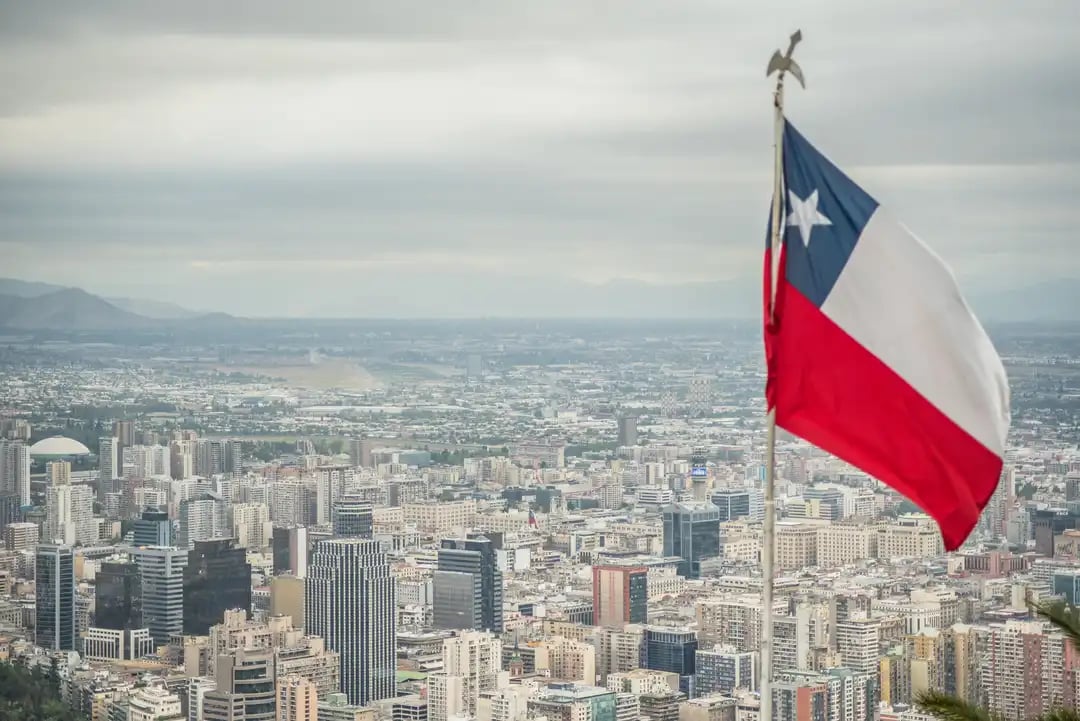
¡Buen viaje!
1. Chile is amongst the safest countries on Earth
2. chile is more expensive than its neighbors, but incredibly rewarding, 3. chile is covid-19 vaccination champion in south america, 4. if you plan an adventure in chile, you may have to train first, 5. the best time to travel to chile is not always when you think, 6. distances in chile are long, 7. chileans speak a very unusual spanish, 8. border crossing to argentina can be tricky in some places, 9. the visa and vaccines you need to travel to chile, 10. chileans have some curious social rules, 11. how to eat like a chilean in chile, 12. these are the best places to visit in chile.
Chile is a very safe destination for travelers in South America. According to the Global Peace Index (updated every year), Chile currently ranks as the 27 th safest country on the planet. It is usually considered the safest country in South America, together with Uruguay. Thanks to its low crime rates and nice behavior towards travelers, the “thin country” can be considered a very safe destination (especially if you visit its spectacular national parks).
Chile is the most developed country in South America , and some travelers like to talk about it as the “most European-like country in Latin America”. It is therefore an expensive country compared to its neighbors Bolivia, Peru and Argentina, and you should take a look at the updated exchange rate before you travel to Chile (the local currency is the Chilean peso).
To give you an idea, restaurant costs are on a par with the US for similar level restaurants. Prices vary tend to vary a lot from a place to another (for instance, prices in Patagonia are usually higher than the ones in central Chile). But whether it has to do with the food or with the excursions, it is usual to get more than what you pay for ! There is some excellent Chilean cuisine and both the guides and the travel experiences are incredibly rewarding.
And if you’re on low budget, don’t worry! There are plenty of alternatives, such as simpler restaurants and delicious street food; and more accessible travel experiences.

Worried about COVID-19? We are too! However, we are optimistic regarding the near future as Chile became a COVID-19 vaccination champion in South America . Health experts and government officials credit the country’s early negotiations with vaccine producers and in July 2022, more than 90% of the objective population was vaccinated (with up to 4 doses!). The country of 19 million inhabitants is an example in Latin America , often named in world’s Top 3 together with Israel and the United States.
Check out the complete guide on what you need to travel to Chile during the COVID-19 pandemic here.
Despite the intensity of the coronavirus waves that have hit the country, the country is already a "new normal". These are great news for tourism, isn’t it?
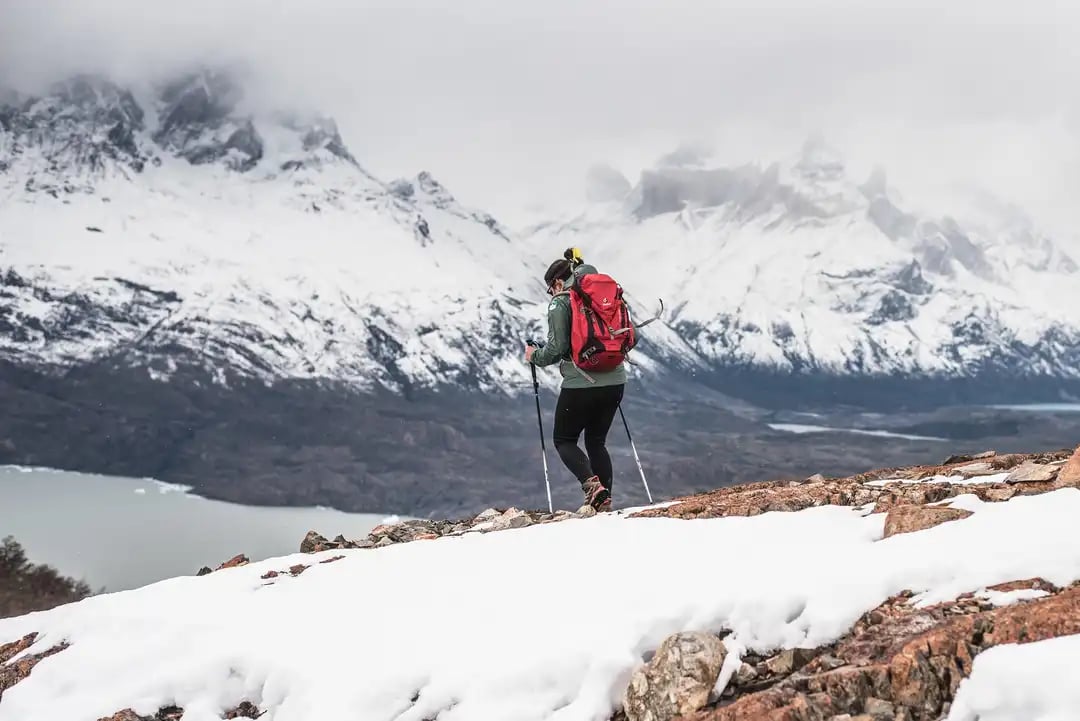
Chile is amongst the best adventure travel destinations in the world. It was awarded 6 times as the “World’s Leading Adventure Travel Destination” in the World Travel Awards , the “Oscars of tourism”. But be careful when it comes to choosing your adventure! Some of them are really demanding and require some previous training.
Some experiences are accessible for everyone , like a trip to the Atacama Desert or a Wildlife Safari in Torres del Paine National Park . However, Patagonia’s most popular multiday hikes are quite demanding. The W Trek requires at least some regular trail walking. As for the epic “O Trek” (Torres del Paine Circuit), the Dientes de Navarino Circuit and the Cerro Castillo Circuit , these are for the experienced hikers only. The terrain is irregular, hiking distances are long and include some steep uphill. In short, you’d better check out the details on the level of difficulty of the trip you’re interested in before taking the final decision.
Chile is a land of extremes. You’ll find the driest desert on Earth in north (the Atacama Desert) and the world’s third freshwater reserve in the south (the Patagonian ice fields). That’s what makes Chile a hard place to understand when it comes to scheduling a trip.
While most people think there is no rain at all in northern Chile, there may be some occasional heavy rain fall in summer, especially between December to March. This is due to the Altiplanic winter, a phenomenon that can cause storms in the Arica and Parinacota and in the Atacama regions.
In Patagonia, summer months (from December to March) are the busiest ones, but also the windiest. There is a “ best time to come ” for everyone, and this is how we could sum it up.
Best outdoor adventure weather: November to March
Best time to avoid the crowds: April to October (note: it may be difficult to find accommodation due to off-season from June to August).
Best time to spot wildlife: April to November
Chile extends 4,270 km (2,653 miles) from North to South, with an average of 177 km (110 mi) from East to West. Traveling from the Arica region to southern Patagonia would be the same as traveling from northern Scandinavia to Morocco!
You’ve got it: distances are long, and domestic flights usually take a few hours (for instance, it takes roughly 3,30 hours to get from Santiago to Punta Arenas). Besides the hours spent flying, you will also have to drive a lot, especially if you head to Patagonia. Getting to EcoCamp Patagonia from the Punta Arenas airport requires a 5 to 6-hour drive (a beautiful one)!
And if you plan to travel to Easter Island, remember that the “world’s most remote island” is located 3.759km (2.335mi) away from Santiago (a 5-hour and 40-minute flight).
“Cachai” “Piola” “Weon” “Bacán”: if you speak Spanish but do not understand these words, don’t worry! Chileans may speak the most peculiar Spanish in the world . The Royal Spanish Academy recognizes 2,214 words and idioms exclusively or mainly produced in Chilean Spanish, in addition to lots of unrecognized slang expressions.
But no panic! Chileans love to communicate with tourists and I bet you’ll be able to understand each other, even if you don’t speak Spanish at all.

Chile and Argentina are separated by a huge natural boundary : the Andes mountains. In Patagonia, the mountains get lower but the terrain is irregular, with lots of channels, ice fields and islands. At the border between Villa O’Higgins (Chile’s Aysén Region, the southernmost point of the Carretera Austral), vehicles are inaccessible. Here, you’ll have to take a boat, get a horse and walk 35 kilometers (22mi) if you want to cross to Argentina.
In most places, the immigration offices between both countries are miles apart, but crossing is easy if you have your own transfer or vehicle. If you travel by yourself, you should consider that some parts of Patagonia have no public transport to go through the border.
You won’t need a visa if you stay less than 90 days in the country (do not lose the small paper the immigration authorities will give you while entering Chile).
However, having your updated COVID-19 vaccines to enter the country is strongly recommended. While a negative PCR upon arrival is not compulsory any more, having your updated COVID-19 vaccines will allow you to get a "mobility pass" which is mandatory to enter many public places such as bars, restaurants and movie theaters ( more information here ).
Also, you must declare all products of plants and animal origin while entering into Chile (non-compliance with this obligation can be expensive!).
“Go to Chile and you’ll be welcomed with open arms” . This is a true statement. It is also true that Chileans have some traditions, mannerisms and customs that may leave you confused. Some of the funniest facts? Chileans add “-po” to virtually every word (for emphasis or just because locals feel like it). Chileans have lunch at around 2pm, and have “elevenses” in the evening. What does that mean? Well, it’s like having an afternoon tea, accompanied by bread with avocado, jam, paté or ham.
Everything stops for a football game , so streets may seem empty when Chile plays (but wait for the celebration if Chile wins!).
Finally, Chile is a seismic country. Chileans say there’s an earthquake only if it’s over 6 on the Richter scale . If it’s under 6 on Richter, some Chileans don’t even feel it. In these cases, they say it’s only a “temblor” (tremor).

There’s a new culinary world awaiting to be discovered in Chile! There is a rich and diverse range of dishes for everyone’s taste, though the famous ingredients include plenty of seafood (coastline), avocado, beef (the whole country) and lamb (Patagonia). There are also some amazing indigenous influences you will find in some regions (such as the Atacama Desert and the Araucanía region with the Mapuches), and you can get some incredible gourmet food in Chile’s main cities, especially in Santiago.
But the spirit of Chile can be tried on the street. You should definitely try the empanada (little puff pastry baked in the oven), the humita (corn mixed with onion and basil, in a preparation that is wrapped in maize leaves) and the completo (a local version of the hot-dog, that includes avocado).
No trip to Chile would be complete without an “asado”, a barbecue. “Asados” are the best excuse for Chileans to gather, making it the most important social occasion held all year round.
As for the beverages, Chile is worldwide famous for its delicious wine. You should also try the Pisco – a brandy produced in wine regions of Chile and Peru. And Chile also has some delicious beer!
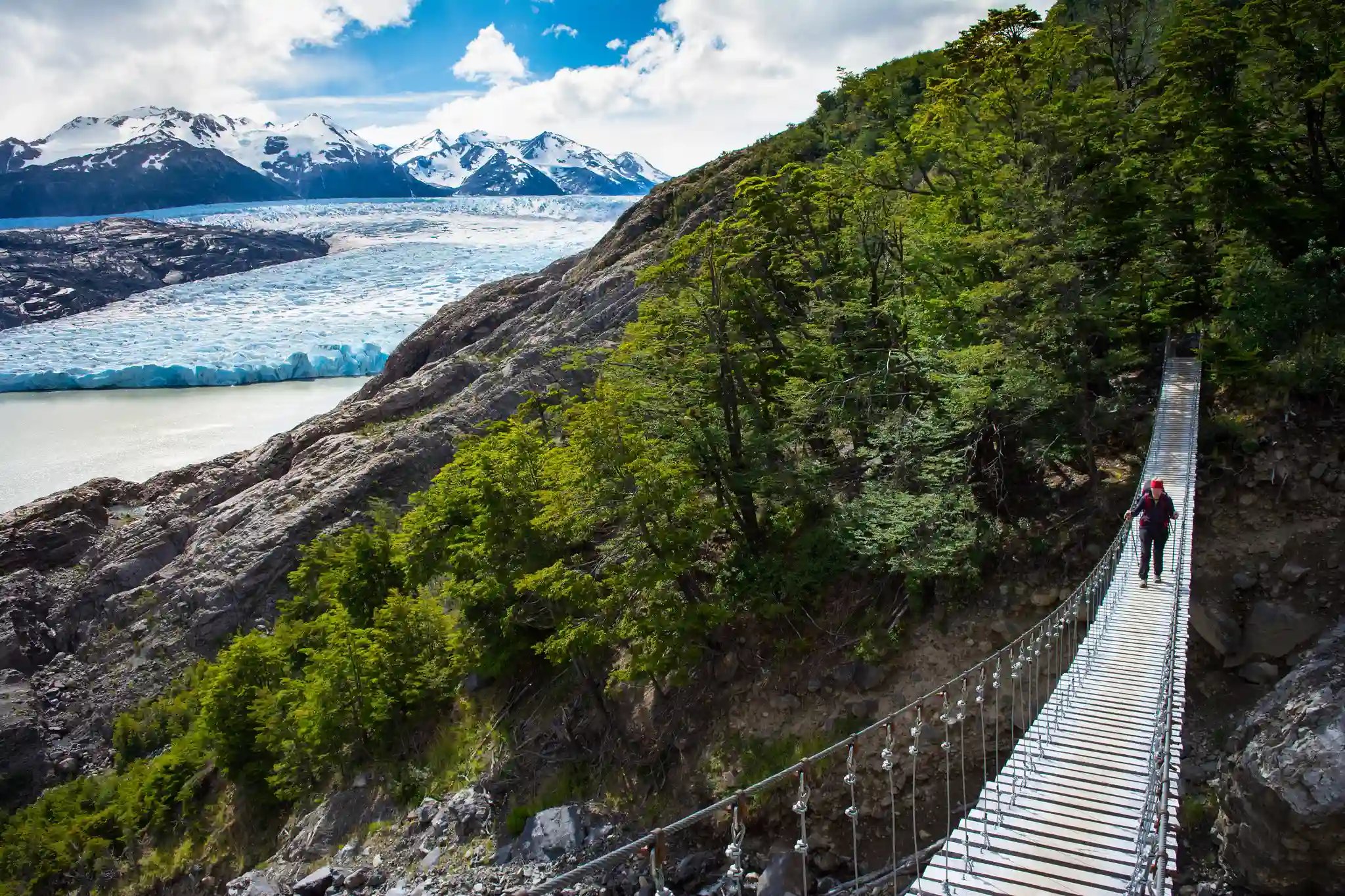
We could write an entire book featuring Chile’s best places to visit . But if we had to sum it up, we would start with the Atacama Desert in the north, the world’s most arid desert. It stretches over 1000 kilometers of the Pacific coast to the border with Bolivia and Peru, offering a spectacular natural scenery. Here you’ll see the clearest sky on Earth, the incredible Tatio geysers and colorful lagoons above 3000 meters.
Further south, you should consider a trip to Valparaíso , Chile’s colorful port that is full of history. Santiago de Chile is worth a visit, with its vibrant streets, fascinating museums and delicious restaurants. Close to the country’s Metropolitan region, you could also go for some wine tasting in the beautiful wine valleys.
Another highlight is the Lake District , with its snowcapped volcanoes, German influence and vast lakes. Heading south you’ll reach Patagonia, with the stunning national parks of Chile’s Aysen Region. Here you can do the best road trip in South America while driving through the Carretera Austral, and do a hike of a lifetime through the Cerro Castillo National Park .
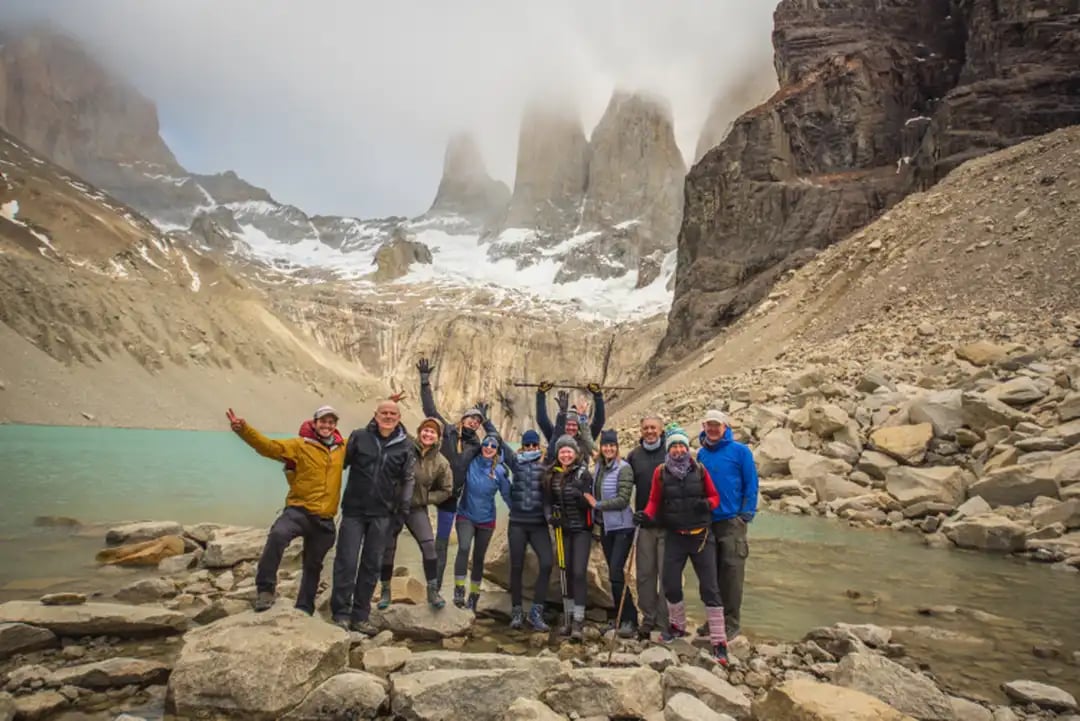
But the crown jewel of Patagonia is definitely Torres del Paine National Park , with its mesmerizing granite spires, abundant wildlife and spectacular hiking trails. You can stay at EcoCamp Patagonia , the world’s first geodesic hotel, to make your stay in Chile’s finest national park even better!
Another great place to hike is the Navarino island , home to the southernmost trek on Earth, “los dientes de Navarino”.
And we can’t talk about Chile without mentioning Easter Island (Rapa Nui), with its 1,000 monumental Moai statues in the heart of the Pacific Ocean.
_resultado.webp?width=1080&name=Cerro%20Castillo%20Trek%20-%20Carretera%20Austral%20(3)_resultado.webp)
Ready for your trip to Chile? Take a look at our adventures or contact us to make your dream adventure come true!
Subscribe to our Newsletter
Related posts.
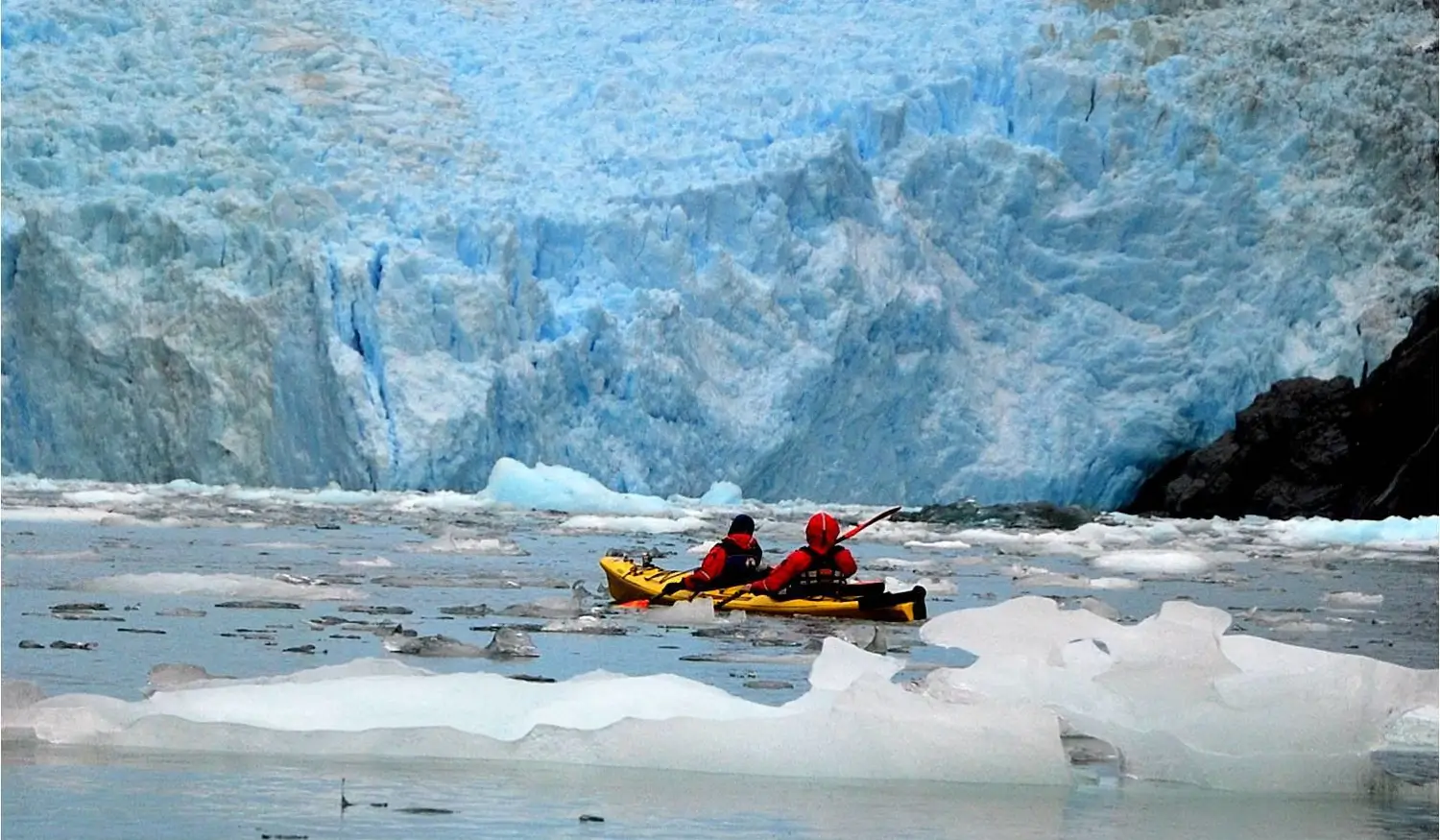
Patagonia's glaciers: worth a visit
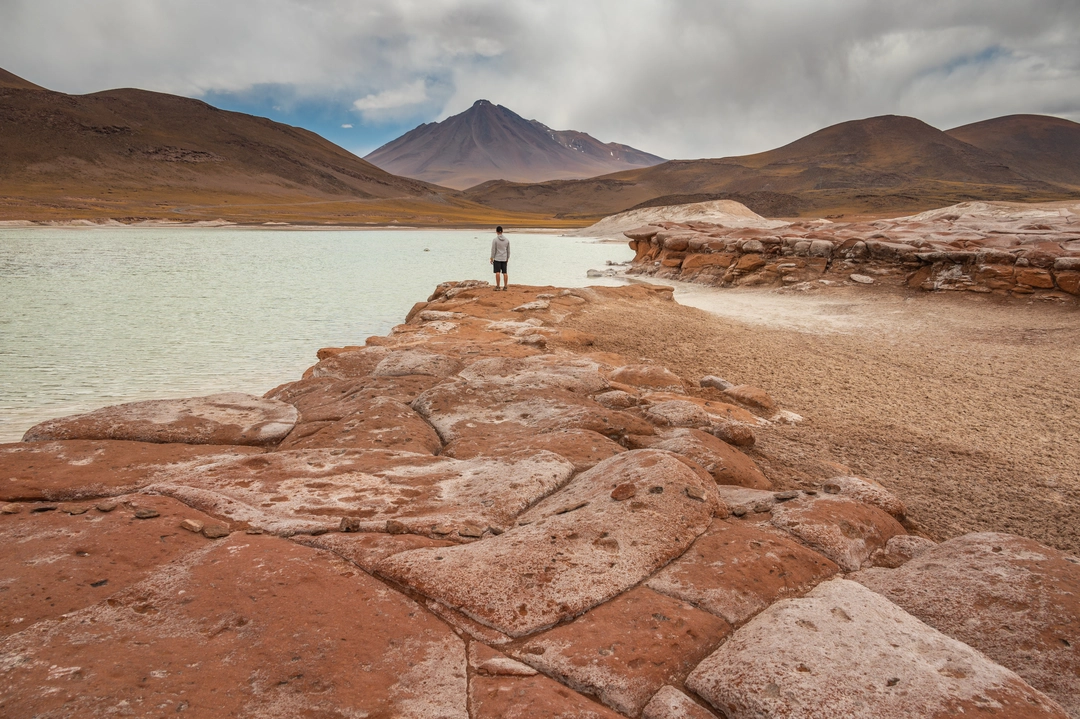
The Best Destinations in Chile for Adventure Travelers
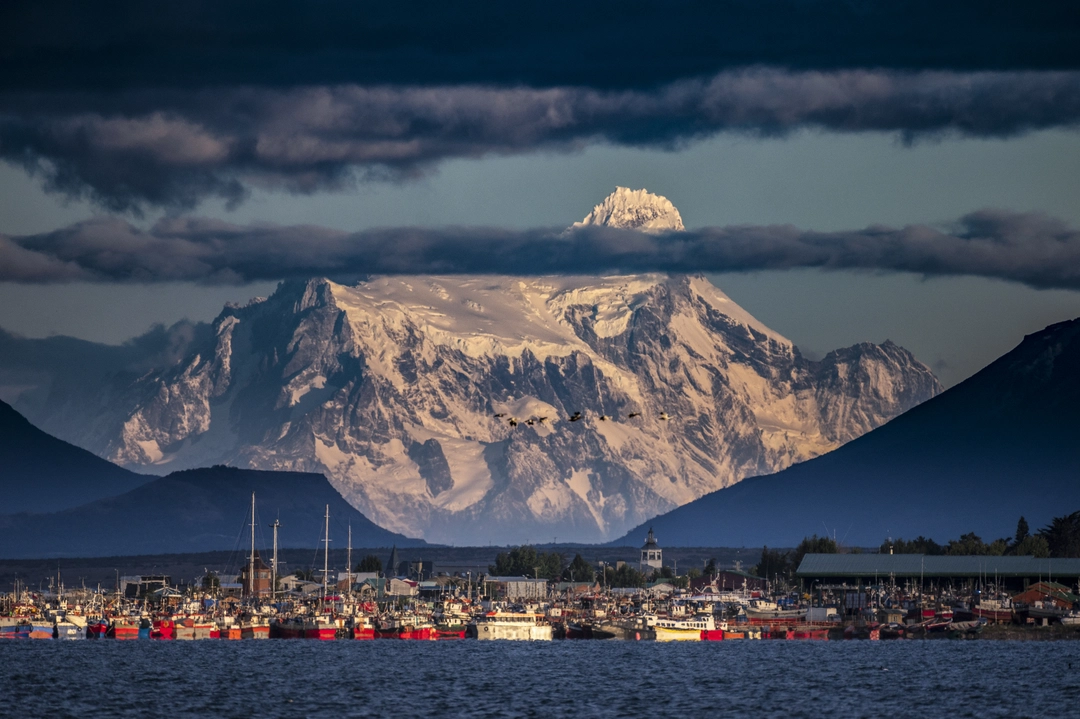
8 Things You Didn't Know About Patagonia

The Chilean Way
Want to learn more about the beautiful country of Chile? Download our insider’s guide to learn all the best travel tips and tricks.

- TERMS & CONDITIONS
- PRIVACY POLICY
Destination
- Multi Destination
- Salta Argentina
Experiences
- Multi-activity
- Exceptional Journeys
SOCIAL NETWORKS

Updated October 4th, 2022
Dear Traveler,
We are very happy to announce that there are currently no travel restrictions in Chile. Together with the above mentioned, it is mandatory to comply with the following requirements:
- You only have to present the vaccination certificate issued in your country when boarding to Chile. Those who do not have their vaccinations must present a negative result in a PCR test dated less than 48 hours from departure to enter Chile. Those who are under 18 years of age do not have any requirements to enter Chile
- A negative PCR upon arrival is not compulsory any more but diagnostic tests will be carried out randomly at the entry point to Chile. Confirmed cases shall be isolated according to the general health regulations.
- Medical insurance covering any expenses caused by COVID-19 is not compulsory any more
- The use of a face mask is voluntary
In case you have any questions, we will be happy to help you!
The Team at Cascada Expediciones & EcoCamp Patagonia
- Travel Planning Guide
A Travel Price Comparison for Families, Couples, and Backpackers Santiago vs. Lima for Vacations, Tours, and Honeymoons

- Which is Cheaper, Santiago or Lima? (Travel Cost Comparison)
Which is Bigger, Santiago or Lima?
- When to Visit Santiago or Lima?
Should you visit Santiago or Lima?
Which is cheaper to visit which is more expensive for vacation.
Which city should you visit? Read on to compare the activities as well as the prices of travel for Santiago and Lima. We'll break down costs for accommodation, food, transportation and more to help you learn more about these two destinations. Then, you can figure out if either of these two places are accessible based on your travel budget, schedule, and interests. So, let's dig into it.
Where Should I go: Santiago or Lima?
Santiago is the capital city of Chile. It is centrally located in the long and narrow country, making it a good jumping off point to explore everywhere else. It's convenient location means that you can go skiing in the Andes one day, and hang out at the beach the next. Santiago has a cool semi-arid climate that is similar to Mediterranean climates. The summers, which are between November and March, are warm and dry. The temperatures climb to around 95 degrees Fahrenheit. The winters, between June and August, are humid with cold mornings. The daily highs are around 55 degrees Fahrenheit and the lows stay a few degrees above freezing. Rain is more common in the winter months and the dry season is between December and March.
Lima, the capital city of Peru, is likely to be your point of entry for the country. Lima was founded in 1535 and was the seat of the Spanish rule for 300 years. It's a surprisingly modern city despite its rich history, but many beautiful churches and colonial architecture remain today. There are also large slum areas that highlight the poverty that exists in the city. The city and its surrounding metropolitan area have a population of about 8.5 million people, many of whom came from the Andes Mountains in search of work. Unfortunately the work opportunities are limited and the poverty is obvious as you arrive in Lima.
For some great organized tour ideas, see The Best One Week (7-Day) Tours in Chile , The Best 2-Week Tours in Chile , Tours for Outdoor and Nature Lovers in Peru , and The Best Adventure Tours to Peru .
Which place is cheaper, Lima or Santiago?
These are the overall average travel costs for the two destinations.
- Santiago Prices Chile Prices Lima Prices Peru Prices
- Average Daily Cost Per person, per day Santiago $ 143 Lima $ 76
The average daily cost (per person) in Santiago is $143, while the average daily cost in Lima is $76. These costs include accommodation (assuming double occupancy, so the traveler is sharing the room), food, transportation, and entertainment. While every person is different, these costs are an average of past travelers in each destination. What follows is a categorical breakdown of travel costs for Santiago and Lima in more detail.
Accommodation
- Accommodation Hotel or hostel for one person Santiago $ 111 Lima $ 49
- Accommodation Typical double-occupancy room Santiago $ 222 Lima $ 98
Compare Hotels in Santiago and Lima
Looking for a hotel in Santiago or Lima? Prices vary by location, date, season, and the level of luxury. See below for options and compare which is best for your budget and travel style.
Hotels in Santiago
Hotels in Lima
Kayak helps you find the best prices for hotels, flights, and rental cars for destinations around the world. Compare prices for multiple destinations when planning your next trip.
Local Transportation
- Local Transportation Taxis, local buses, subway, etc. Santiago $ 5.48 Lima $ 5.67
Typical Local Transportation Prices in Santiago
Below are a few samples from actual travelers for transportation costs in Santiago:
- Metro Ride $ 1.15
Hired Cars and Shuttles in Santiago
Some specific examples of transportation prices in Santiago:
- Arturo Merino Benítez Intl Airport: Shared Transfer: $24
- Private Departure Transfer from Santiago- Santiago Airport (SCL): $27
- Private Transfer From The Hotel in Santiago City To the Airport: $29
- Departure Transfer - Hotel in Santiago to Santiago International Airport: $35
- Private Santiago Airport to Santiago Transfer: $35
- From Farellones Roundtrip Transfer: $35
- Arrival Transfer - Santiago International Airport to Hotel in Santiago: $35
- Valle Nevado Ski Day Trip with Hotel Transfers: $39
- Private Transfer between Santiago and the Airport: $51
- Airport transfer between Santiago city center and Arturo Merino Benítez Airport: $51
- Transfer Privado Entre Santiago Y El Aeropuerto: $52
- Transfer from Santiago Airport to Santiago Centro Commune: $52
Typical Local Transportation Prices in Lima
Some typical examples of transportation costs in Lima are as follows:
- Taxi Ride $ 5.37
- Short Taxi Ride $ 4.03
Hired Cars and Shuttles in Lima
Some specific examples of transportation prices in Lima:
- QuickLlama: Transfer from Miraflores Kennedy Park to Lima Airport: $5.00
- QuickLlama: Door-to-door transfer from Lima Airport to Miraflores: $5.00
- QuickLlama: Door-to-door transfer from Miraflores to Lima Airport: $5.00
- Lima Airport: Bus Transfer to/from Miraflores: $5.63
- Lima Airport: BUS Transfer to/from Lima city center: $6.00
- Private Transfer from Jorge Chavez Airport to Hotels in Lima: $13
- LIMA AIRPORT SHUTTLE - Shared Transfer: $13
- Private transfers from Lima Airport or to Lima Airport: $17
- Transfer from Hotel/Airbnb Miraflores/San Isidro/Barranco to Airport: $18
- Transfer from Lima city to the airport: $18
- Taxi transfers from and to the Lima Airport and Paracas Ica: $20
- Private Transfer from Lima Airport to Hotel by Aludy Travel: $20
Is it cheaper to fly into Santiago or Lima?
Prices for flights to both Lima and Santiago change regularly based on dates and travel demand. We suggest you find the best prices for your next trip on Kayak, because you can compare the cost of flights across multiple airlines for your prefered dates.
- Food Meals for one day Santiago $ 13 Lima $ 17
Typical Food Prices in Santiago
Some typical examples of dining costs in Santiago are as follows:
- Empanada $ 1.91
- Hamburger $ 2.54
- Dinner $ 26
Food Tours and Cooking Classes in Santiago
Also, here are some specific examples of food and dining related activities in Santiago.
- Traditional Chilean Show with Dinner and Private Transportation in Santiago: $107
- Traditional Dinner Show in Santiago: $107
- Dinner Show in Bali Hai: $109
- Sunset at Alyan Family Wines Winery with Dinner: $116
- Private Market Tour and Traditional Chilean Cooking Class in a Local Home: $117
- Small-Group Night City Tour: San Cristobal Hill and Dinner Show: $120
- 4-Hour Private Night Tour with Dinner and Show: $150
- Private Dinner and Show with Transfers: $158
- Traditional Chilean Cooking Class with a Local in Her Santiago Countryside Home: $168
Typical Food Prices in Lima
Some typical examples of dining costs in Lima are as follows:
- Lunch for Two $ 4.30
- Ice cream $ 3.49
- Coffee $ 2.95
- Donut $ 0.94
Food Tours and Cooking Classes in Lima
Also, here are some specific examples of food and dining related activities in Lima.
- Lima Market Food Tour: $33
- Lima Market Food Tour: $34
- Peruvian Food Tour Through Local Markets: $40
- Ceviche Cooking Class Including Pisco Sour Lesson: $40
- Lima Street Food Tour: $40
- Lima Street Food Tour: $45
- Lima Food Tour: $45
- Street Food Tour in Miraflores District: $45
- Cooking Workshop and Water Circuit Tour: $45
- Barranco Tour with Dinner: $47
- Bohemian tour of Barranco with Dinner: $47
- Private Cooking Class With a Local Family in Lima: $48
Entertainment
- Entertainment Entrance tickets, shows, etc. Santiago $ 48 Lima $ 8.57
Tours and Activities in Santiago
Some specific costs of activities, tours, and entrance tickets for Santiago are as follows:
- Explore Santiago's Soul: Walking In-App Audio Tour: $5.00
- Santiago Cathedral's Bell Tower Official Tour: $9.00
- La Paz from the Heights: Down hill Walking tour & Cable Cars: $12
- Cable Car Admission Ticket: $15
- Cousiño Macul Official Winery Tour with Tasting: $23
- Skip the Line: Concha y Toro Traditional Tour Ticket: $25
- Walking tour through Santiago: $26
- From Valle Nevado and Farellones Small Group Tour: $29
- The Essentials City Tour & Optional Concha y Toro: $30
- Half Day tradicional city Tour: $30
- TOUR PANORAMICO VALLE NEVADO Y FARELLONES: $32
Typical Entertainment Prices in Lima
Some typical examples of activities, tours, and entrance ticket prices in Lima are as follows:
- Entrance to Museo Larco (for 2) $ 16
- Movie Tickets $ 2.28
Tours and Activities in Lima
Some specific costs of activities, tours, and entrance tickets for Lima are as follows:
- Free Walking Tour of Lima: $2.00
- Peru's Best Bike Experience since 2014 - 4 Hours Hire: $9.90
- Customize your trip to Peru with Lima Experience: $12
- bike tour: $12
- Skip the Line: Larco Museum Admission Ticket: $13
- Beach tour and surfboards for rent in Lima, Peru: $14
- Barranco Street Art Tour: $17
- Party tour Fridays Barranco / Saturdays Miraflores: $18
- Private Beach Guided Bike Tour in Lima : $19
- Private Tour with guide in Museo de Arte de Lima - MALI: $20
- Guided Walking Tour in Barranco: $20
- Lima Downtown Tour from Miraflores in 3 hrs: $21
- Alcohol Drinks for one day Santiago $ 8.51 Lima $ 5.57
Sample the Local Flavors in Santiago
Also in Santiago, these are the prices for nightlife and alcohol related activities from various tour providers:
- Premium Wine Tour in Viña Cousiño Macul Spanish official: $37
- Concha y Toro Ticket and Tour with Wine Tasting: $50
- Undurraga Winery Tour with Entry and Wine Tasting: $50
- Undurraga Wine tour: $63
- Half Day Trip to Undurraga Vineyard from Santiago - Wine Tasting Included: $70
- Private Tour: Santa Rita Vineyard with Wine Tastings: $72
- From Concha y Toro Marqués Half-Day Wine Tasting: $89
- half day wine tour to concha y toro from Santiago seasonal offer: $95
- From Maipo Valley Wine Tour: $99
- Maipo Valley Wine Tour with 4 vineyards from Santiago.: $99
- Private Tour: Viña del Mar and Valparaíso Tour with Wine Tasting in Casablanca Valley: $143
- Colchagua Premium Wine Tour from Santiago: $145
Typical Alcohol Prices in Lima
Some typical examples of the costs for nightlife and alcohol in Lima are as follows:
- Bottle of Wine $ 7.23
- Beer $ 4.03
- Cocktail $ 3.22
Sample the Local Flavors in Lima
Some specific costs for nightlife related activities in Lima:
- Gin and Rum Distillery Tour: $12
- Lima Pub Crawl - Party tour: Friday Barranco/Saturday miraflores: $18
- Exclusive Pub Crawl with 10+ benefits: $18
- Party Tour in Miraflores with Bar Crawl and Drinks: $18
- Pub Crawl in Lima: $25
- Local Wine Tour : $39
- Local Wine Tour: $50
When we compare the travel costs of actual travelers between Santiago and Lima, we can see that Santiago is more expensive. And not only is Lima much less expensive, but it is actually a significantly cheaper destination. So, traveling to Lima would let you spend less money overall. Or, you could decide to spend more money in Lima and be able to afford a more luxurious travel style by staying in nicer hotels, eating at more expensive restaurants, taking tours, and experiencing more activities. The same level of travel in Santiago would naturally cost you much more money, so you would probably want to keep your budget a little tighter in Santiago than you might in Lima.
If you're trying to decide if either of these two destinations are within your price range, also see Is Santiago Expensive? and Is Lima Expensive? .
Lima has a larger population, and is about 60% larger than the population of Santiago. When comparing the sizes of Santiago and Lima, keep in mind that a larger population does not always imply the destination has more attractions or better activities. So, always research the type of place that you want to visit along with the activities and attractions that interest you.
When is the best time to visit Santiago or Lima?
Santiago has a temperate climate with four distinct seasons, but Lima experiences a warm climate with fairly sunny weather most of the year.
Should I visit Santiago or Lima in the Summer?
Both Lima and Santiago are popular destinations to visit in the summer with plenty of activities. Plenty of visitors come to Lima because of the warm climate and sunshine that lasts throughout the year.
In January, Santiago is generally a little warmer than Limain July. Daily temperatures in Santiago average around 21°C (70°F), and Lima fluctuates around 18°C (64°F).
In January, Santiago usually receives less rain than Limain July. Santiago gets 10 mm (0.4 in) of rain, while Lima receives 12 mm (0.5 in) of rain each month for the summer.
- Summer Average Temperatures January and July Santiago 21°C (70°F) Lima 18°C (64°F)
Should I visit Santiago or Lima in the Autumn?
Both Lima and Santiago during the autumn are popular places to visit. Warm weather and sunshine bring visitors to Lima year-round.
Santiago is cooler than Lima in the autumn. The daily temperature in Santiago averages around 15°C (59°F) in April, and Lima fluctuates around 19°C (66°F)in October.
Santiago usually gets more rain in April than Limain October. Santiago gets 10 mm (0.4 in) of rain, while Lima receives 7 mm (0.3 in) of rain this time of the year.
- Autumn Average Temperatures April and October Santiago 15°C (59°F) Lima 19°C (66°F)
Should I visit Santiago or Lima in the Winter?
The winter attracts plenty of travelers to both Santiago and Lima. Lima attracts visitors year-round for its warm weather and sunny climate.
In the winter, Santiago is much colder than Lima. Typically, the winter temperatures in Santiago in July average around 9°C (48°F), and Lima averages at about 23°C (73°F)in January.
In July, Santiago usually receives more rain than Limain January. Santiago gets 80 mm (3.1 in) of rain, while Lima receives 4 mm (0.2 in) of rain each month for the winter.
- Winter Average Temperatures July and January Santiago 9°C (48°F) Lima 23°C (73°F)
Should I visit Santiago or Lima in the Spring?
The spring brings many poeple to Santiago as well as Lima. The warm climate attracts visitors to Lima throughout the year.
In October, Santiago is generally cooler than Limain April. Daily temperatures in Santiago average around 15°C (59°F), and Lima fluctuates around 22°C (72°F).
Santiago usually gets more rain in October than Limain April. Santiago gets 10 mm (0.4 in) of rain, while Lima receives 2 mm (0.1 in) of rain this time of the year.
- Spring Average Temperatures October and April Santiago 15°C (59°F) Lima 22°C (72°F)
Typical Weather for Lima and Santiago
Related articles for santiago, related articles for lima.

Subscribe to our Newsletter
By signing up for our email newsletter, you will receive occasional updates from us with sales and discounts from major travel companies , plus tips and advice from experienced budget travelers!
Some of the links on this website are sponsored or affiliate links which help to financially support this site. By clicking the link and making a purchase, we may receive a small commission, but this does not affect the price of your purchase.
- Privacy / Terms of Use
- Activities, Day Trips, Things To Do, and Excursions

IMAGES
VIDEO
COMMENTS
Is Santiago expensive to visit? Prices in Santiago are reasonable and comparable to your average travel destination. Hotels, food, and sightseeing are generally within normal price ranges. Within South America, Santiago is a very expensive destination compared to other places. It is in the top 10% of cities in South America for its travel costs.
Bus from La Serena to Valparaiso: 9,000 CLP / $12 per person. Return local (micro) bus from Valparaiso to Viña del Mar: 1,500 CLP / $2 per person. Bus from Valparaiso to Santiago: 2,250 CLP / $3 per person. OUR TOTAL COST OF TRANSPORTATION IN CHILE CAME TO $107.34. THAT'S AN AVERAGE OF $8.26 PER DAY, OR $4.15 EACH.
My research on cost of living by city puts the monthly cost of living in Santiago for an ex-pat at $1, 947 per month, and estimates monthly cost of living for nomads and slow travelers passing through at $2,433 to $2,920 per month. My budget and spending experience in Santiago, Chile.
2.44 - 3.93. Budget lunch. Local dishes like stews or chicken and rice are fairly cheap. International dishes cost quite a bit more. 3.08 - 5.31. Budget dinner. Again, these prices are for the hearty food the locals eat, rather than fancier places with English-language menus. 5.09 - 7.96. Beer (liter)
Luxury Couple's Trip. The high-end price for a couple to visit Santiago for a week is $3,900-$14,120 ($557-$2,017 per day) Food, Travel, and Sightseeing: $114 to $286 per day for two people's daily expenses. Flights: $2,370 to $7,366 for first class. Lodging: $122 to $173 per night for one 4 or 5-star hotel room.
Here are the best reasons to visit Santiago and its beautiful surrounding landscapes. ... Another great reason to visit Santiago is the fantastic wine! Chile is known for its wine and Santiago is the country's best destination to enjoy it. ... Is Santiago an expensive city? Santiago is one of the most expensive city's in South America ...
9. Santiago is a walkable city. Because Santiago is located on a plateau, the city is remarkably flat. Not only that; pedestrian infrastructure is good, and several streets near the Plaza de Armas are car-free, making walking around the city center a pleasant experience.
Best Times To Visit Santiago. The best time to visit Santiago is from September to November or from March to May; these months mark the spring and fall shoulder seasons in Chile. Although the city ...
The best times to visit Santiago, Chile, are spring (September to November) and fall (March to May). During these periods, the weather is mild with average highs in the mid-70s to low 80s, ideal for exploring the city, taking day trips to nature, and enjoying cultural events, including wine festivals and Fiestas Patrias, Chile's national holiday.
Cost: $7.50. Hours: Mon: 1pm-6:45pm, Tues-Sun: 10am-6:45pm. Start your first of two days in Santiago with a visit to San Cristobal Hill. San Cristobal Hill offers the best and most panoramic views of Santiago. Buy your ticket ahead of time to save time as the line can get very long.
Chile can be an expensive place to visit, especially if you're doing a lot of tours and activities. The size of the country also means you can end up spending a lot on transportation. Here are some tips to help you save during your visit: ... From Santiago to Valparaiso, bus tickets cost around 6,000-10,000 CLP each way. For something like ...
Santiago, Chile is worth visiting for many more reasons than one. The Chilean capital is a melting hotpot of culture, and is usually the first point of entry for many travelers heading to this South American nation.. Here we can explore the cultural highlights, visit many unique museums as well as get some awesome Andean mountain vistas.
For the best views, walk all the way up to the Terraza Caupolicán, a hilltop terrace with buskers, benches and public art. A hilltop park on the eastern edge of downtown Santiago, Santa Lucía ...
Day 1: Santiago. Wake up in the heart of this bustling metropolis in one of Santiago's chic hotels, enjoy a leisurely breakfast before embarking on a walking tour. Begin with the Presidential Palace of La Moneda, before heading to Plaza de Armas and Mercado Central. Gaze at the art in the Museo Chileno de Arte Precolombino and the Museo de ...
Let's boil it down to 15 reasons why Santiago is worth your visit to Chile. And to make it fair, we also discuss the reasons why people think it's not worth it, to give you a better way to decide. Related Travel Guides . How To Get From Santiago Airport to City Center Best Way; 11 Best Traditional Breakfast in Chile; 4 Days in Santiago de Chile
People drink in El Bajo, a plant-filled mezzanine bar under the GAM, a distinctive arts center that hosts exhibitions, book fairs and live events. Saturday. 10 a.m. Trace the scars of a violent ...
Chile was the most expensive country of our trip, with daily living costs of $76.65. This is almost double our daily costs in the cheapest country we visited, Paraguay. Note that even if we remove the W Trek costs from our daily spending in Chile and recalculate, it still remains the highest at $73.49 per day.
Chile is amongst the safest countries on Earth. 2. Chile is more expensive than its neighbors, but incredibly rewarding. 3. Chile is COVID-19 vaccination champion in South America. 4. If you plan an adventure in Chile, you may have to train first. 5. The best time to travel to Chile is not always when you think.
The same level of travel in Santiago would naturally cost you much more money, so you would probably want to keep your budget a little tighter in Santiago than you might in Lima. ... and Groups in Santiago, Chile Quiet, Safe, and Affordable Hostels in Santiago, Chile Valparaiso Temuco Iquique Arica. Related Articles for Lima. The Best Party ...